Preston Singletary
Preston Singletary is a Tlingit glass artist. Singletary transfers Tlingit designs, traditionally carved in wood, onto glass. He studied at the Pilchuck Glass School in Stanwood, Washington.
Light is integral to his work, and he uses it to add dimension to the glass and his design. His work is in the collections of the Corning Museum of Glass, the Heard Museum, the Museum of Fine Arts, and Seattle Art Museum.
Preston Singletary is featured in the NATURE episode and included in the Pilchuck Glass School segment of the COMMUNITY episode as well as the Marioni segment of the FAMILY episode.
Russell Johnson photographs
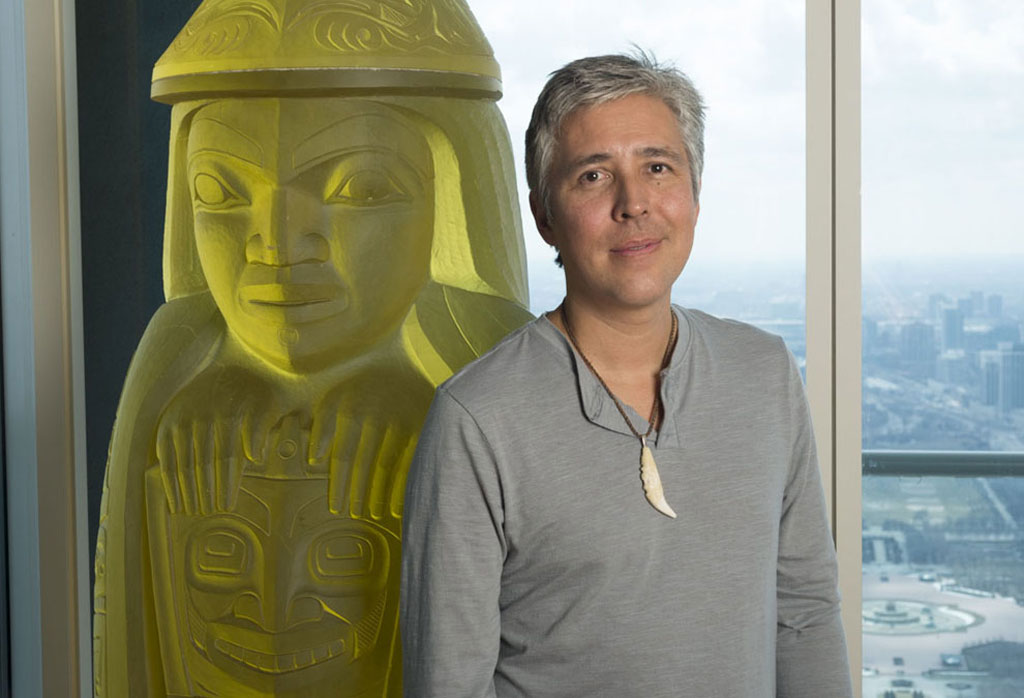
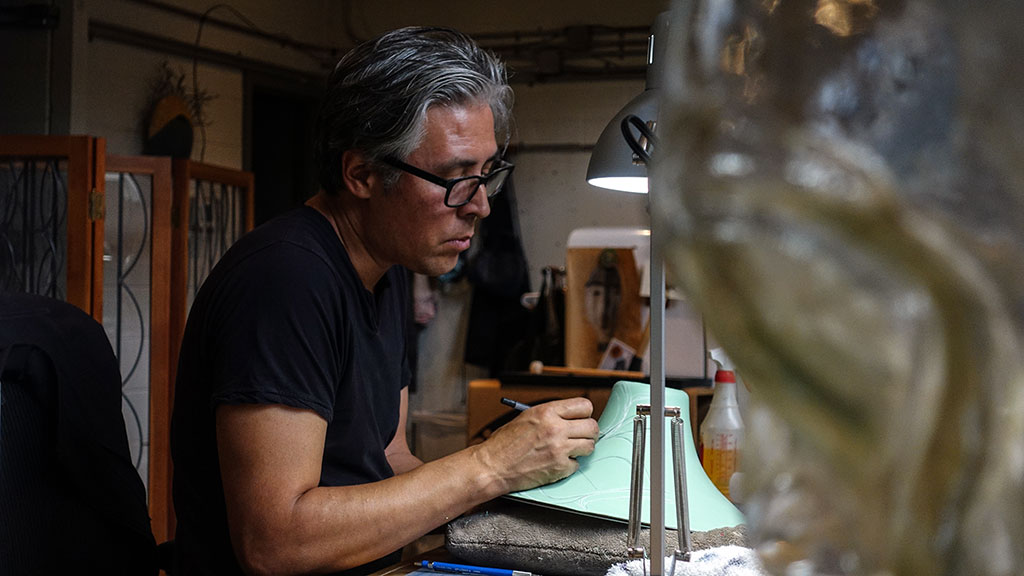
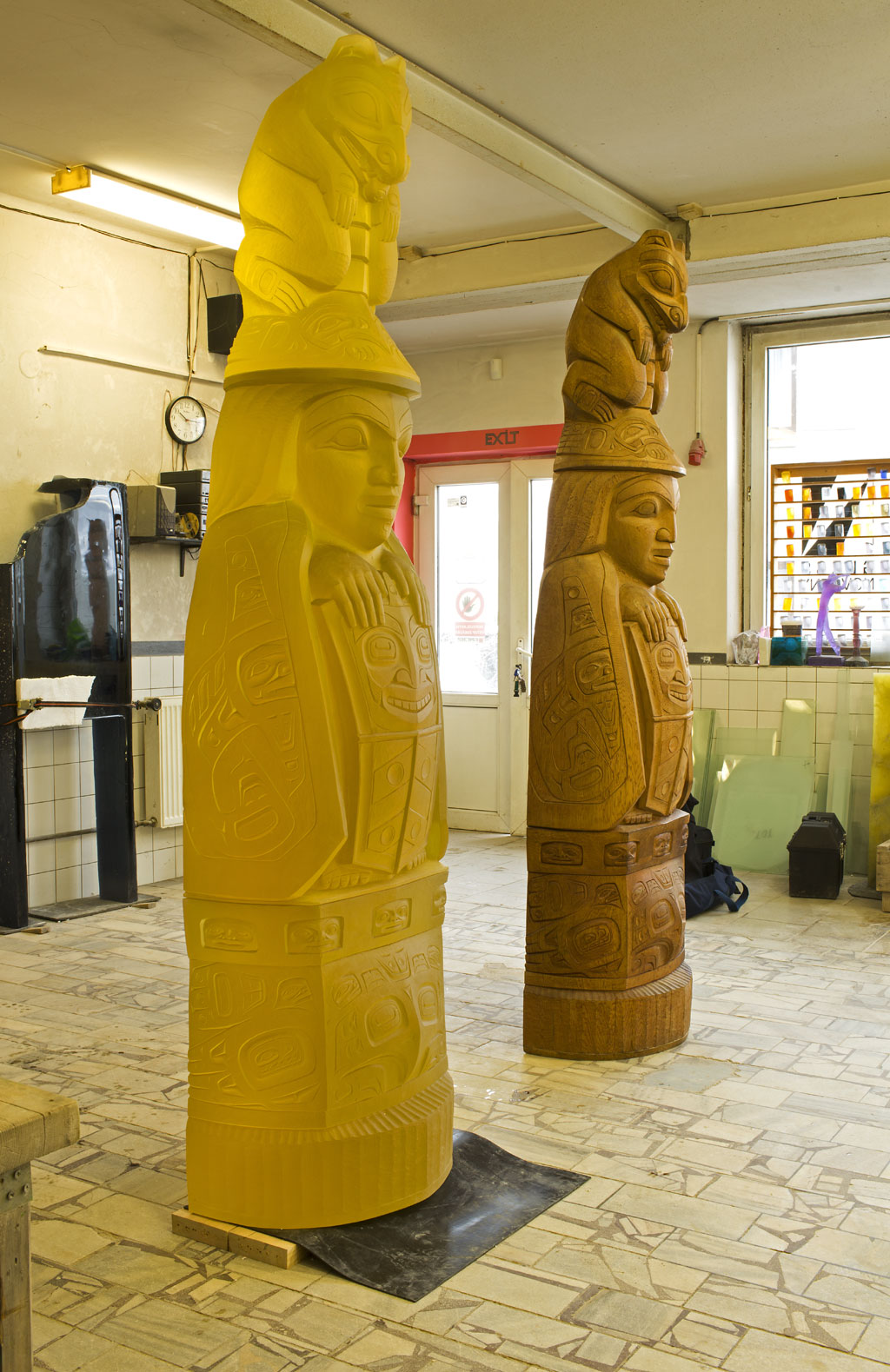
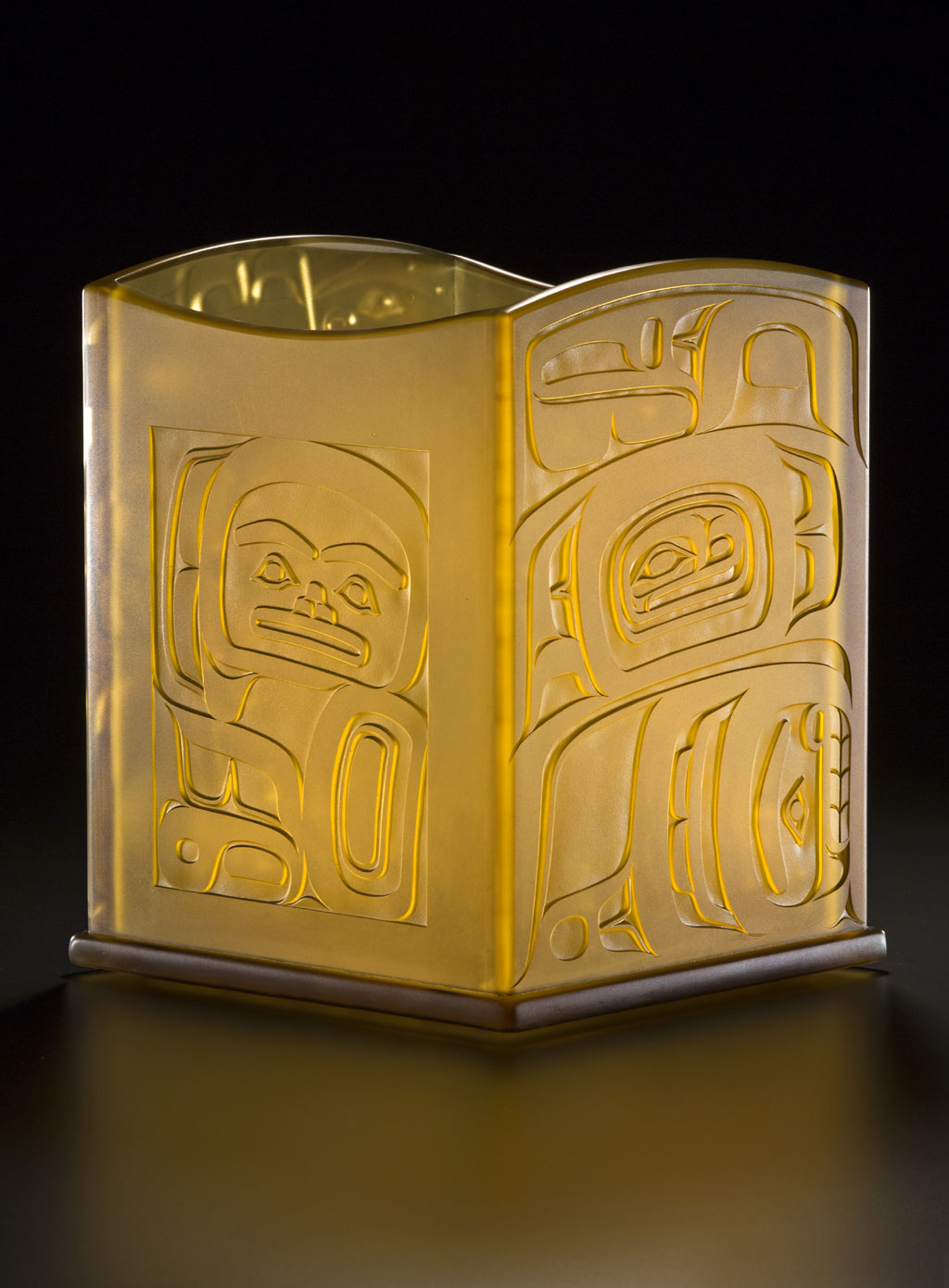
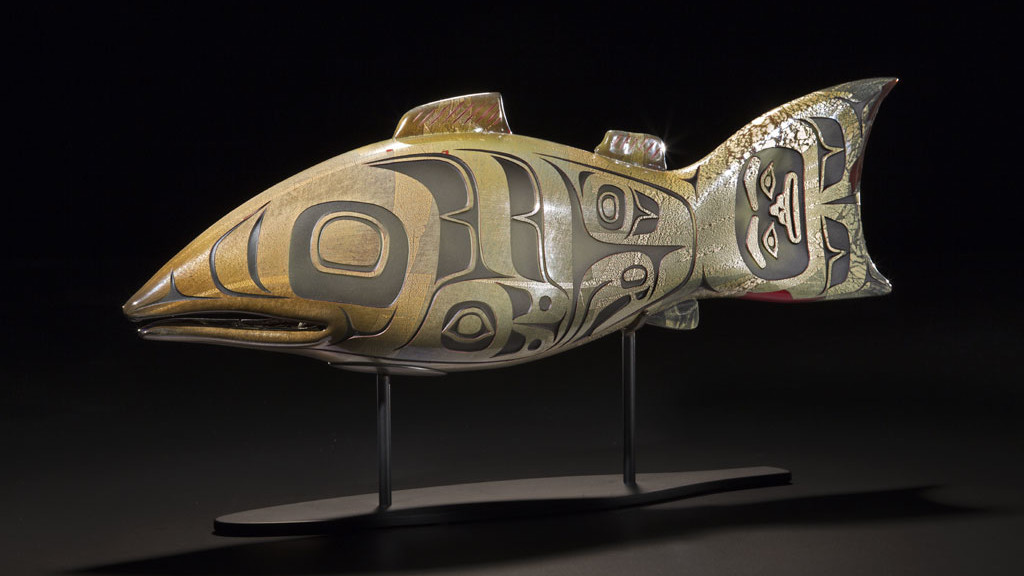
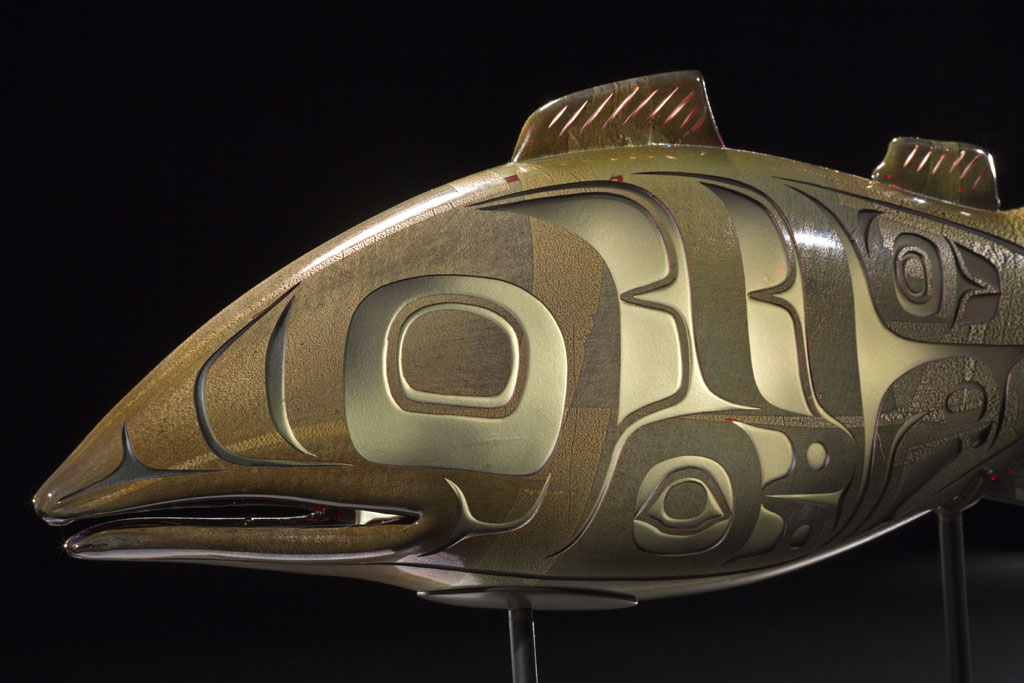
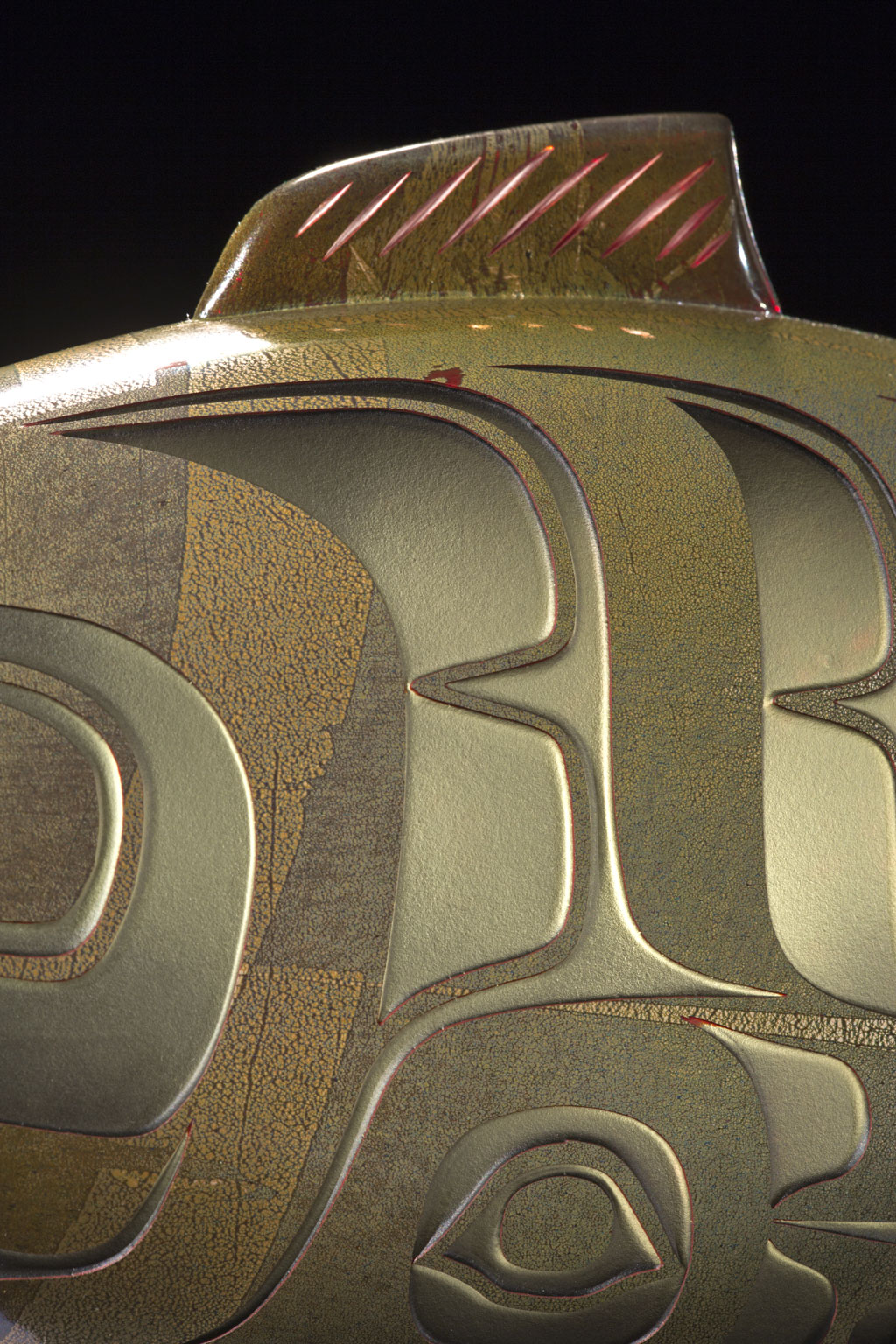
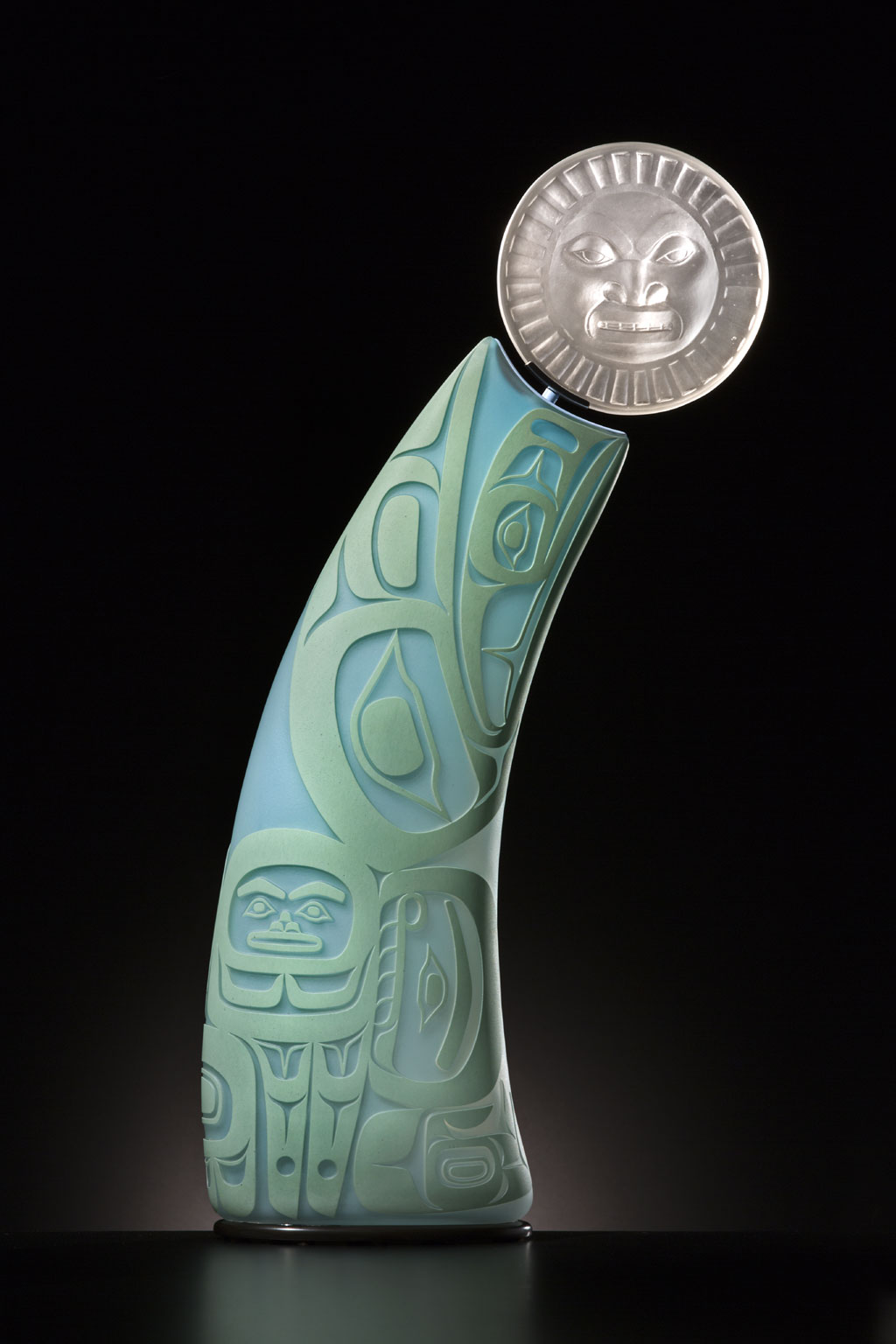
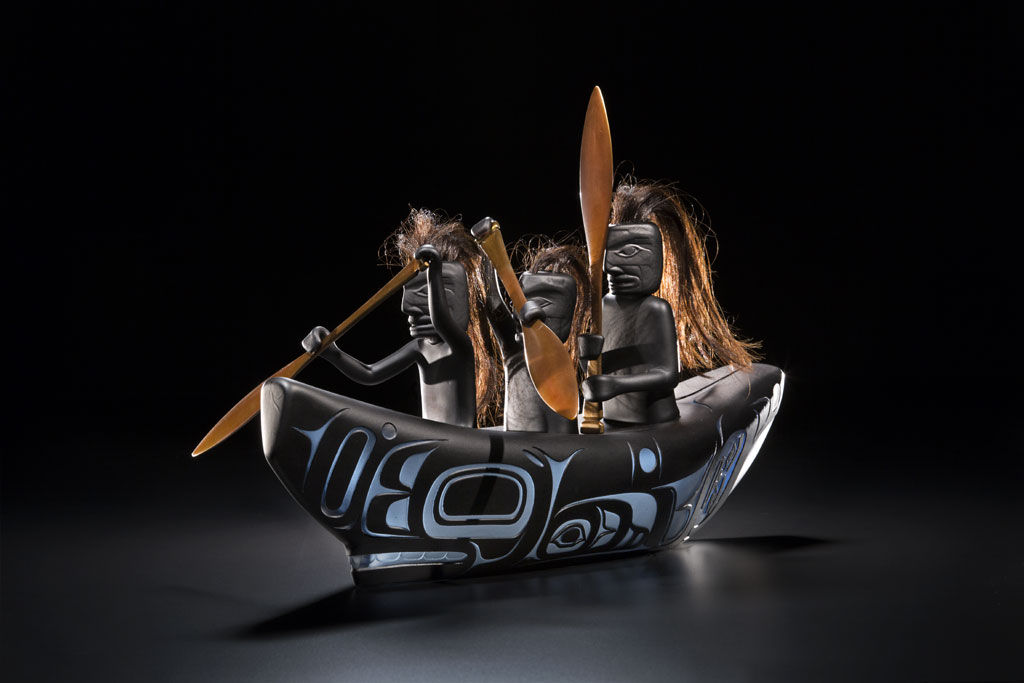
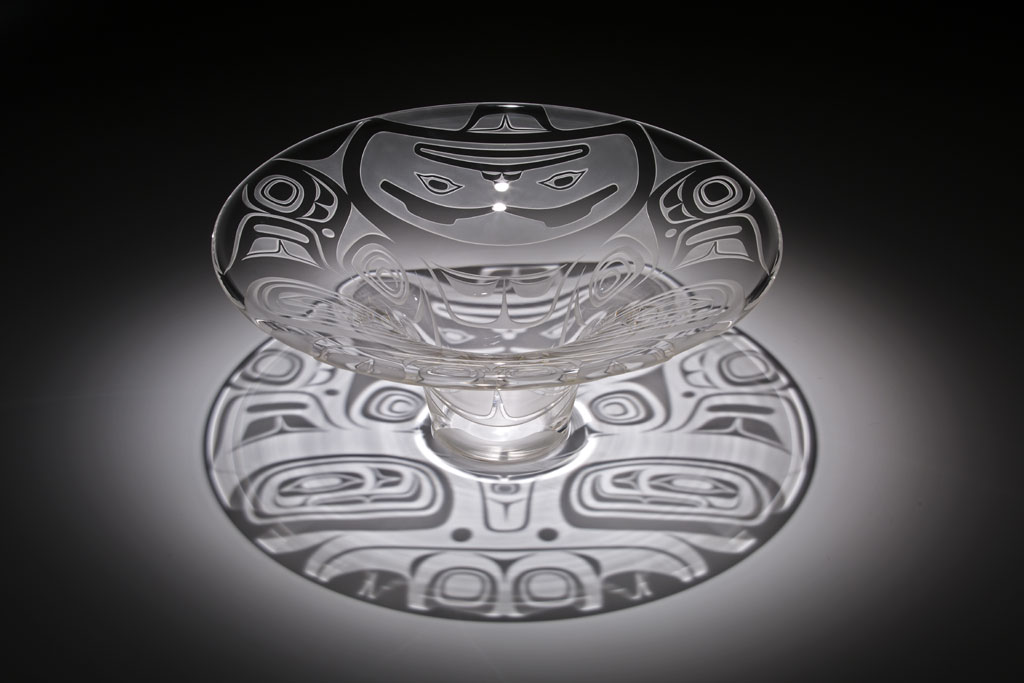
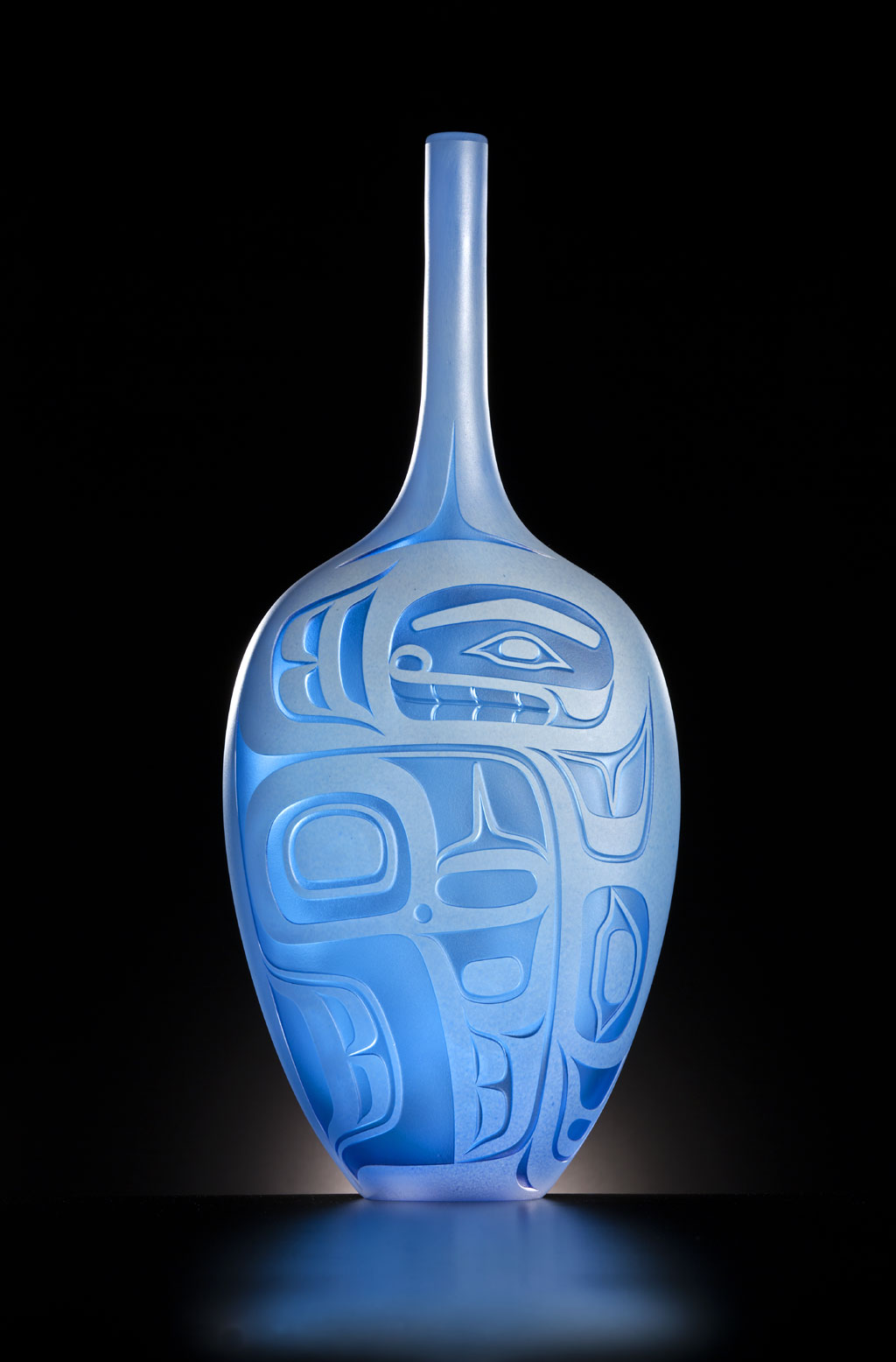
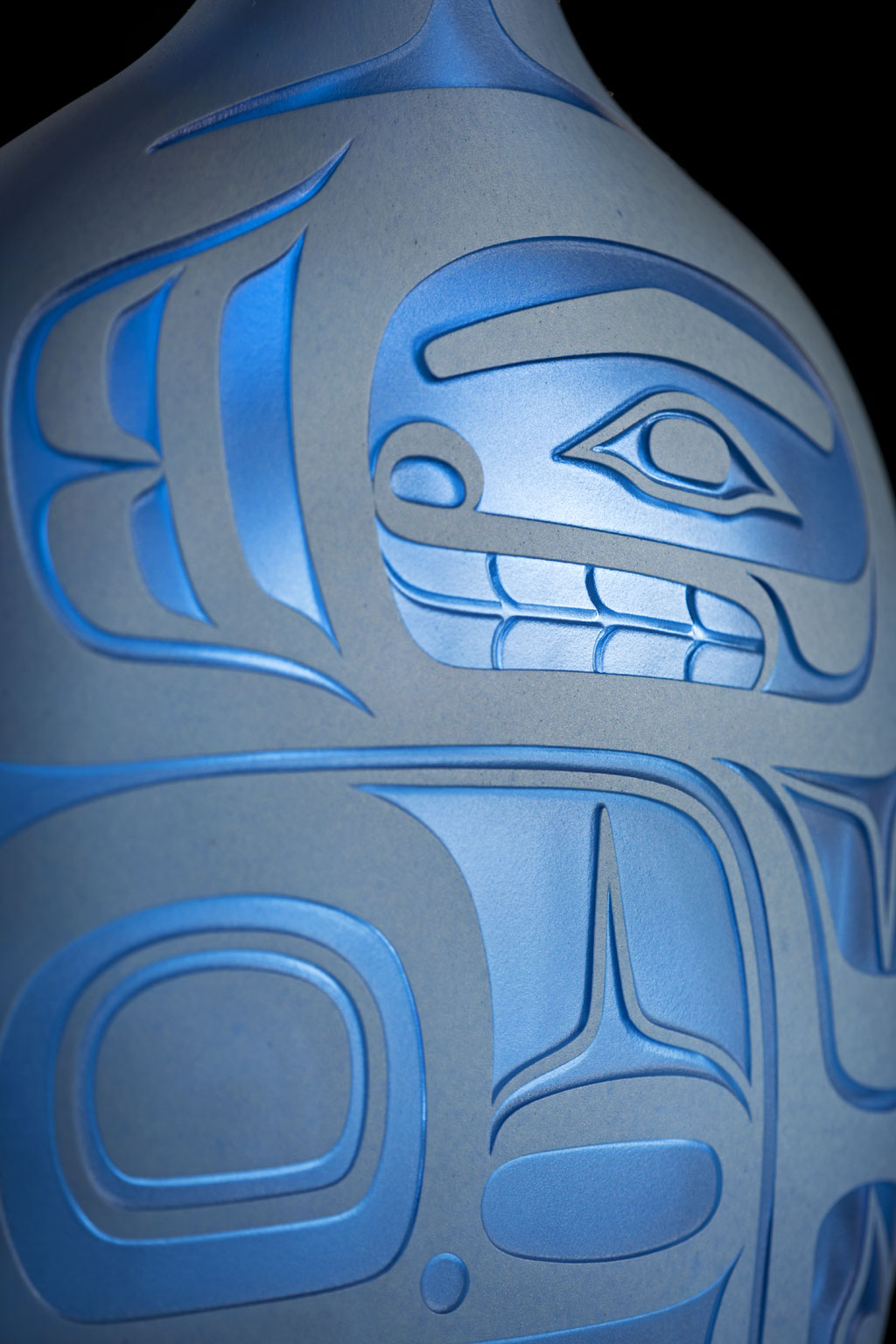
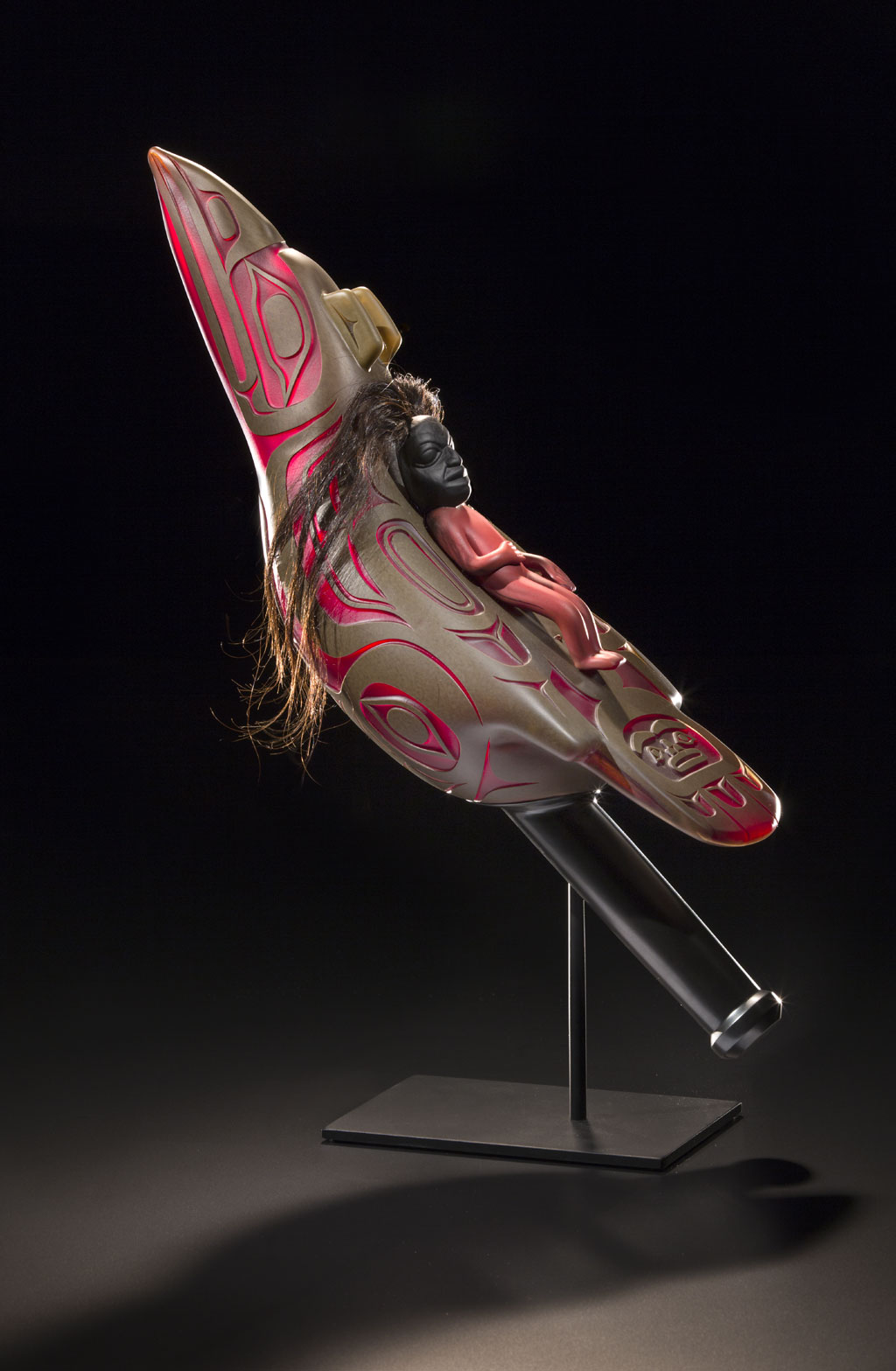
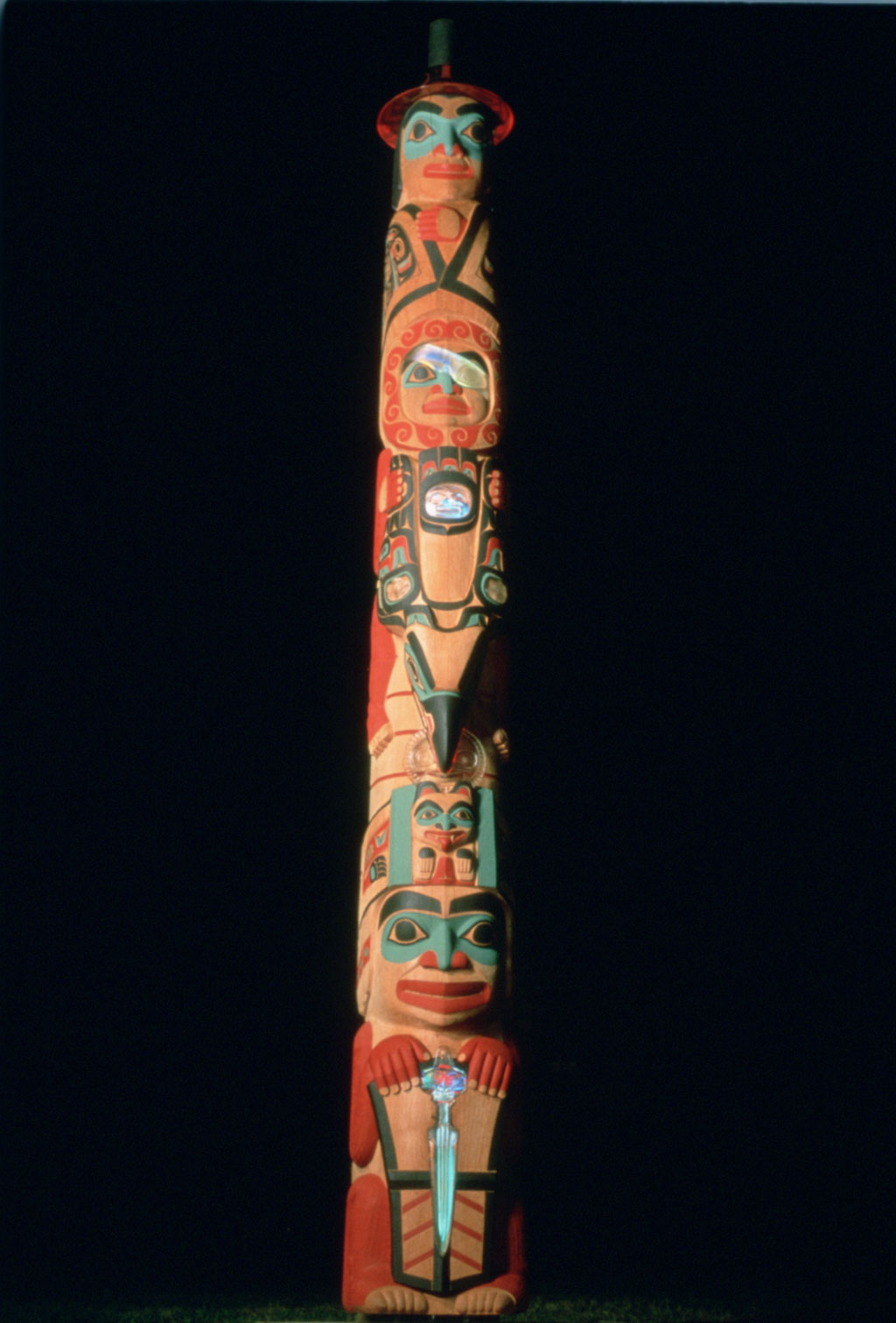
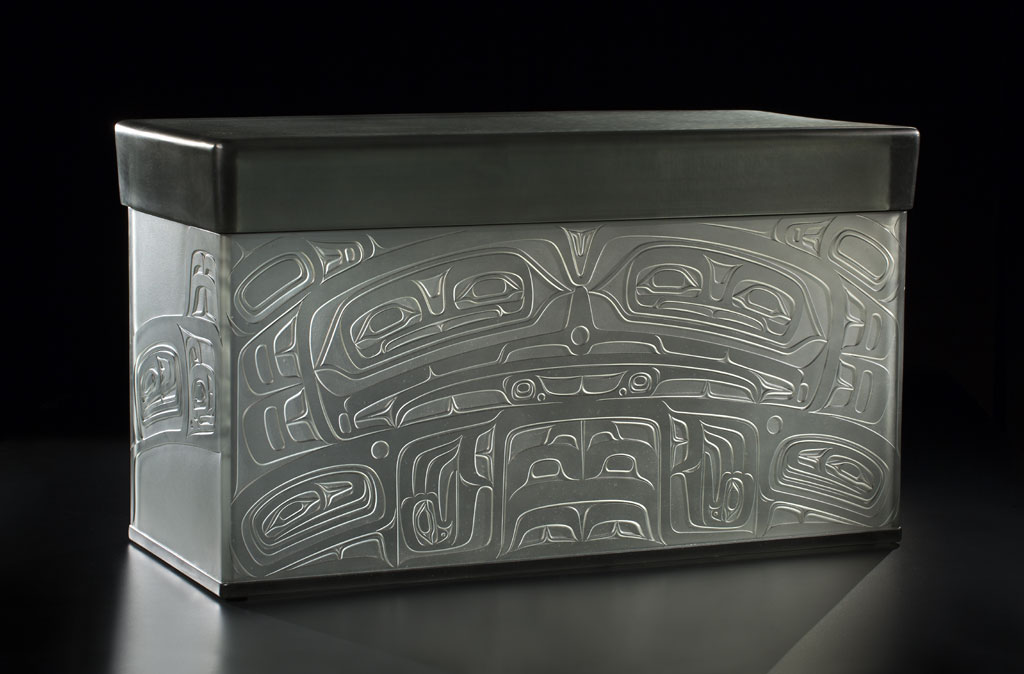
Filming Preston Singletary
In May, the Craft in America crew visited Preston Singletary’s glass studio in Seattle for the NATURE episode. We watched Preston create a raven and salmon out of hot glass, with help from assistants Joseph BenVenuto and Sean Albert. We also watched Preston draw his designs on his pieces, which were cut by Brittaney Shanta and sandblasted by Terri Rau. Such a wonderful team and work environment. Curator Miranda Belarde-Lewis also stopped by to discuss an upcoming exhibition of Preston’s work at the Museum of Glass in Tacoma. For Preston’s interview, we went to Discovery Park, where Mount Rainier was just barely visible in the background and Preston played his drum for us on the beach. We then made a quick stop at the Seattle Art Museum to film Preston’s Killer Whale screen. Special thanks to Celine Rabago at Preston Singletary studio for her help organizing this shoot and to the Seattle Art Museum for allowing us to film there. Photos courtesy of Mark Markley & Denise Kang.

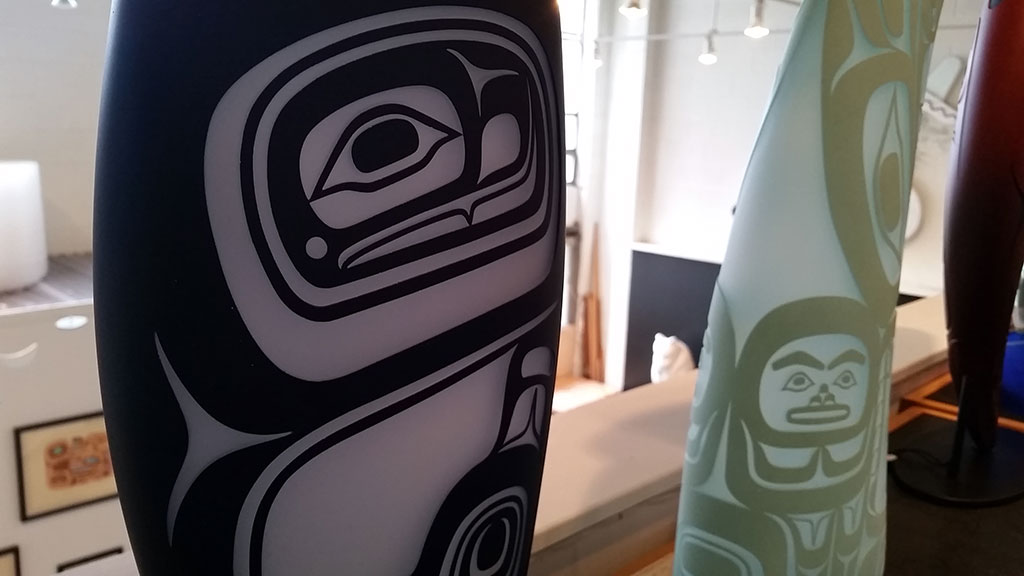
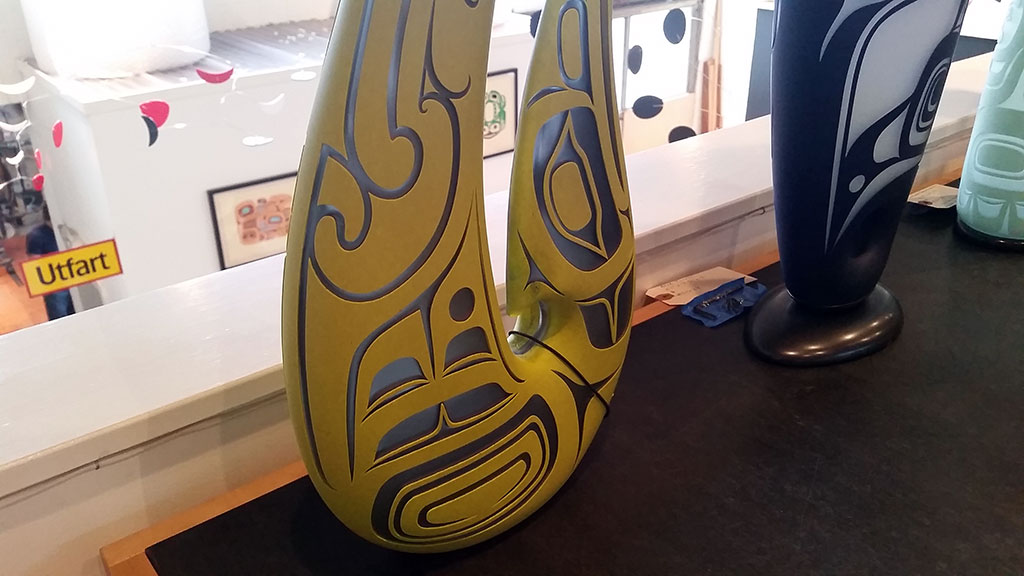
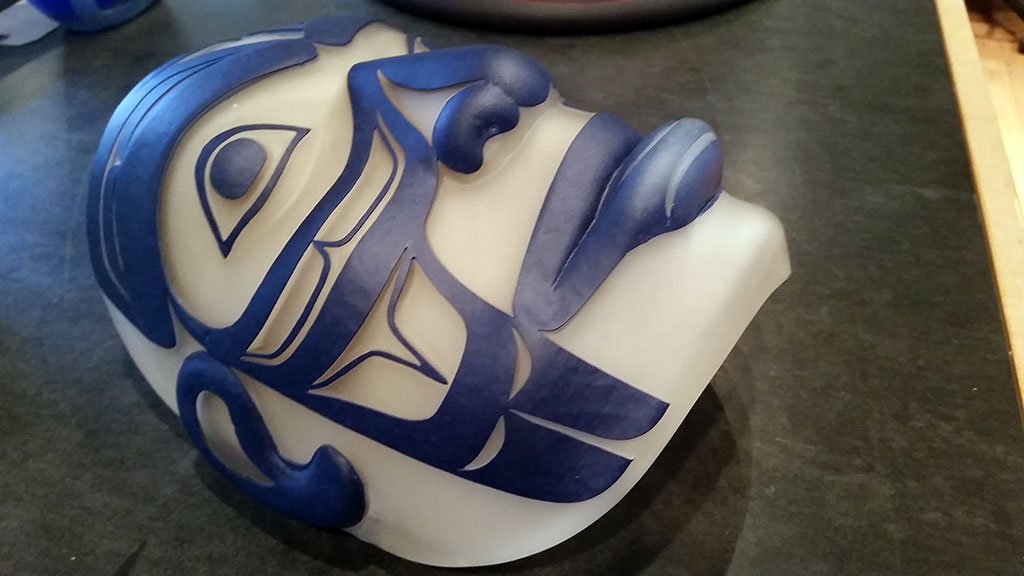
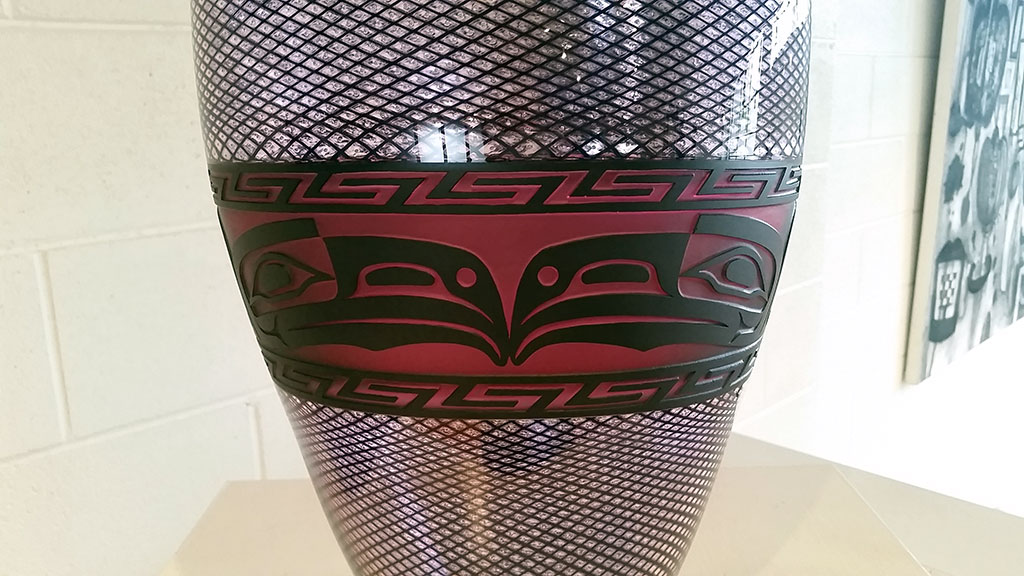

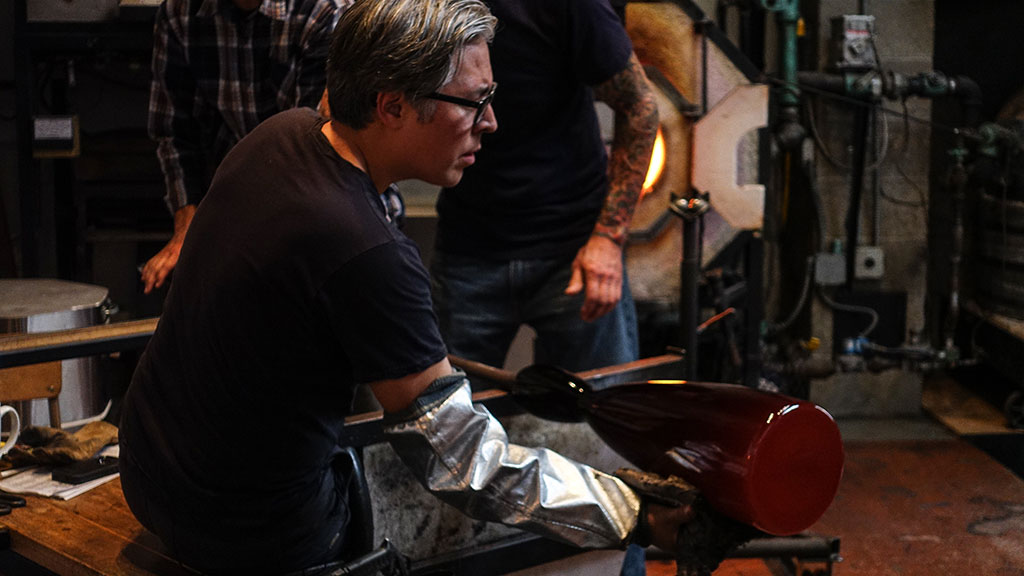
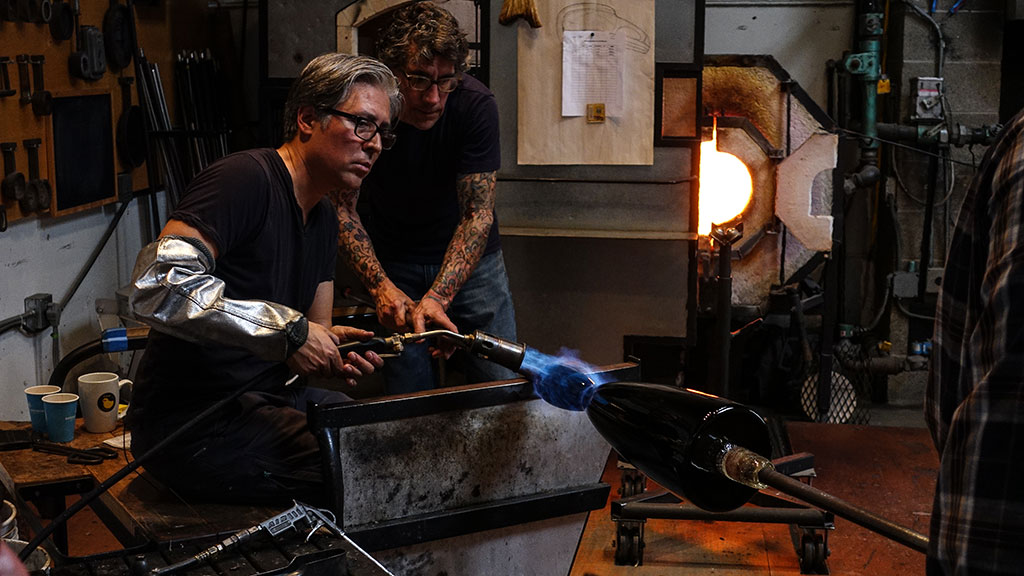
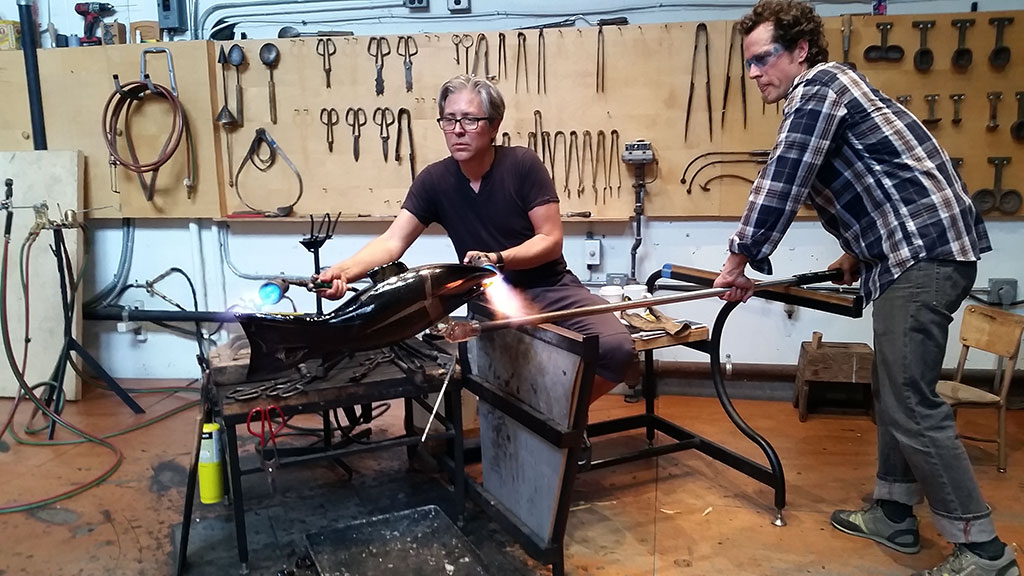
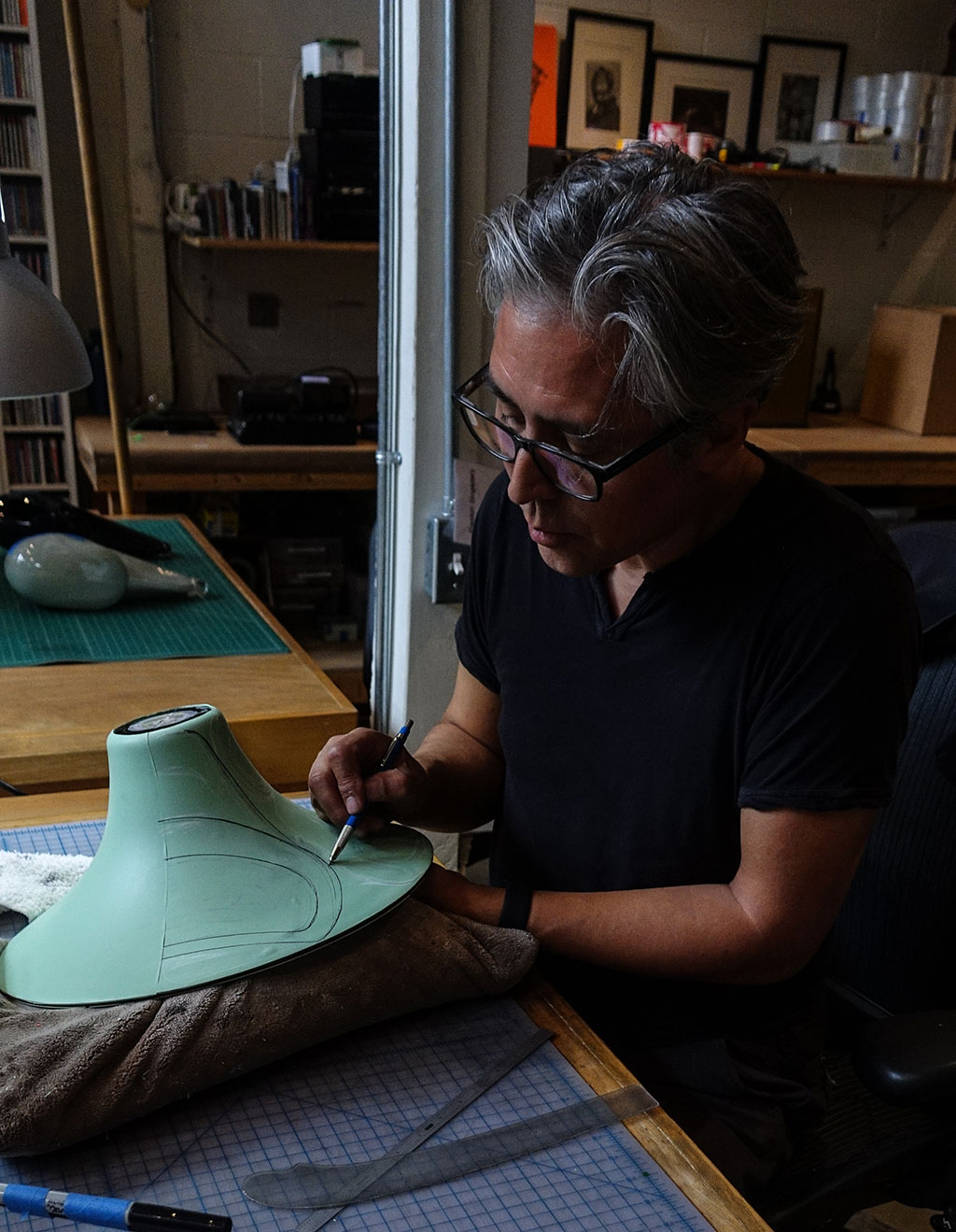
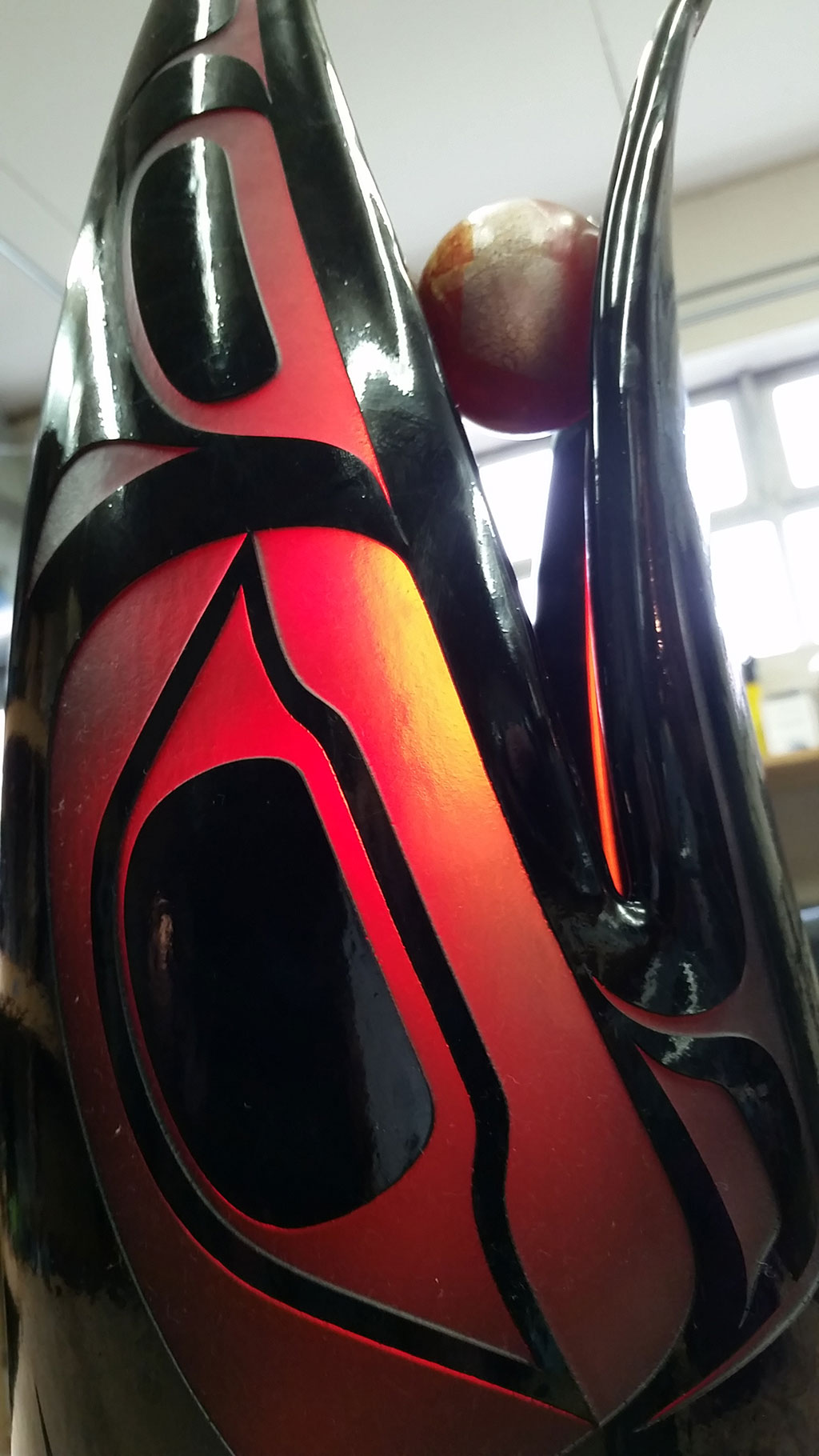
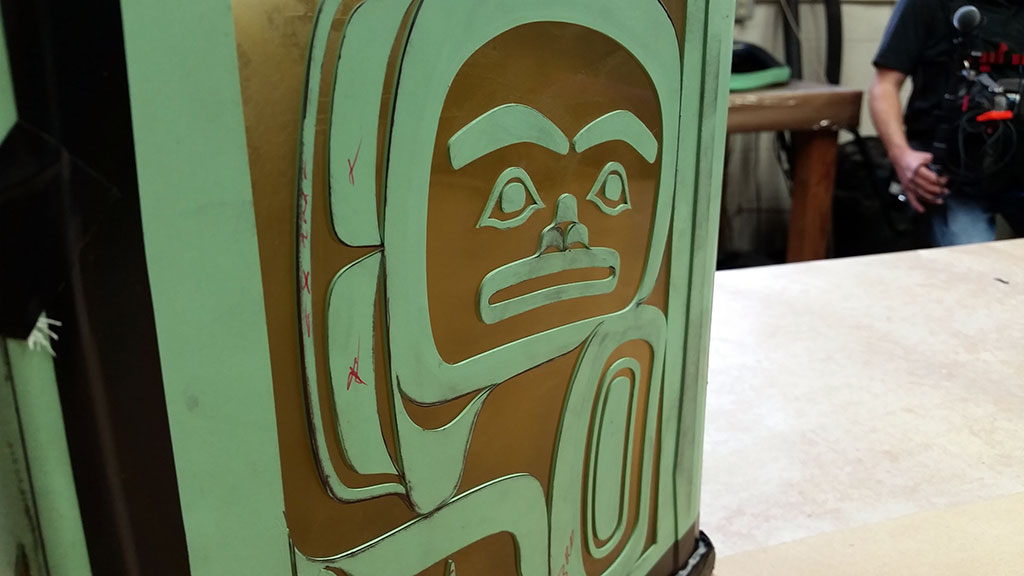
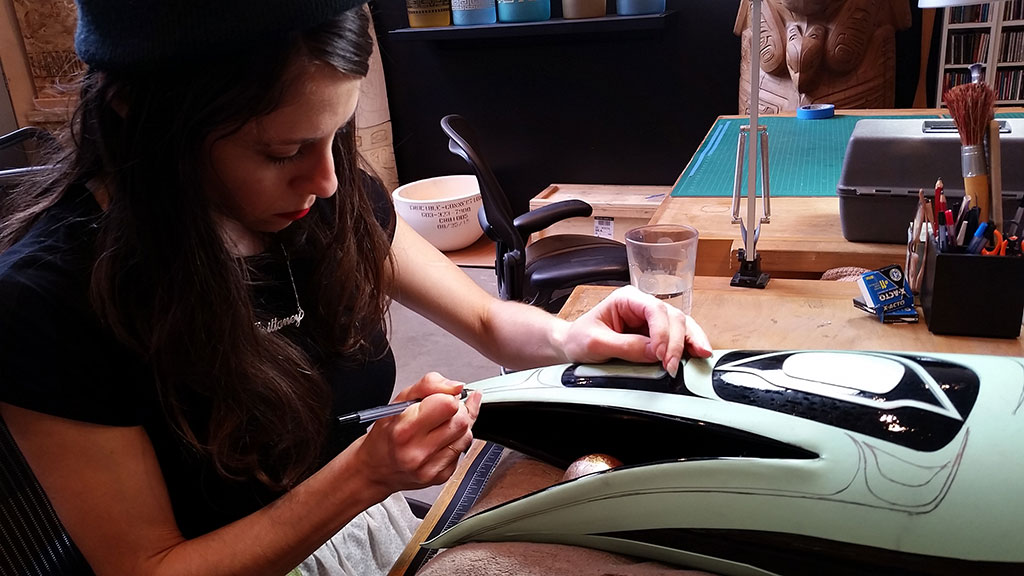
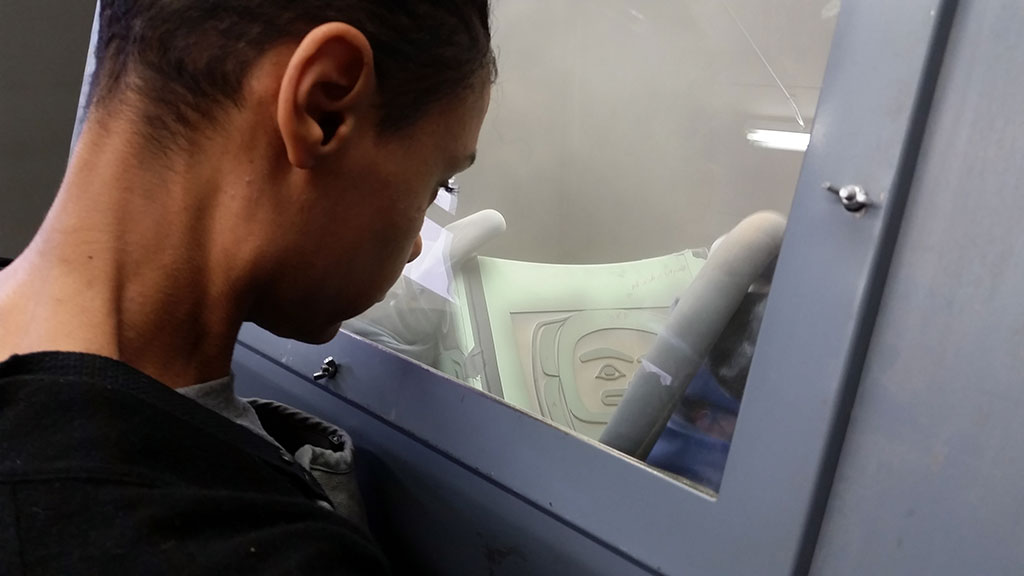

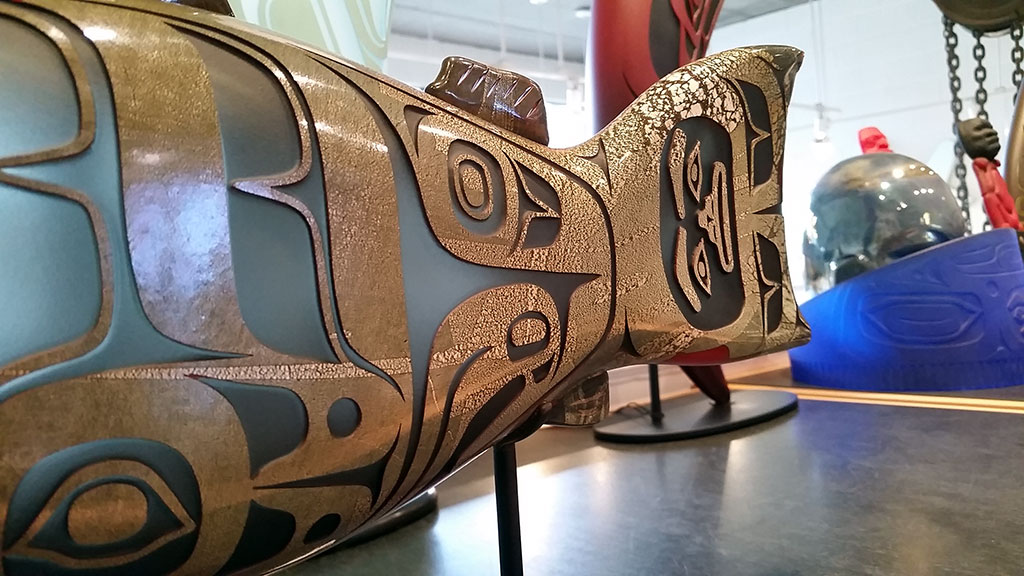
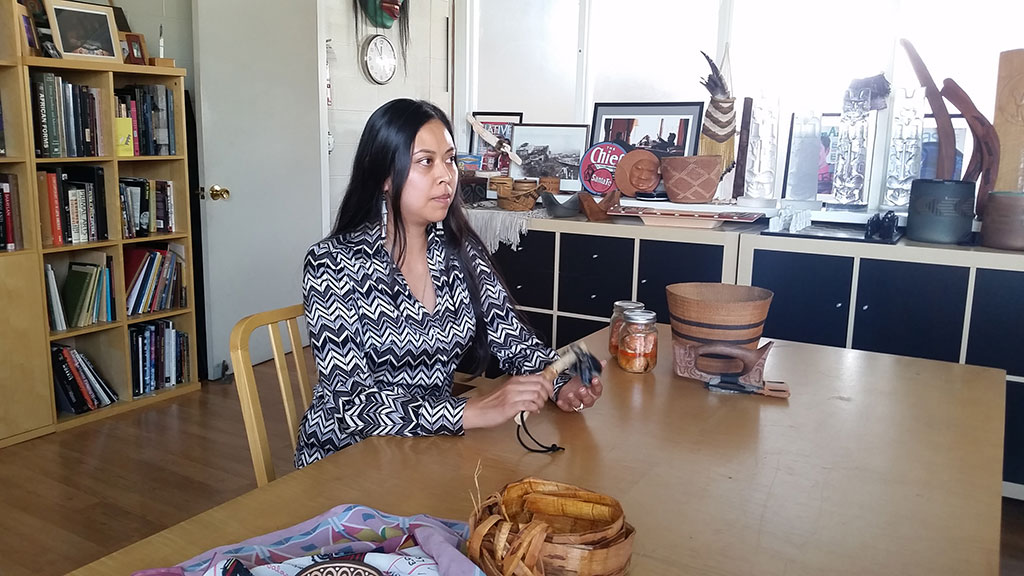
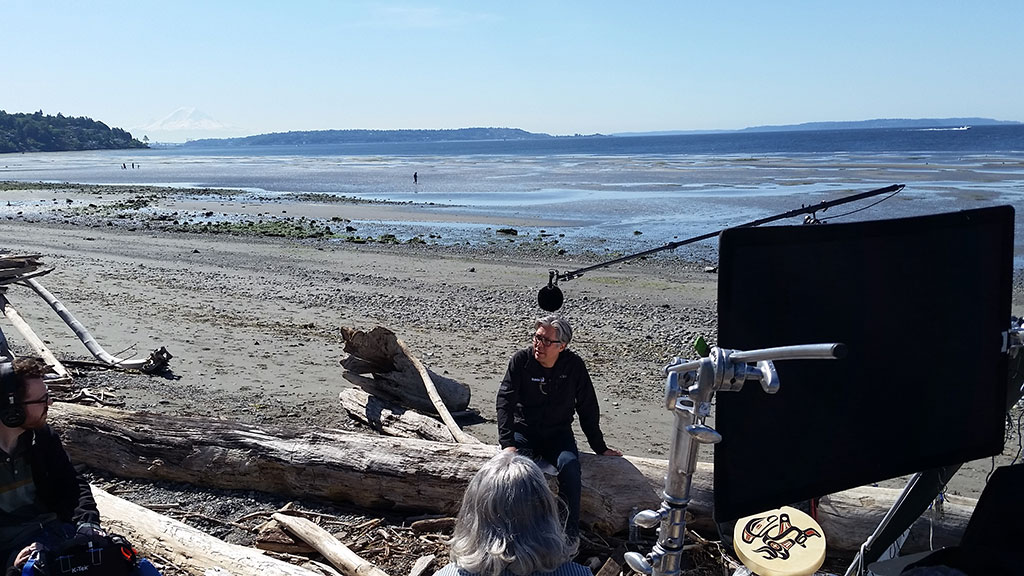
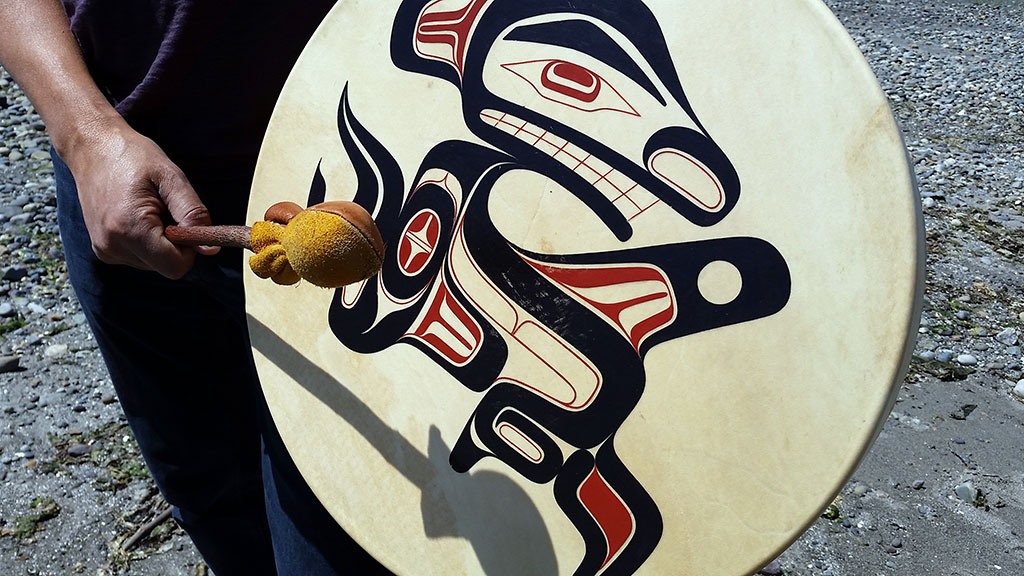
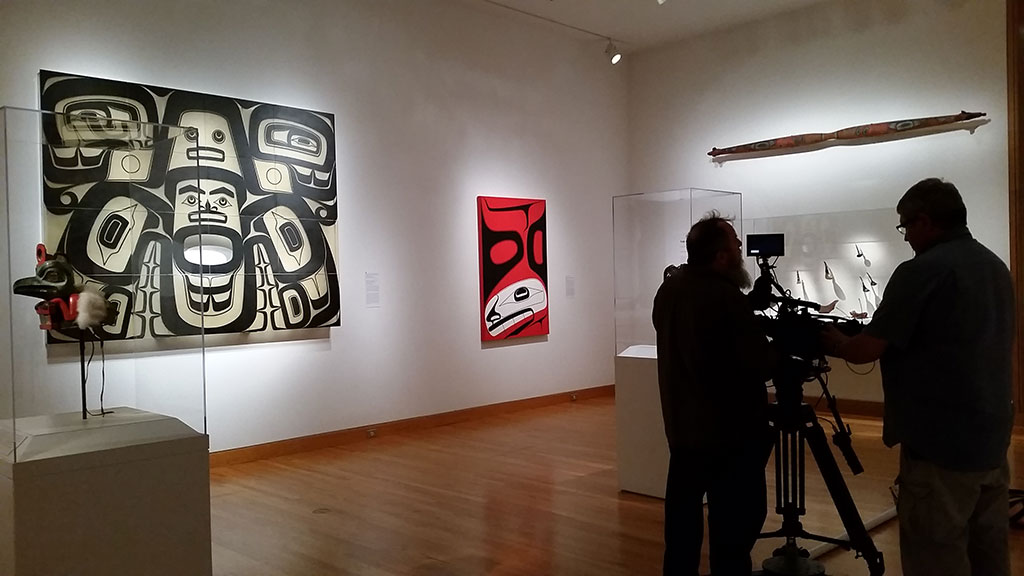
Preston Singletary on his work
Glass artist Preston Singletary on his work. NATURE episode PBS premiere: Friday, April 21, 2017.
Preston Singletary is a Tlingit glass artist. Singletary transfers Tlingit designs, traditionally carved in wood, onto glass. He studied at the Pilchuck Glass School in Stanwood, Washington.
Light is integral to his work, and he uses it to add dimension to the glass and his design. His work is in the collections of the Corning Museum of Glass, the Heard Museum, the Museum of Fine Arts, and Seattle Art Museum.
Preston Singletary segment
NATURE episode Preston Singletary segment. PBS premiere: Friday, April 21, 2017.
Preston Singletary is a Tlingit glass artist. Singletary transfers Tlingit designs, traditionally carved in wood, onto glass. He studied at the Pilchuck Glass School in Stanwood, Washington.
Light is integral to his work, and he uses it to add dimension to the glass and his design. His work is in the collections of the Corning Museum of Glass, the Heard Museum, the Museum of Fine Arts, and Seattle Art Museum.
Dante Marioni & Preston Singletary collaborate
Seattle glass artists Dante Marioni and Preston Singletary collaborate on glass and talk about their friendship. Marioni and Singletary met in high school and have stayed connected, personally and professionally, ever since.
Preston Singletary on his heritage and Tlingit mythology
Glass artist Preston Singletary talks about his heritage, how tools help to develop their art and culture over the years, and Tlingit symbolism.
Crafting a Tale of Ecology
In this lesson, students will view the Preston Singletary segment from the NATURE episode of the PBS series Craft in America. Students will hear from the artist, the team of assistants that help with his glasswork, and independent curator Miranda Belarde-Lewis, who is curating a show of Singletary’s work. The program features the Tlingit origin story Raven and the Box of Daylight as well as information about traditional Tlingit art, customs, and philosophy. After viewing the episode, students will discuss Singletary’s work and the Tlingit people’s connections to the natural world. Students will also examine the ecology of art materials. In the studio portion of the lesson, students will choose a traditional tale and rewrite it as an ecological fable. Students will share the tale by crafting a diorama that includes found materials.
SUPPORT MATERIALS
Crafting a Tale of Ecology
Full Guide & Worksheets
Background Reading
Lesson Overview
Teaching Tips
Teaching Tips for Teachers
Further Information
Resources & Materials for Teaching
Vocabulary
Vocabulary & Key Terms
Discussion Questions
Discussion Questions for Students
Worksheet #1 for Students
The Ecology of Art Materials
Worksheet #2 for Students
Crafting a Tale of Ecology

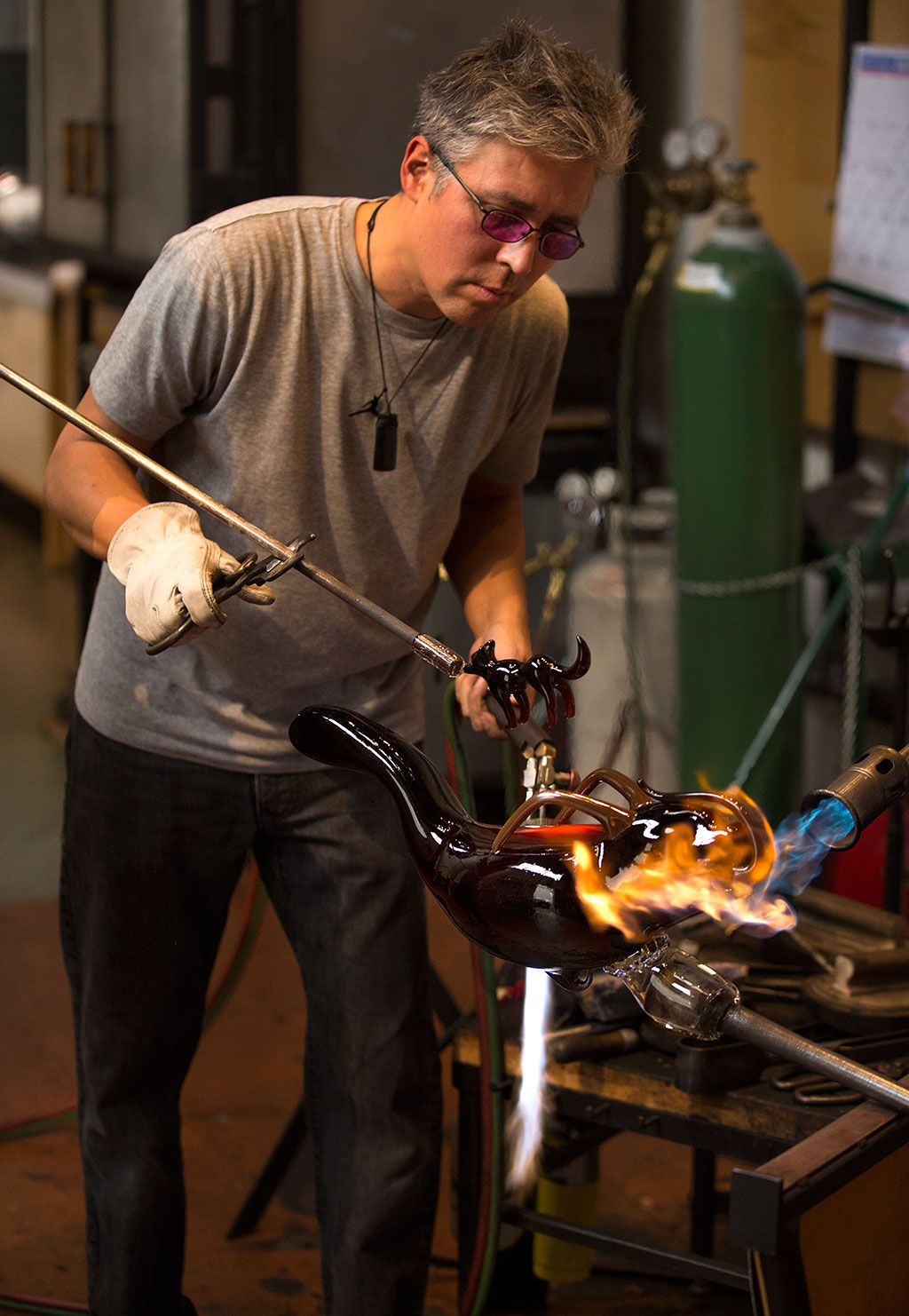

Native people are the best storytellers in the world because our stories carried knowledge. And that knowledge was needed to survive in a particular environment.
— Miranda Belarde-Lewis, Independent Curator
Grade Level: 9-12
Estimated Time: Two 45 minute class periods of discussion and research, Four 45 minute class periods of sketching and studio production
Background Information
Preston Singletary (b. 1963 in San Francisco, CA) is a Tlingit glass artist. He studied at the Pilchuck Glass School in Stanwood, Washington. Singletary transfers Tlingit designs, traditionally carved in wood, onto glass. Light is integral to his work, and he uses it to add dimension to the glass and his design. Singletary is surrounded by the wild natural beauty of the Pacific Northwest Coast. He captures the motion and magnificence of wild creatures in molten glass, then embellishes the cooled and hardened sculptures with symbols and designs from Tlingit culture. He is a pioneer, one of only a handful of Native American artists working in glass today. He explains as he works in his Seattle, WA studio, “When I began working with glass, I had no idea that I’d be so connected to the material in the way that I am. It was only when I began to experiment with using designs from the Tlingit cultural heritage that my work took on a new purpose and direction.” His work is in the collections of the Corning Museum of Glass, the Heard Museum, the Museum of Fine Arts, and Seattle Art Museum.
Key Concepts
- Connection to environment and place can be a theme for artist’s work.
- The art materials we choose have ecological significance.
- We understand our world through stories.
Critical Questions
- Why is connection to environment and place an important theme for some artist’s work?
- What is the ecological significance of the art materials we choose?
- How can telling stories enable (or limit) our understanding of the world?
Objectives
Students will:
- Understand that connection to environment and place can be a theme for an artist’s work.
- Research the sustainability and ecological significance of their chosen art materials.
- Develop an artwork that teaches the school community about an important family member or figure in the student’s life.
Vocabulary
Tlingit, Zuni, sustainable, stagecraft, environment, indigenous, transformational, bounded space, curator, aesthetics, ambiguous.
Interdisciplinary Connection
- Technical Education: Students may choose to add to their story with video, special lighting of objects, and/or sound recordings, as Preston Singletary does in his show. Technical Education teachers may help to provide expertise and equipment for these plans.
- English/Literature: Origin stories may be a topic to explore with an English teacher, perhaps comparing origin stories from various books, cultures, and places.
- Science: Science teachers may help with determining the sustainability of artists’ materials in the classroom. This topic could provide several lessons in itself: looking at the origin and ecological aspects of art materials.
National Standards for Visual Arts Education
This lesson addresses the following standards. The performance standards listed here are directly related to the lesson’s goals.
- Visual Arts/Connecting #VA:Cn10.1
Process Component: Interpret Anchor Standard: Synthesize and relate knowledge and personal experiences to make art. - Visual Arts/Creating #VA:Cr2.2
Process Component: Investigate Anchor Standard: Organize and develop artistic ideas and work. - Visual Arts/Presenting #VA:Pr.4.1
Process Component: Relate Anchor Standard: Select, analyze and interpret artistic work for presentation. - Visual Arts/Presenting #VA:Pr6.1
Process Component: Analyze Anchor Standard: Convey meaning through the presentation of artistic work. - Visual Arts/Responding #VA:Re8.1
Process Component: Perceive Anchor Standard: Interpret intent and meaning in artistic work.
Resources & Materials for Teaching
Resources
- Craft in America DVD, NATURE. Also viewable online at www.craftinamerica.org/episode/nature
- Craft in America website, www.craftinamerica.org
- Video of Preston Singletary on his childhood friendship and working relationship with Dante Marioni: www.craftinamerica.org/short/dante-marioni-preston-singletary-on-their-friendship
- Preston Singletary on his heritage and Tlingit mythology:
www.craftinamerica.org/short/preston-singletary-on-his-heritage-and-tlingit-mythology - Curator Miranda Belarde-Lewis on the importance of traditional ecological knowledge:
www.craftinamerica.org/short/miranda-belarde-lewis-shows-us-a-bowl-and-the-importance-of-traditional-ecological-knowledge - Preston Singletary’s website, www.prestonsingletary.com
- Museum of Glass (Tacoma, WA) website: www.museumofglass.org
- To research and see a vast selection of American Indian art, start at this map for locating cultures at the National Museum of the American Indian: www.nmai.si.edu/searchcollections/peoplescultures.aspx
- Download a full color PDF of a Pacific Northwest Coast Native Art Guide from the University of Alaska: www.uas.alaska.edu/library/pdfs/Northwest%20Coast%20Native%20Art%20Guide
Additional resources for worksheet: The Ecology of Art Materials
- Find extensive information on artists’ paint at this site, Pigments Through the Ages: www.webexhibits.org/pigments
- Information from Green America about potential toxicity of art materials: www.greenamerica.org/livinggreen/toxicart.cfm
- A look at the use of ledger paper and hide-made garments as found materials for narrative depictions from the Smithsonian (historic and contemporary examples from Plains tribes):
www.smithsonianmag.com/smithsonian-institution/these-native-american-artists-material-message-180958567
Worksheets
- The Ecology of Art Materials
- Crafting a Tale of Ecology
Materials
- Access to online resources for research
- Sketchbooks
- Pencils
- Art materials of students’ choice
- Found materials: boxes and containers of all kinds for dioramas
- Safety glasses
- Additional found materials: Encourage students to use recycled materials, including old worksheets and notes from schoolwork, scrap wood, fabric, scrap metal, scrap glass, cardboard, and packaging materials. Discarded objects from home and thrift store finds can be useful in diorama crafting.
- Glue
- Optional: video, recording, and playback equipment for recording and displaying dioramas
- How does Singletary describe his position as an artist?
- Why does he work in glass?
- What is a curator? (Students may look this up afterwards.) • What does storytelling provide for the Tlingit people?
- What is “bounded space?”
- Is each piece of the show an artwork on its own? What does studio assistant Joseph BenVenuto say about the pieces?
- How important is environment to the artist and the curator? To the Tlingit people?
- What are the jobs of Singletary’s studio production team?
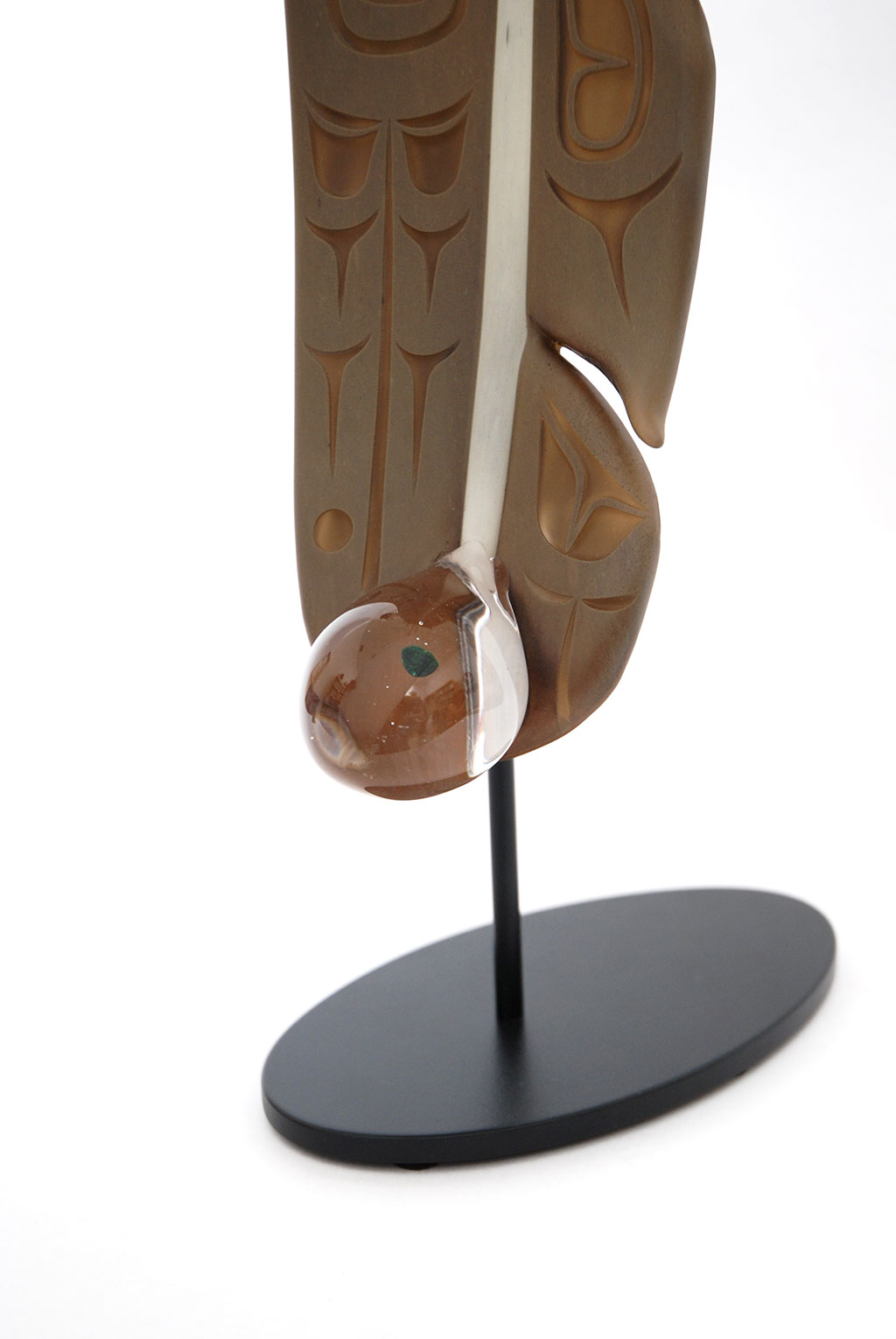
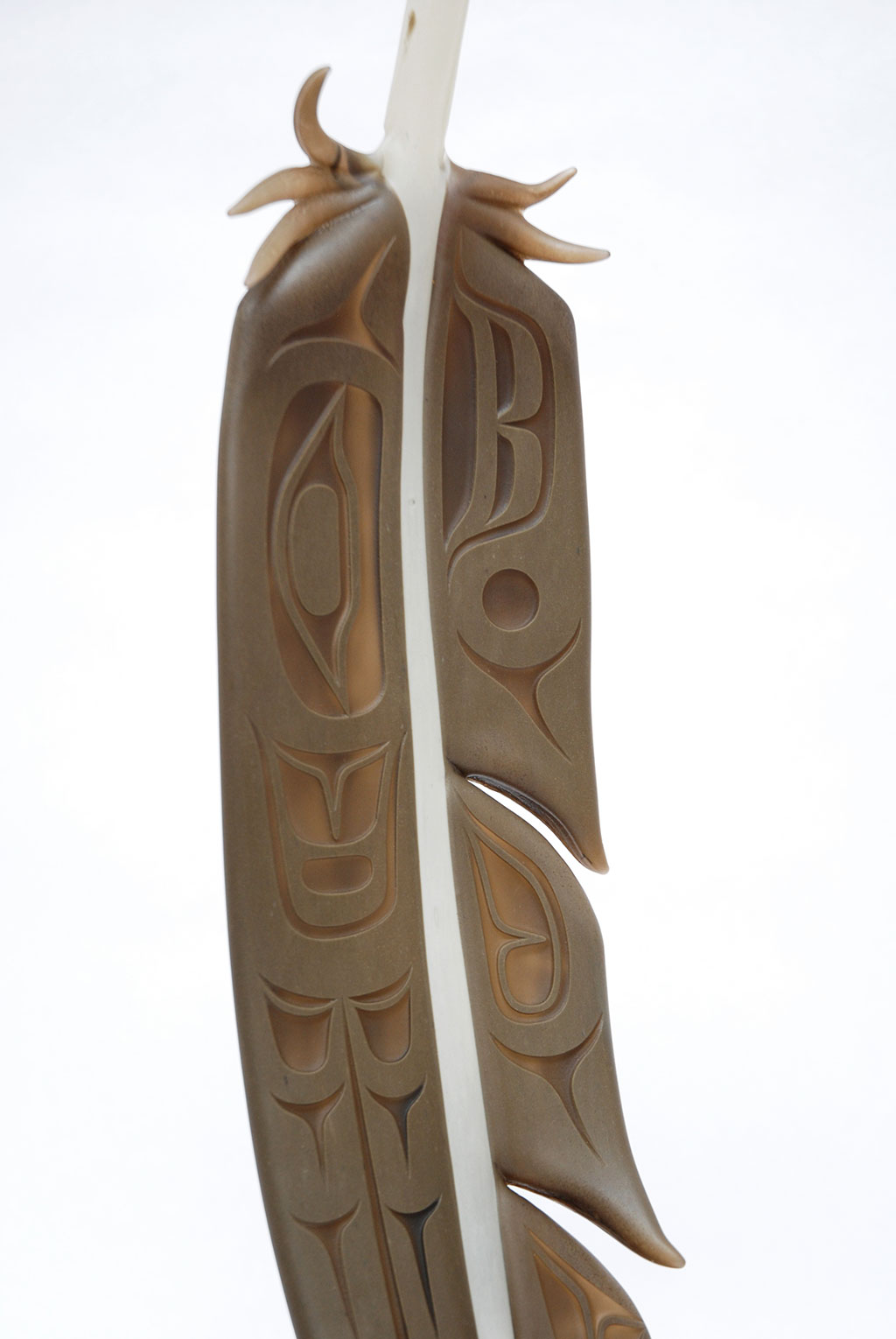




After Viewing
Begin a discussion of the video. What did students find interesting? What questions do they have? Using students’ notes, discuss the information they gathered about the listed categories. Following are discussion ideas and potential answers to the questions above.
Discussion
- How does Singletary describe his position as an artist? Singletary considers himself a bridge joining traditional Tlingit culture with new ways of sharing the stories and knowledge.
- Why does he work in glass? The artist notes that many traditional northwest materials are gone or in short supply. Introducing glass provides a new, plentiful material but also a new way of creating traditional art.
- What is a curator? After entertaining guesses, have students look up this word in several sources. Curators may be responsible for planning art shows, acquiring art for institutions, deciding what to exhibit, and caring for artworks.
- What does storytelling provide for the Tlingit people? Miranda Belarde-Lewis states that “Native storytellers are the best storytellers in the world because our stories carried knowledge…that was needed to survive…” Also, environmental knowledge was passed along through storytelling.
- What is “bounded space?” Miranda Belarde-Lewis shares this definition from Apache philosopher Viola Cordova: “In Native American philosophy, bounded space is the natural environment one exists in; and the relationships one has with that space. Cordova believed this space affects everything about a person: their language, culture, spirituality, and their aesthetics (how they believe something should look, or their ideas of beauty.) What do students think of this philosophy?
- Is each piece of the show an artwork on its own? What does studio assistant Joseph BenVenuto say about the pieces? BenVenuto remarks that “One piece of his (Singletary’s) work is merely one line in a story.” This is a different view of art objects than the western view of each crafted object being precious in itself. This topic could be interesting to discuss with students. Have they ever crafted a piece that was part of a whole, and not complete in itself?
- How important is environment to the artist and the curator? To the Tlingit people? Preston Singletary and Miranda Belarde-Lewis each comment on sustainability. For example, the preservation of natural species such as the cedar trees, used for canoes, baskets, and more was (and perhaps remains) essential to survival.
- What are the jobs of Singletary’s studio production team? Encourage students to describe how they see studio glassworking assistants Sean Albert and Joseph BenVenuto, master cutter Brittaney Shanta, and sandblaster Terri Rau working.
- What is the story of Raven and The Box of Daylight? Have students tell the story. Ask them to look up versions of the story online. Does the story remind students of other stories they have heard? Discuss the term origin story and ask students to name other examples of origin stories.
After Discussion: Investigation
Worksheet: The Ecology of Art Materials
Have students research and share information in small groups. Then have the class share as a whole. Have each student responsible for creating one information card (such as a large index card) about one material that can be posted on a bulletin board for the education of all.
Worksheet: Crafting a Tale of Ecology
This worksheet introduces the story and diorama project
Studio Production (four 45 minute class periods)
The salmon is going to play a part sort of like stagecraft. I’ll have glass on the ground that looks like the river and these salmon are going to be kind of floating above the top.
– Preston Singletary


After using the worksheets, students should have ideas for stories they intend to rewrite and dioramas they can create. Story ideas could start with fairy tales, such as retelling Goldilocks and the Three Bears as Goldilocks wreaks havoc in the bear’s environment. Students may have stories that already include an environmental component, such as from blockbuster disaster films or from comics. Have students write the story in their sketchbooks and embellish the tale with sketched ideas for their dioramas.
The diorama projects can vary according to students’ ideas. Some students may have traditional crafts practiced in their family that can become part of the scene and add more meaning; for example a knitted landscape. Students who camp, fish, hunt, or practice outdoor sports might want to include references to those family traditions in their story and their diorama.
To make a diorama, begin with a box set on its side to form a small “stage.” Prime the box by covering it with paint, paper, or fabric inside and out. Set the scene: Like stagecraft, add a background, and flooring base. Position characters and props by gluing found or crafted pieces in place. Consider the outside of the box as well as offering several surfaces for further treatment and visual embellishing of the story.
Reflection
It will also be enhanced by video, projecting onto glass and creating sort of a backdrop. I wanted to create this atmosphere of the northwest coast, with this mist rising out of the trees. It would transform the viewer into another place.
– Preston Singletary
Encourage students to work with each other to curate a show of what they have produced. They can decide on whether the exhibit should be brief or extended, where it should be placed, how it should be arranged. Do they think there should be video or recordings to accompany the show? Singletary talks about stagecraft and theatrics as a way of telling stories. He mentions having the story told in the Tlingit language playing in the background of his show, adding a layer of ambiguity for those who do not speak the language, yet adding to the “authentic” experience of the northwest. Students may want to consider these ideas in their own show planning.
Assessment
In discussions with the class and with individual students throughout the lesson; by examining the students’ worksheets; and by witnessing the students’ studio work, it should be evident that the student:
- Understands that connection to environment and place can be a theme for an artist’s work.
- Researched the sustainability and ecological significance of their chosen art materials.
- Rewrote a traditional tale including an ecological metaphor and presented the story in a diorama.
Extensions
Glasswork: Setting up a lampworking studio in the classroom is not inexpensive but a possible option with fundraising. Lampworking allows students an experience sculpting small projects (such as beads) with molten glass.
Authors
The Education Guide for NATURE was developed under the direction of Dr. Marilyn Stewart, Professor of Art Education, Kutztown University of Pennsylvania, Kutztown, PA. Lead author for Crafting a Tale of Ecology is Dr. Amy Albert Bloom, April 2017
Nature: Highlights from the Episode
“I try to translate this environment for other people to enjoy and understand.”
-Mary Merkel-Hess
The artists featured in this exhibition challenge viewers to reassess our relationship to the natural world and question whether or not we have been positive custodians of the landscape in which we live. Fiber artist Mary Merkel-Hess, woodcarver Michelle Holzapfel, book artist Catherine Alice Michaelis, and glass artist Preston Singletary create artworks that emanate from their passion about the natural world. In their choice of raw materials of wood, glass, and fiber as well as new materials, the artists are part of the important on-going conversation about the future of this planet.
This exhibition celebrates the American landscape from Iowa’s sea of grain, to the verdant woods of rural Vermont, to the rugged Pacific Northwest coast, to the hand-planted gardens that provide both food and inspiration to our craft artists. Throughout history, the colors, textures, shapes, as well as scents and tastes of the physical world have inspired artists to produce objects of astonishing power. By emphasizing the profound connection between art and society, NATURE continues a hallmark of Craft in America: positioning artists as participants in larger global concerns while at the same time honoring them as pure visionaries.
NATURE makes an important return to the Back-to-the Earth Movement of the late Sixties when a group of dedicated Americans decided to forgo many of the material aspects of our culture to celebrate and preserve the natural world. That generation made significant contributions to the arts, particularly the crafts. In these works you will find both a sense of discovery and a search for solutions to preserving the majesty of the natural world.
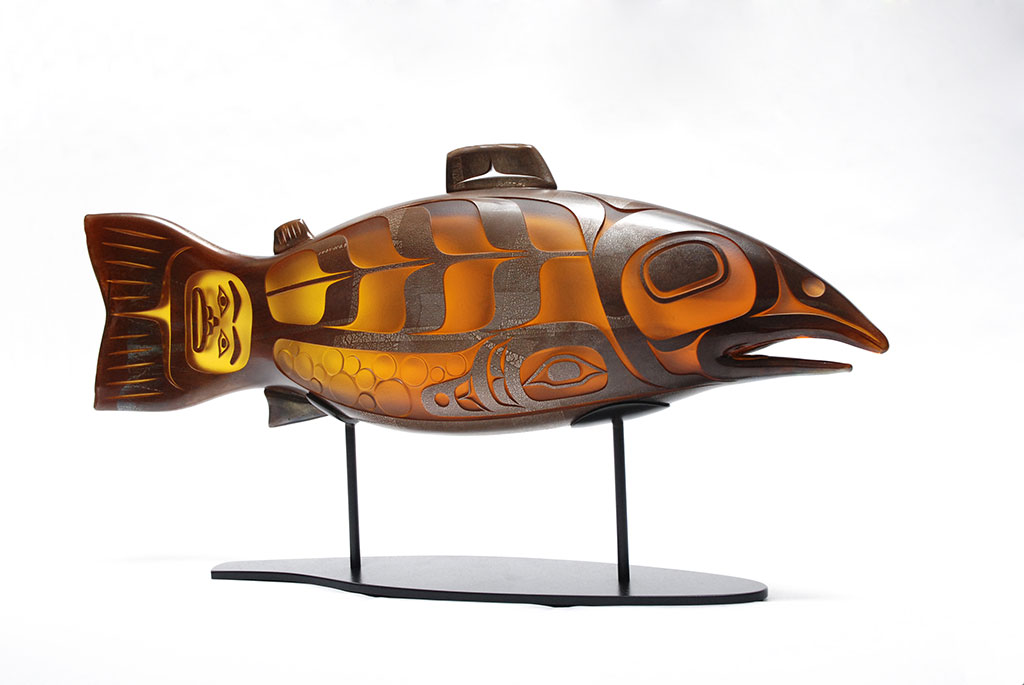
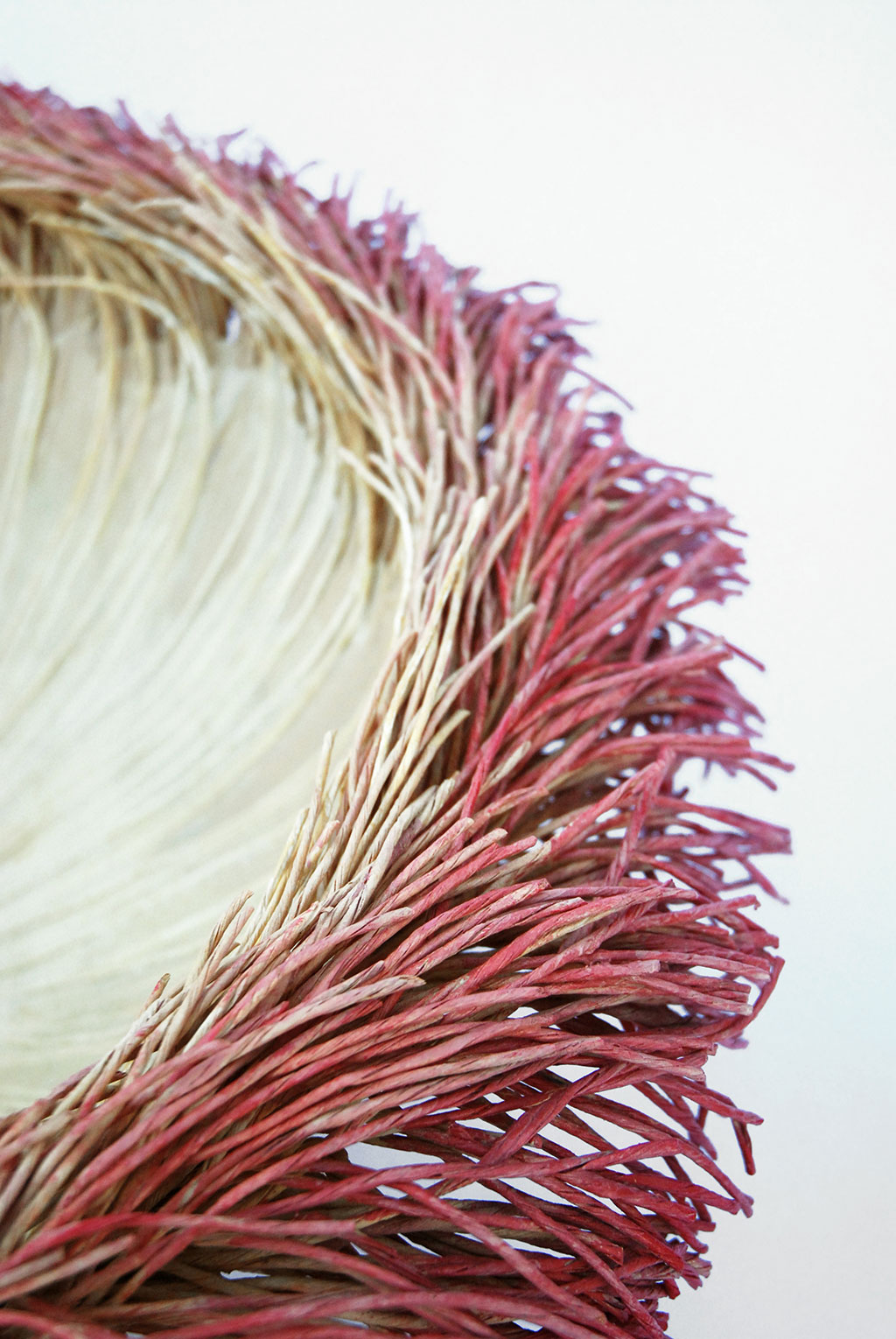
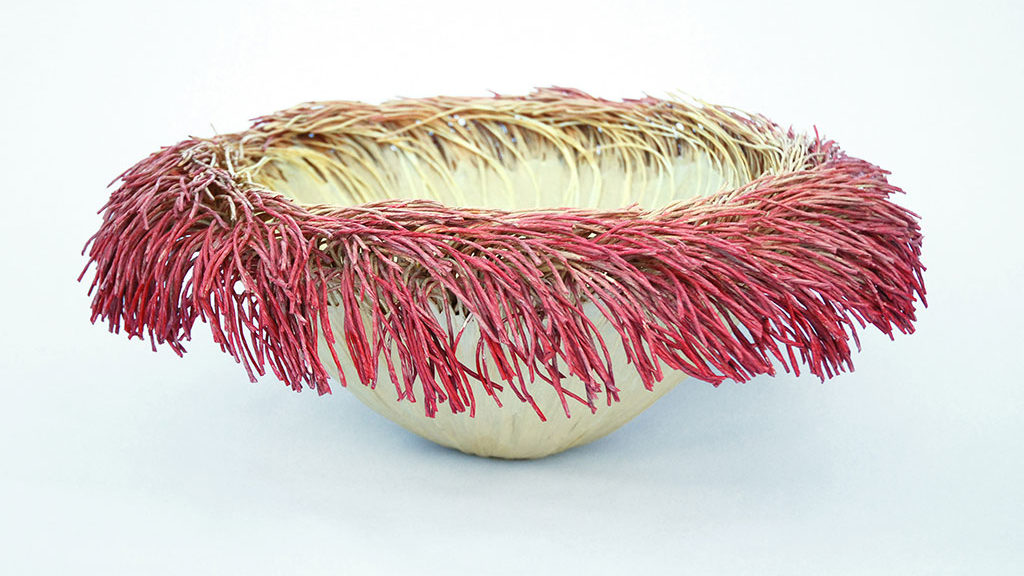
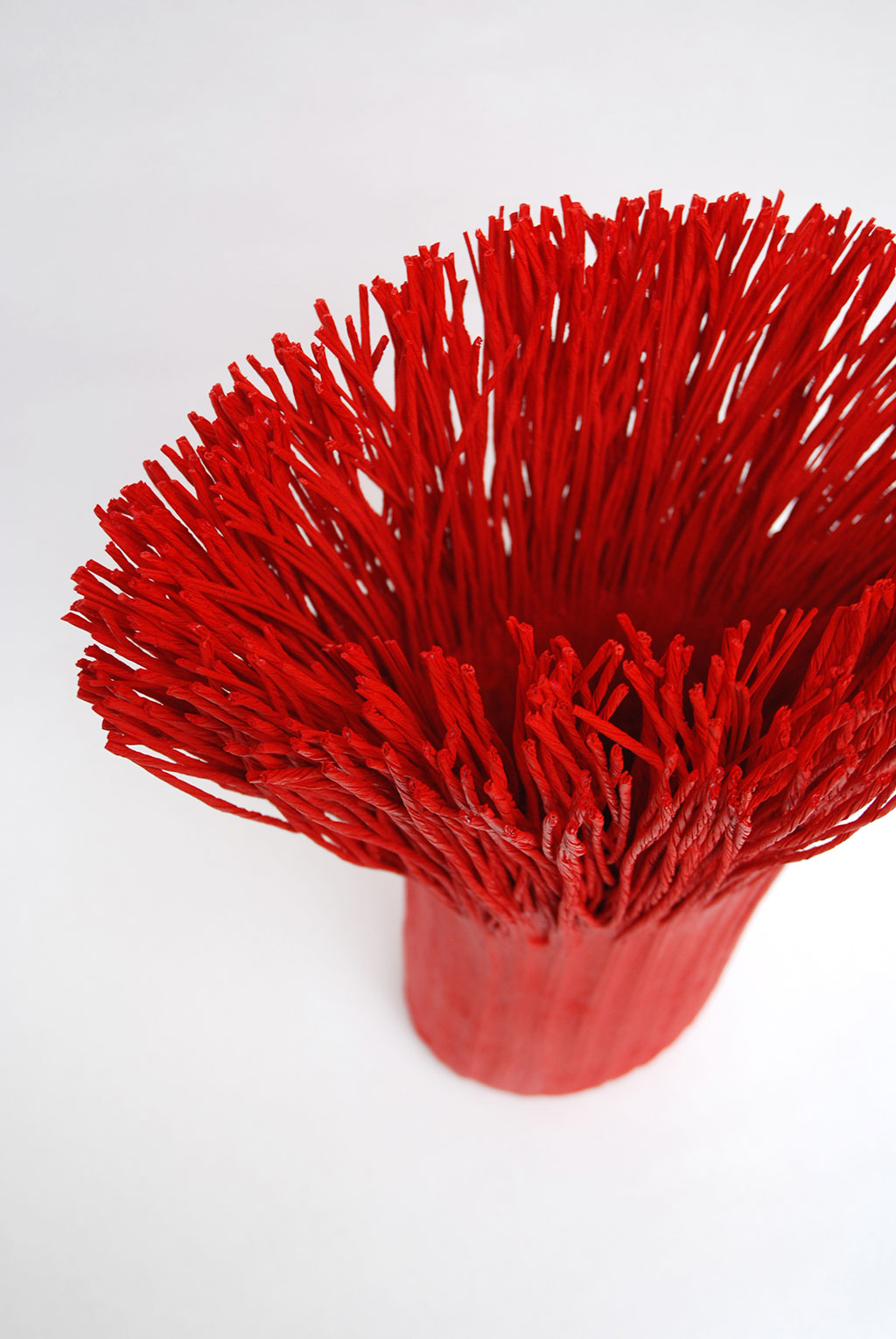
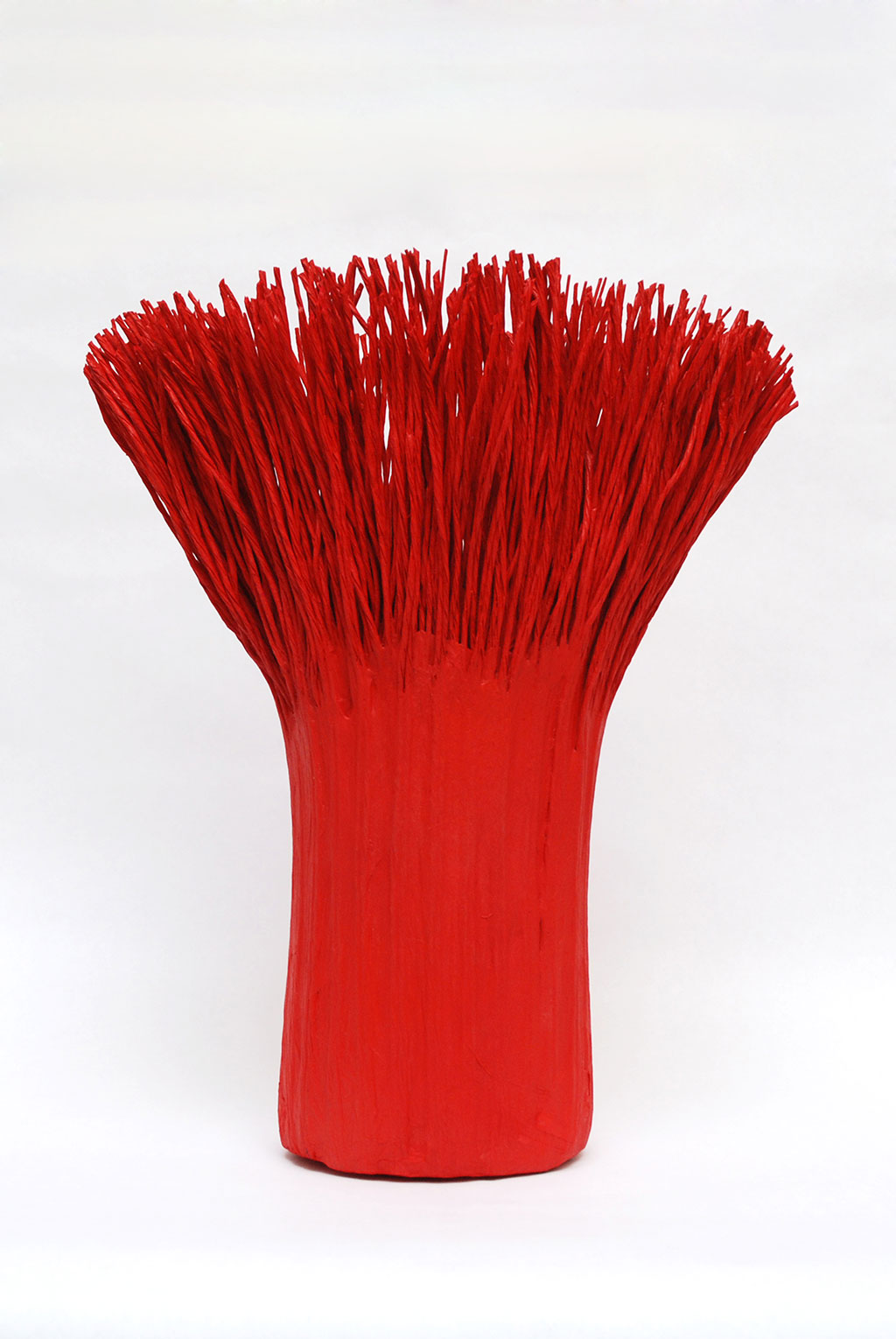


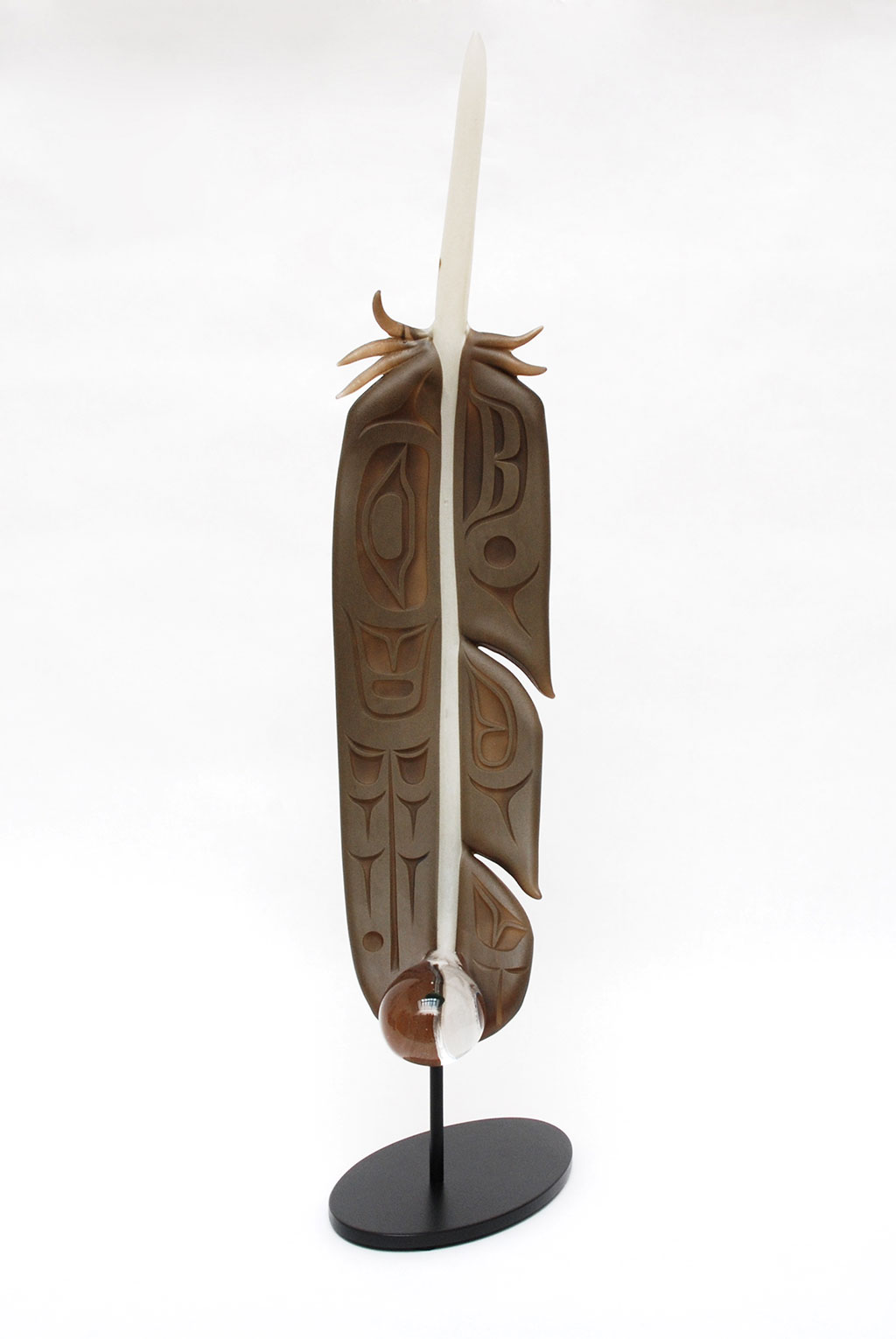
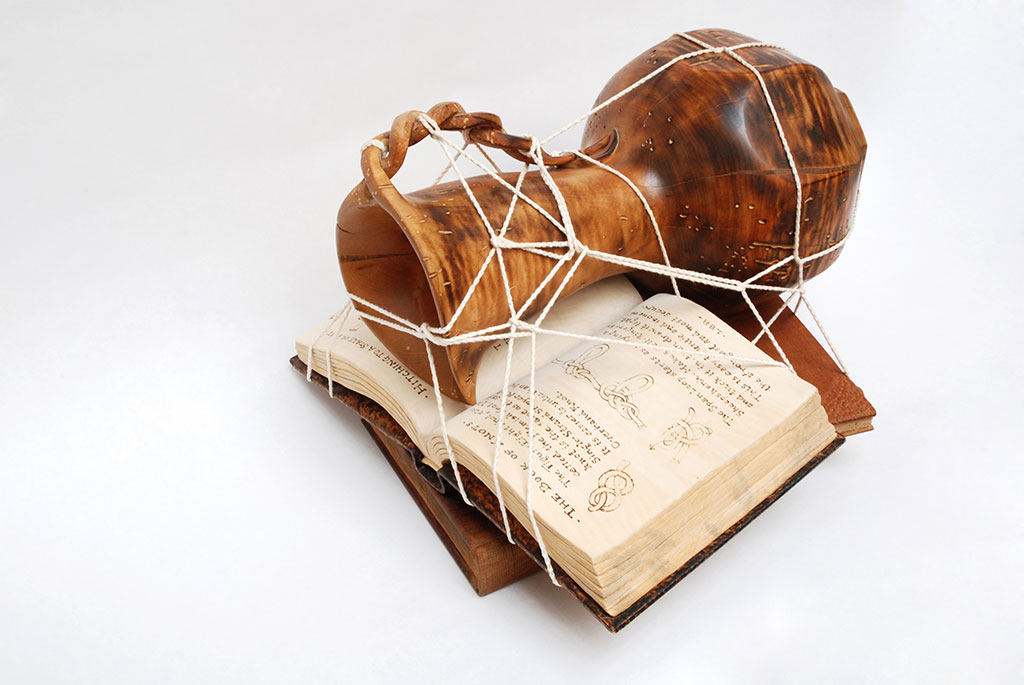
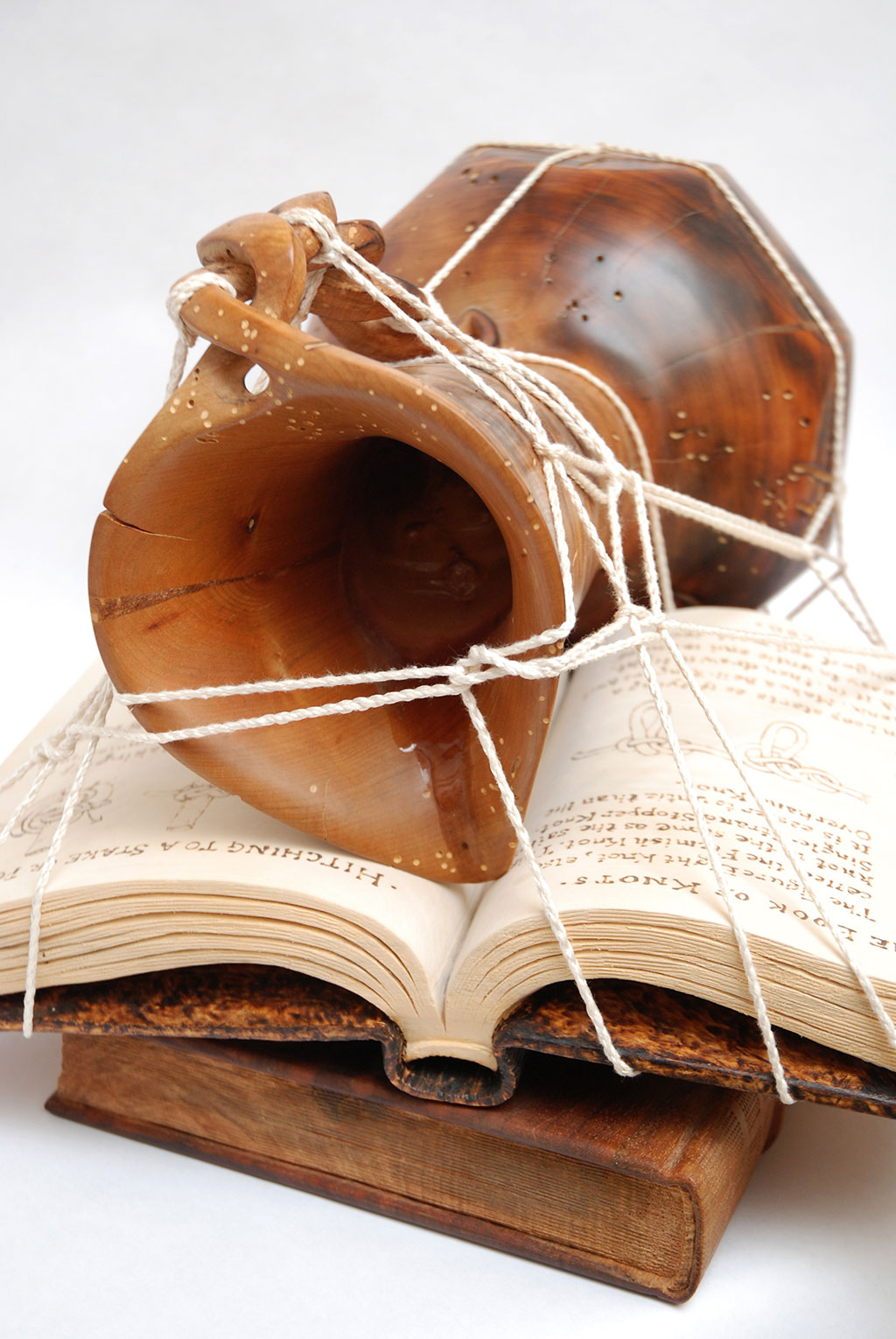
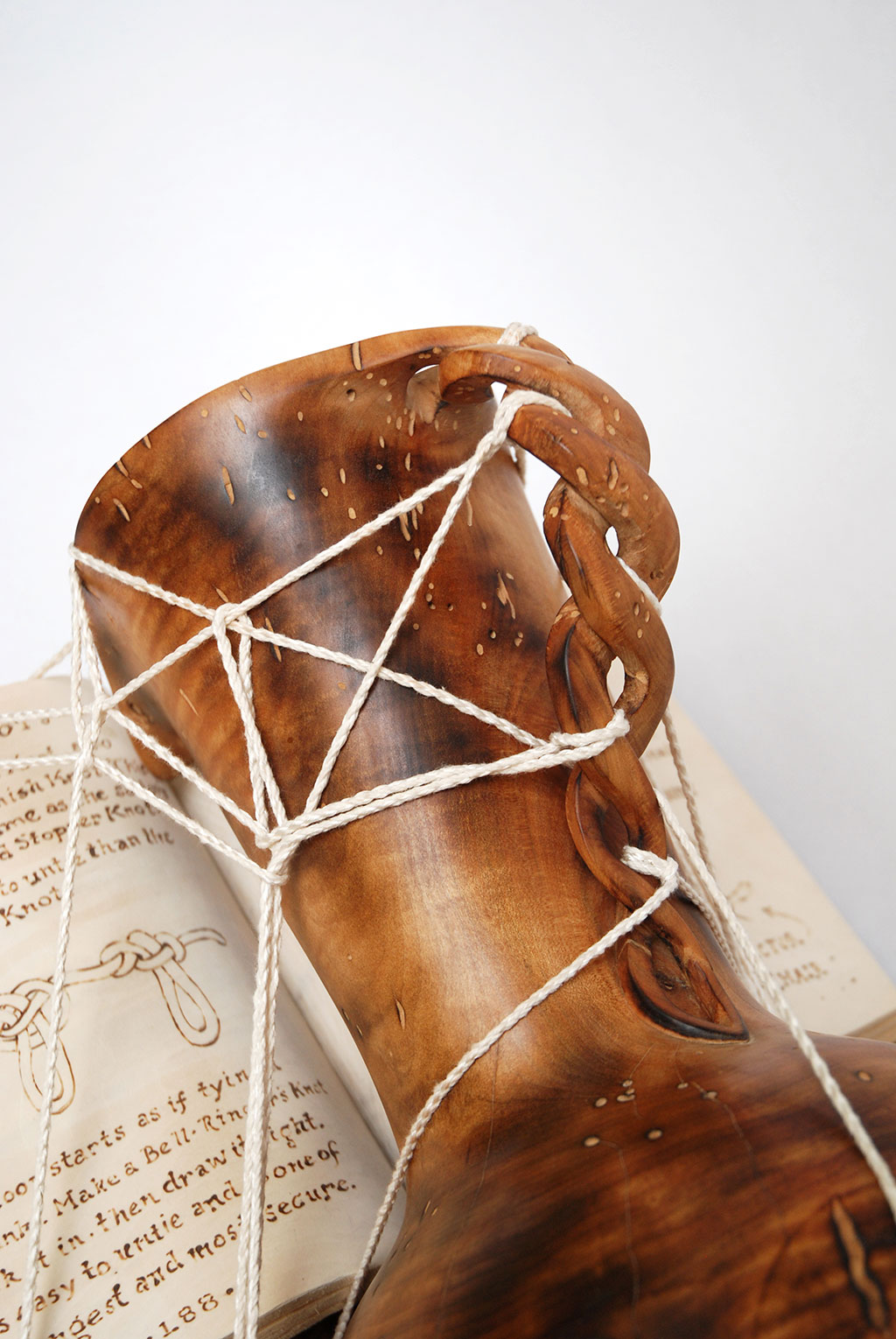
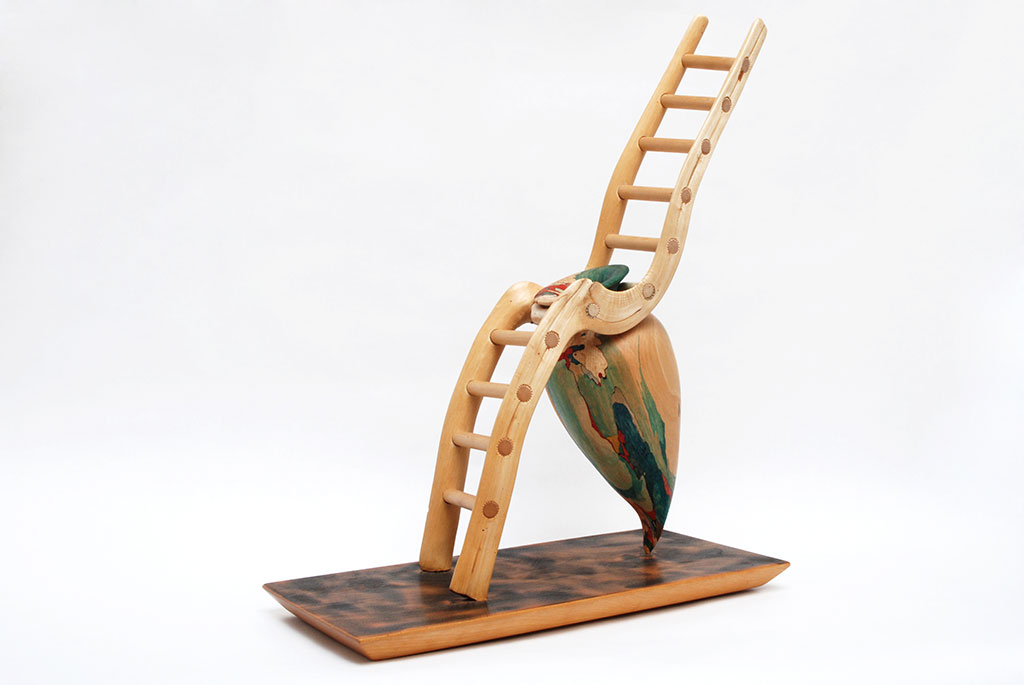
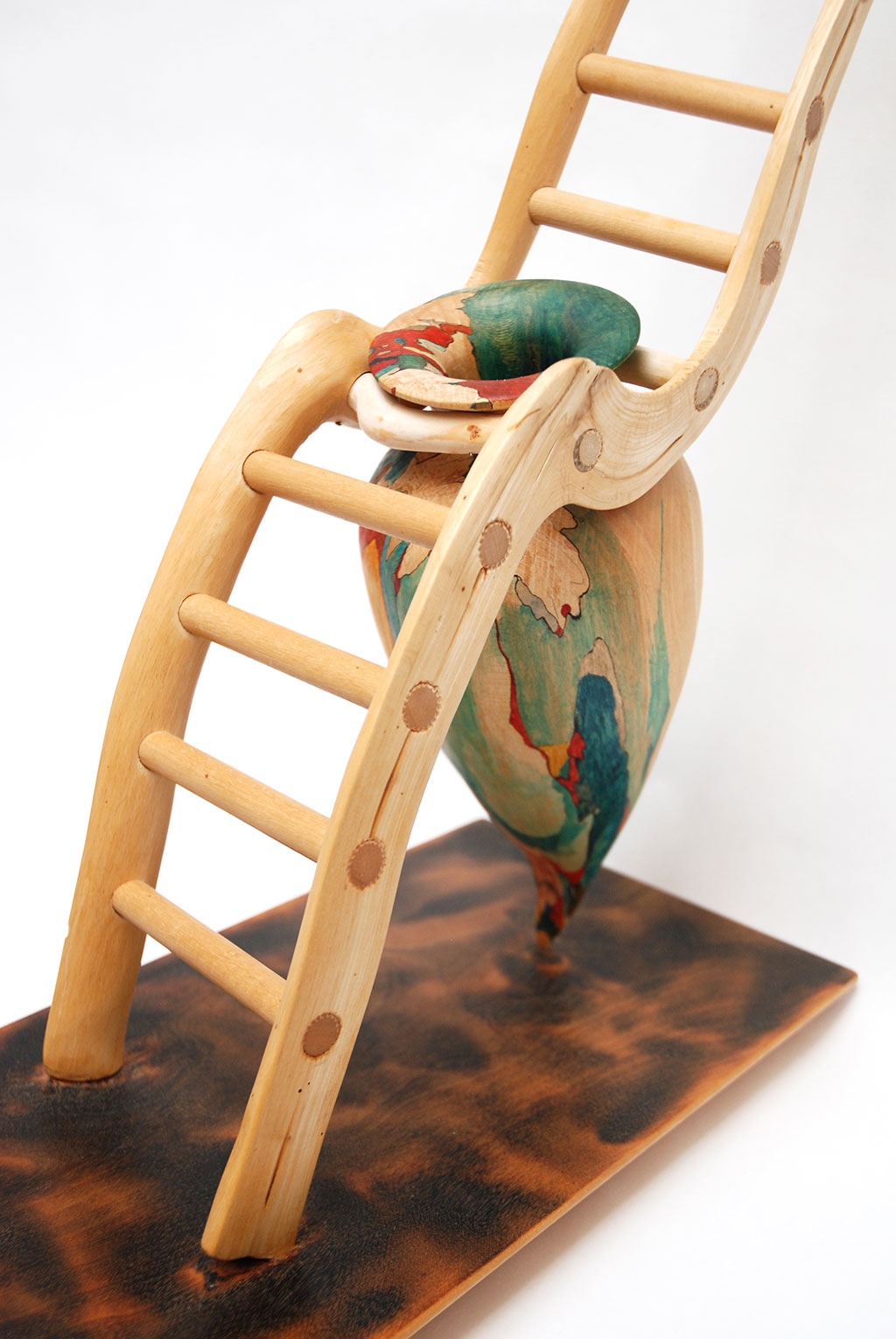
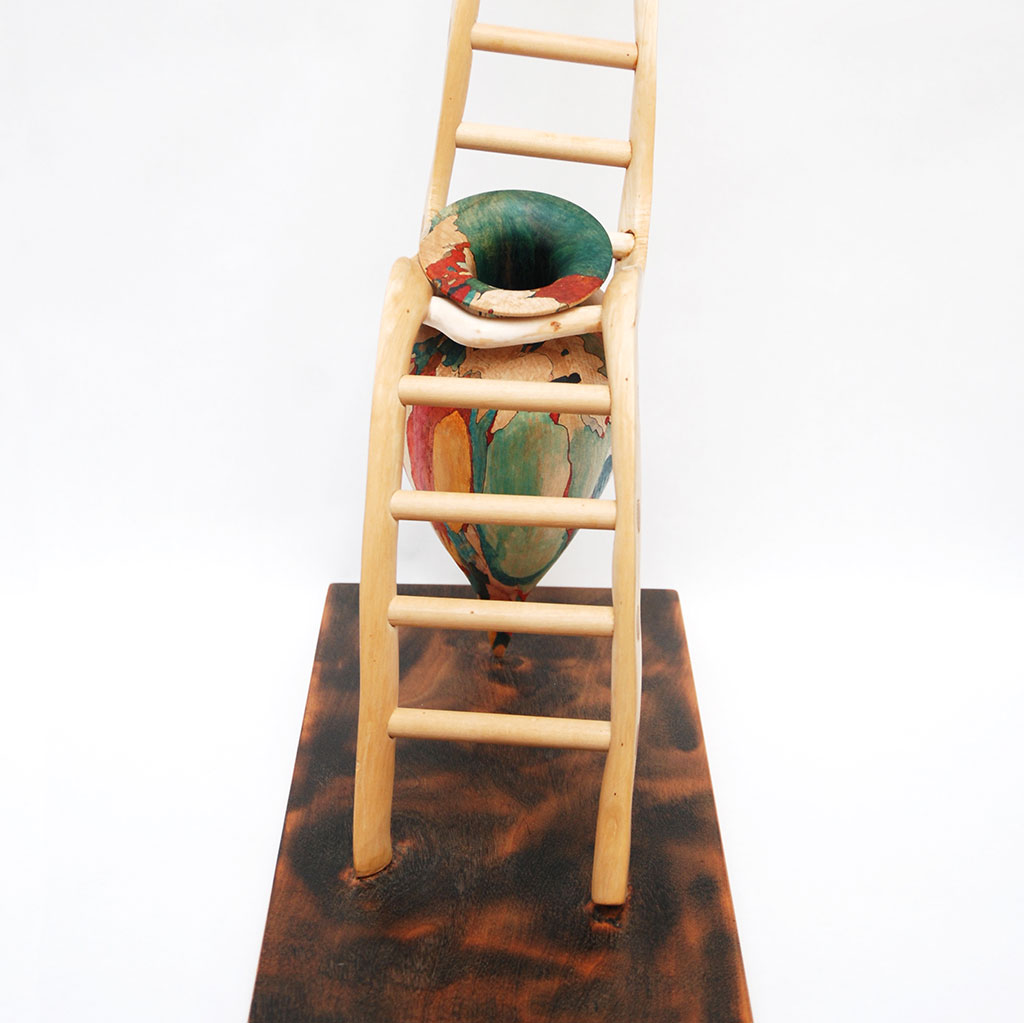
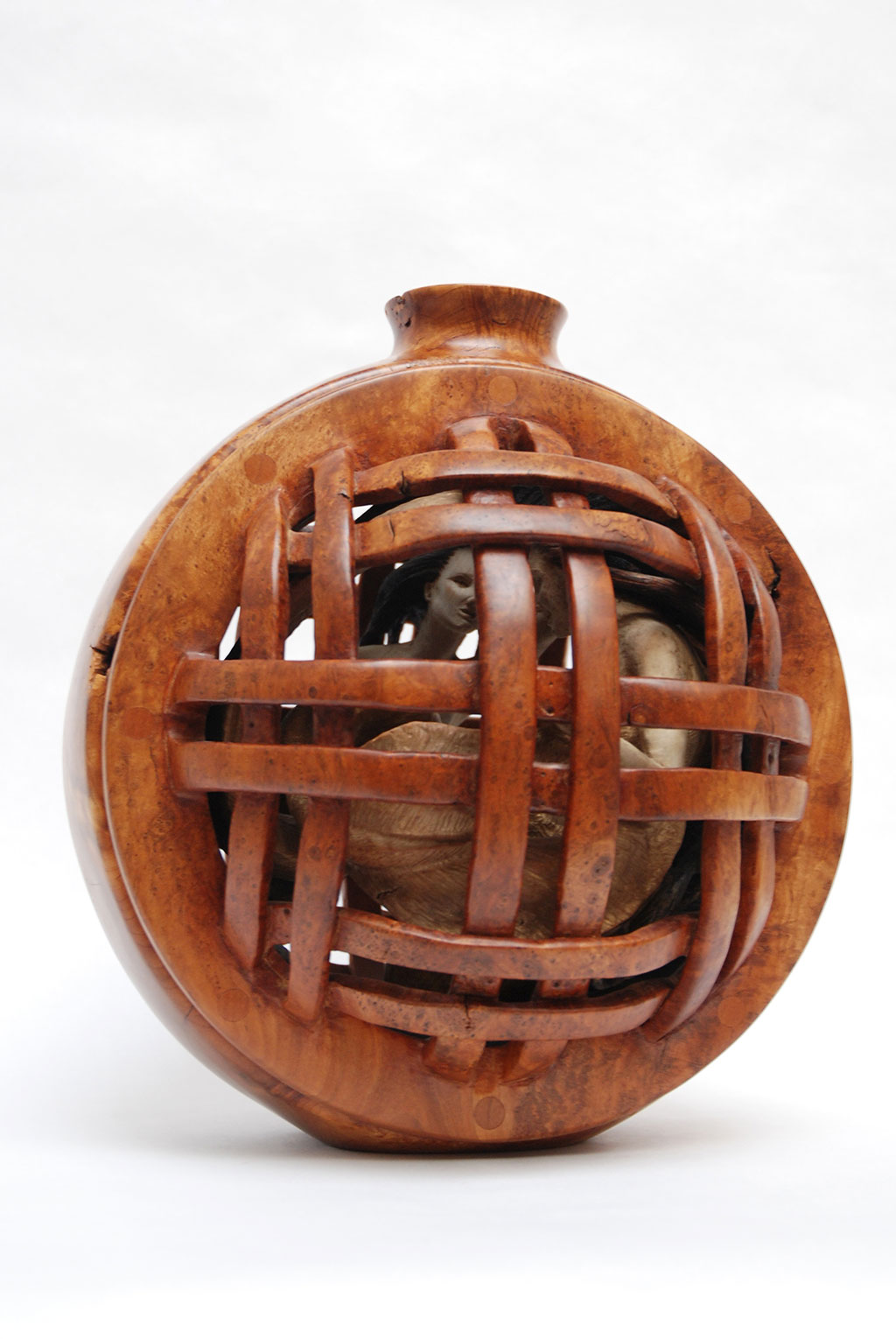
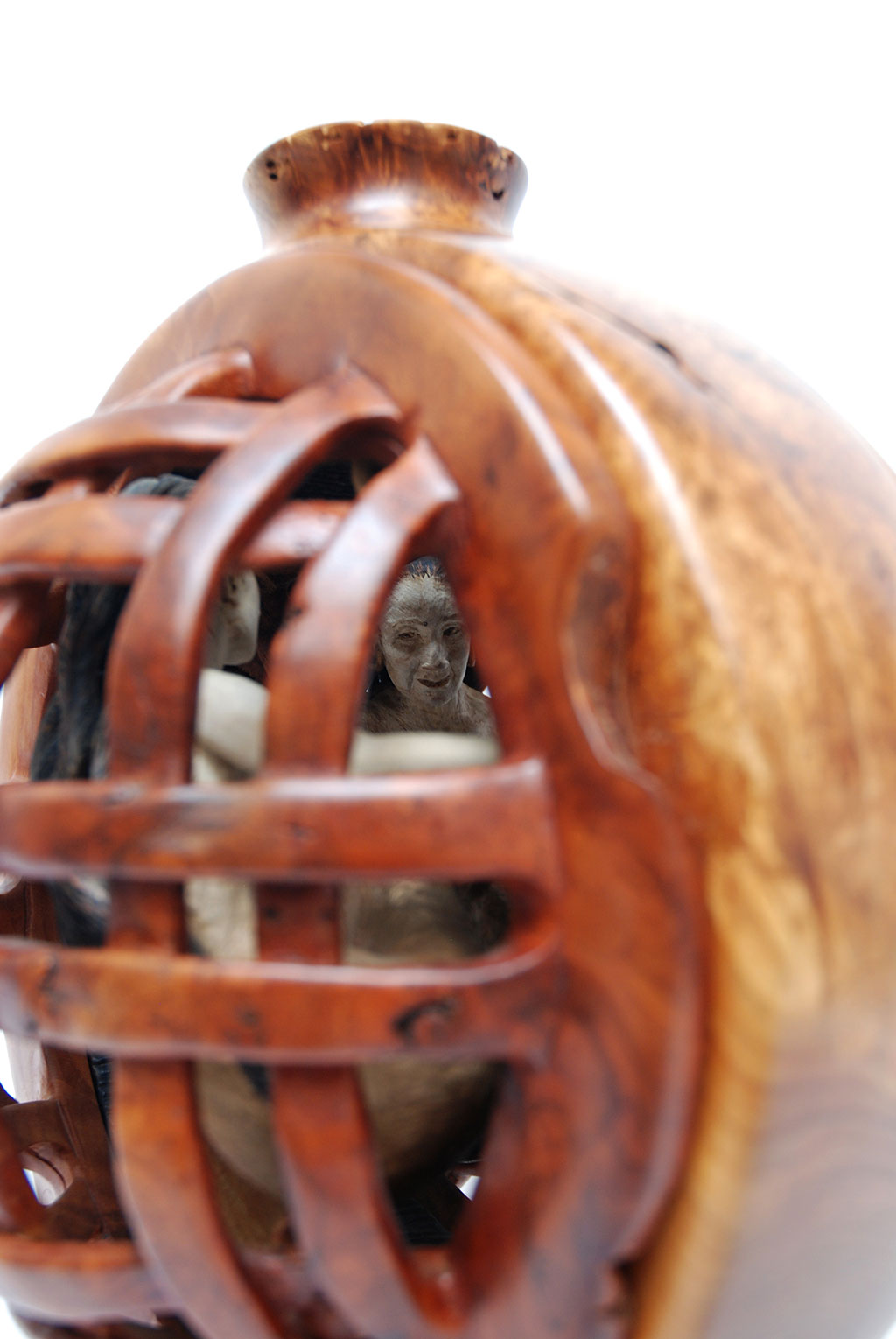
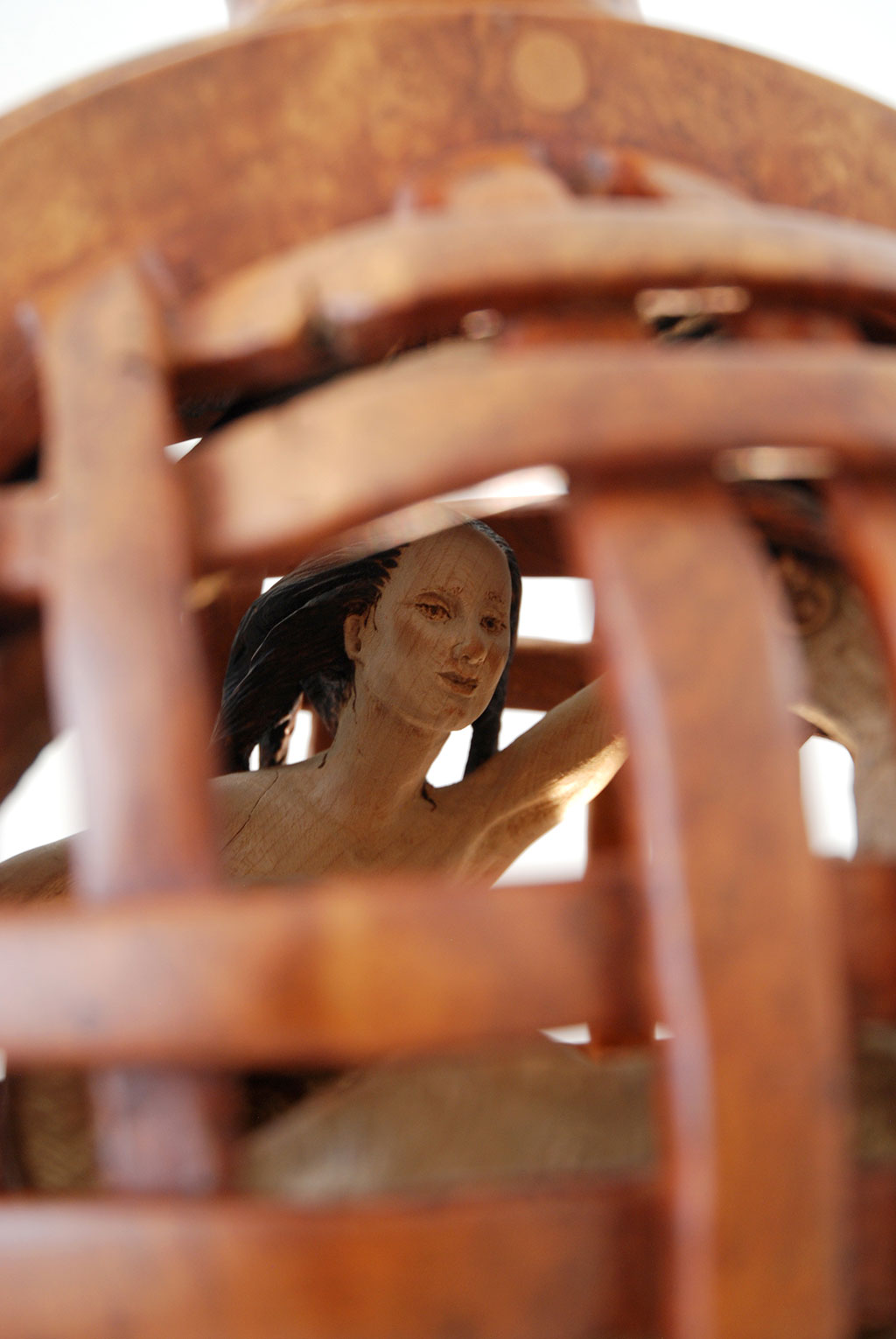
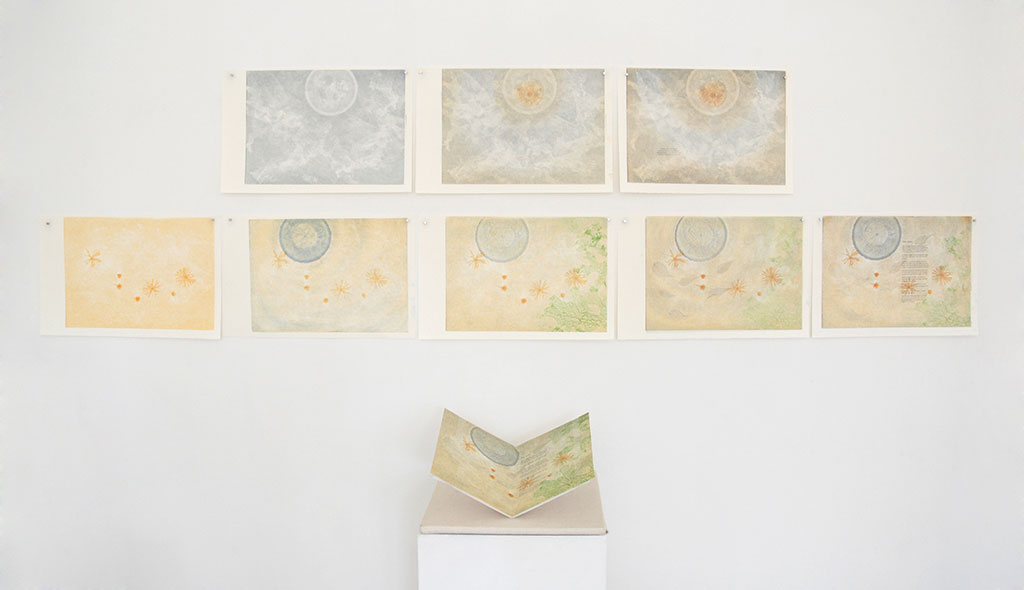
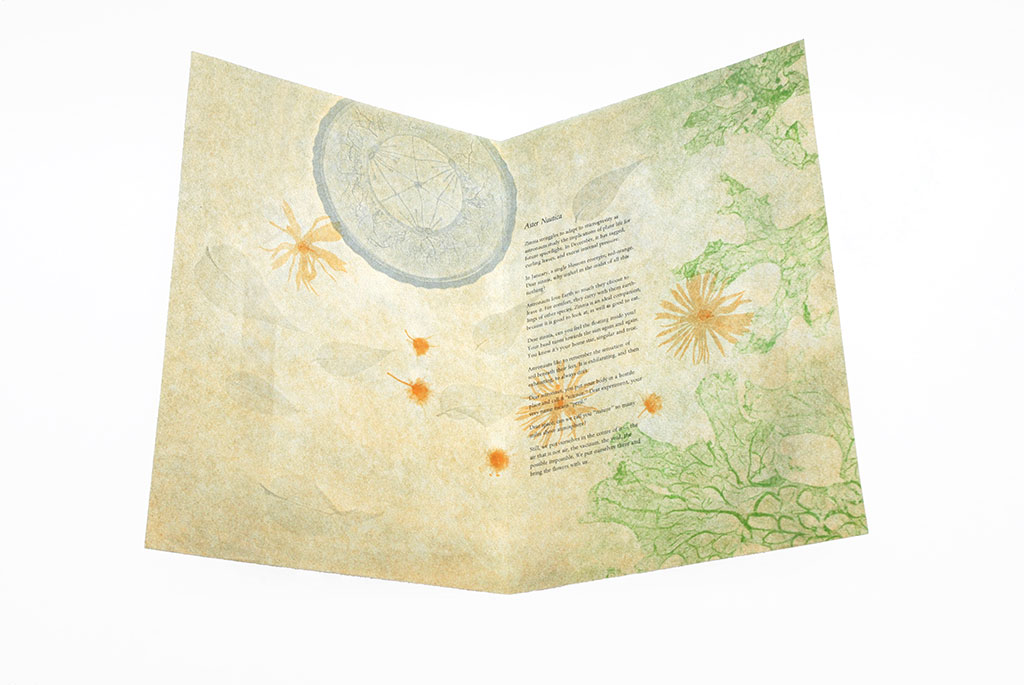
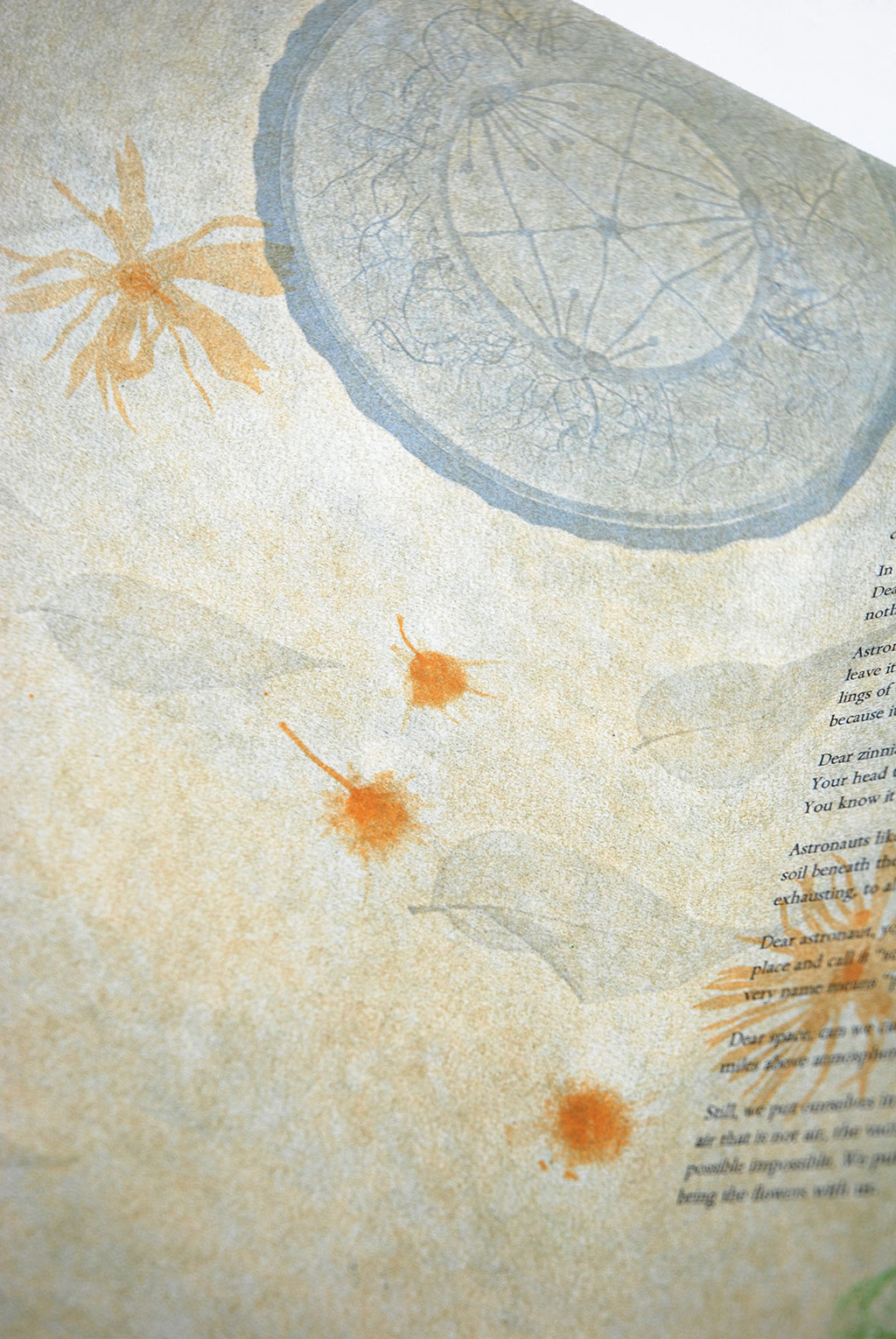
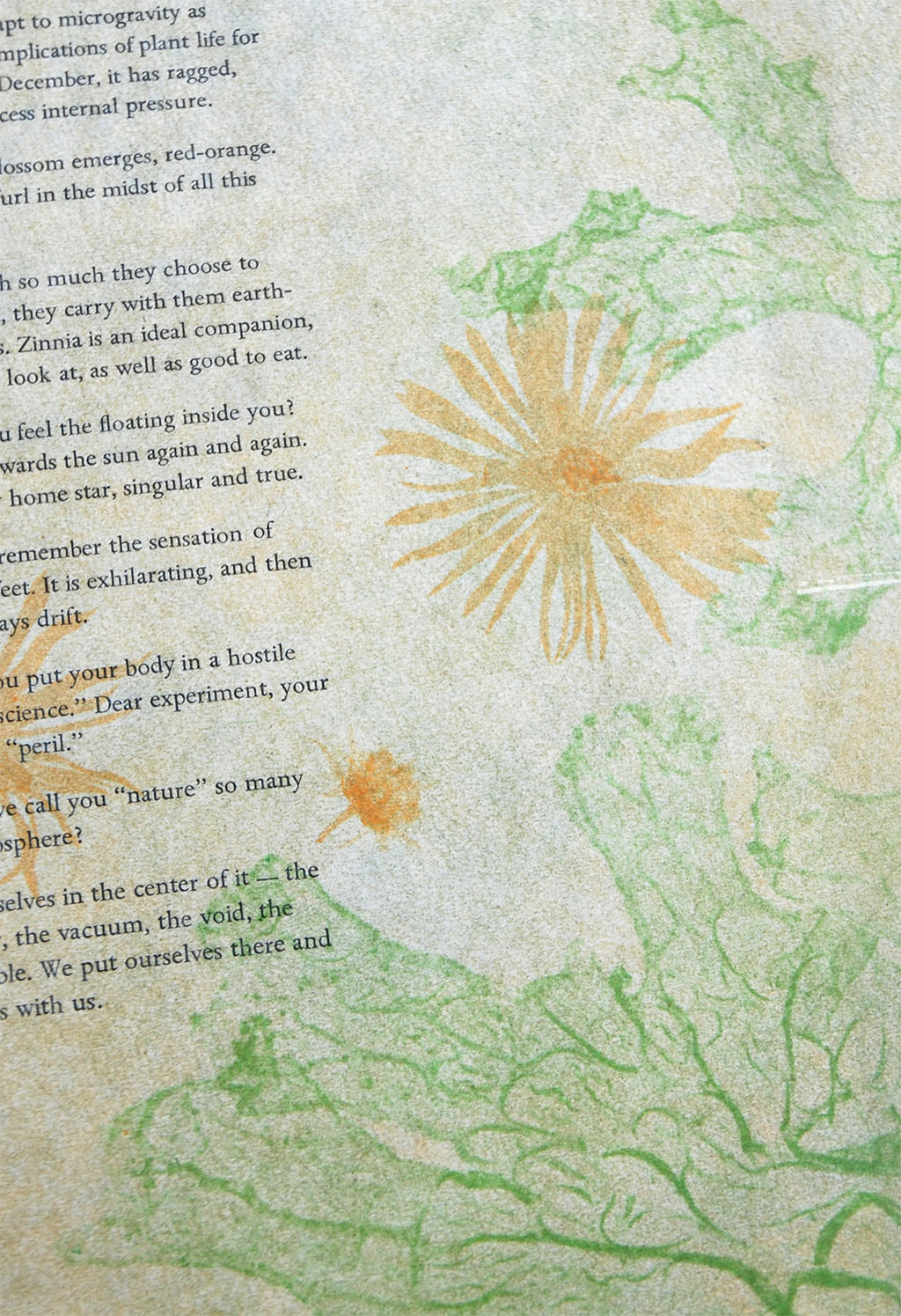
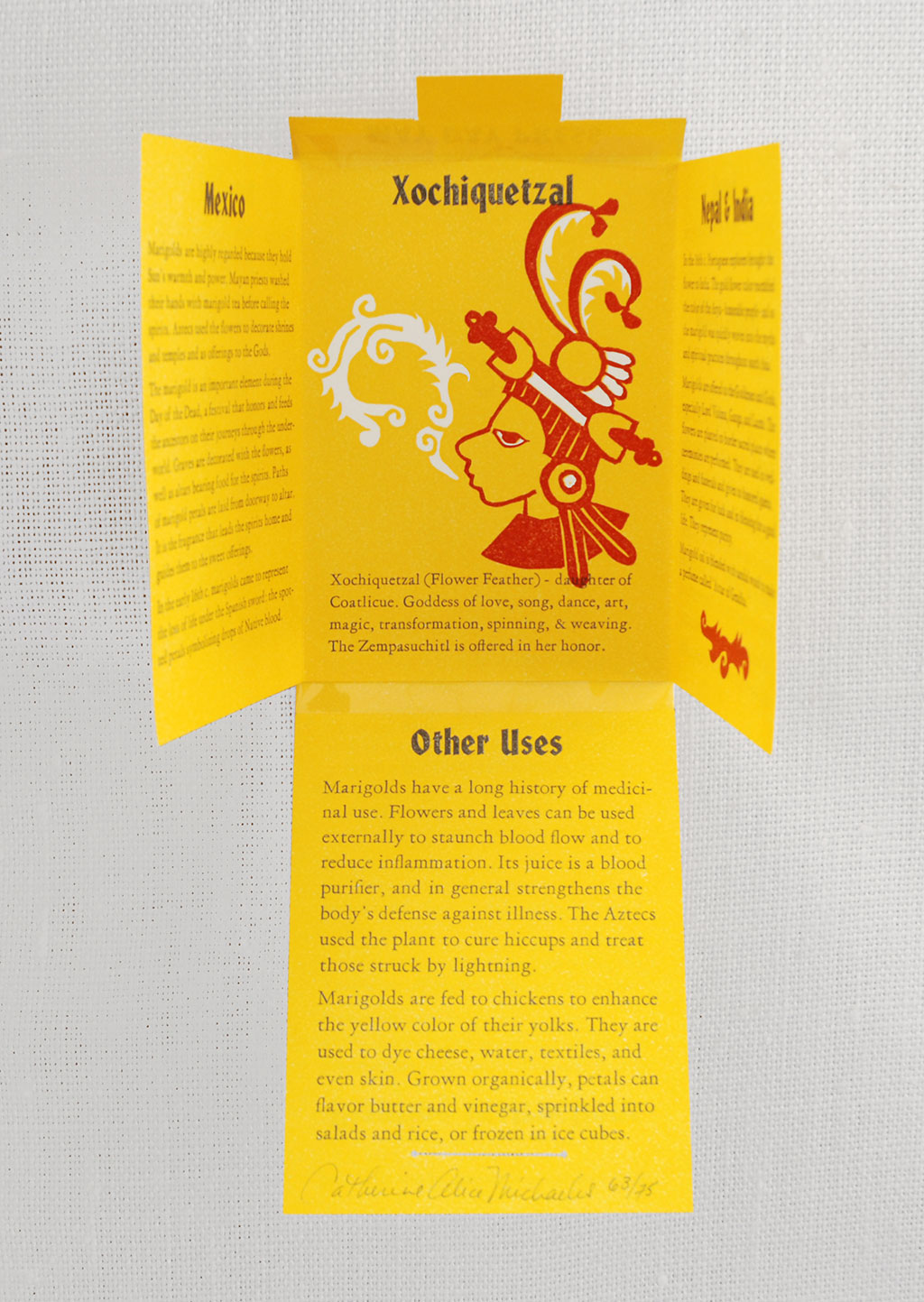
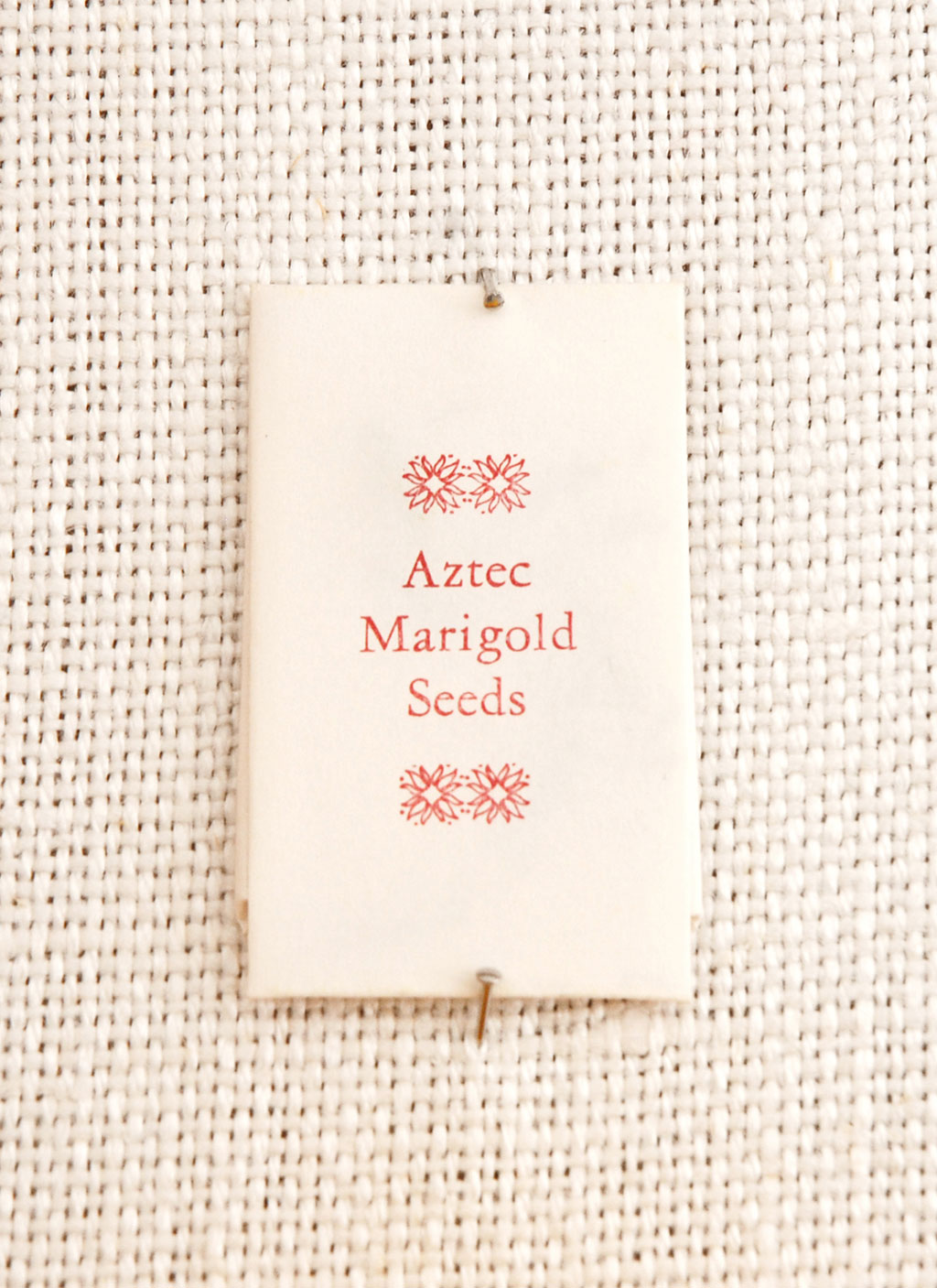
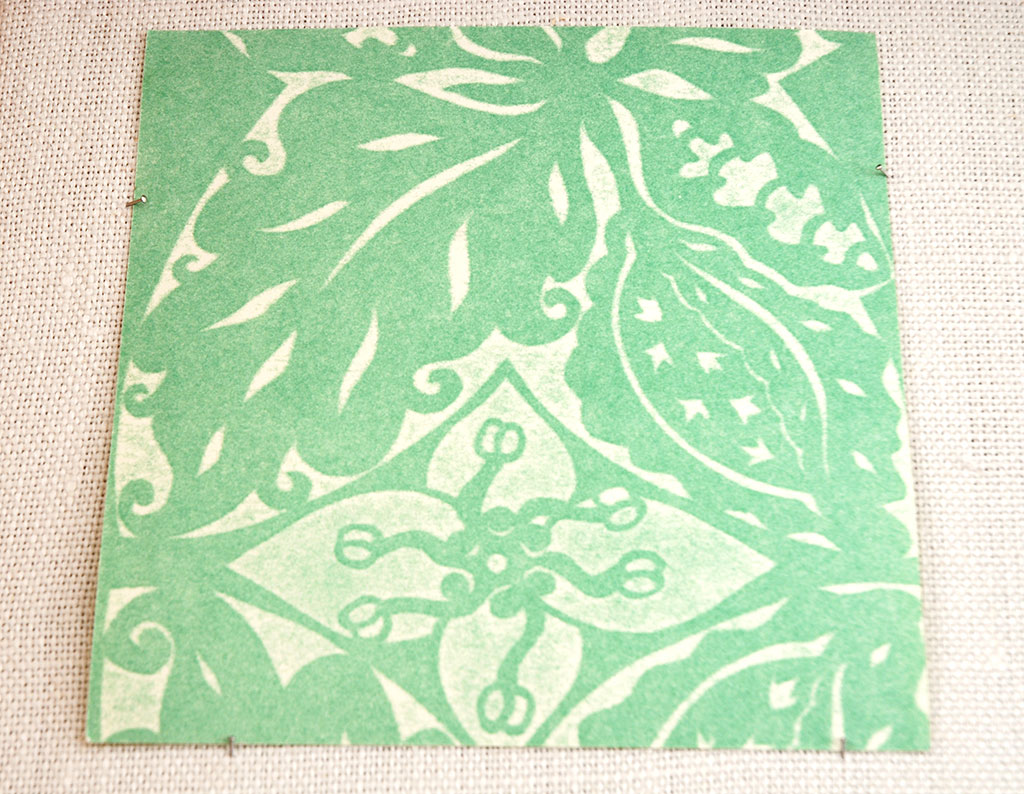
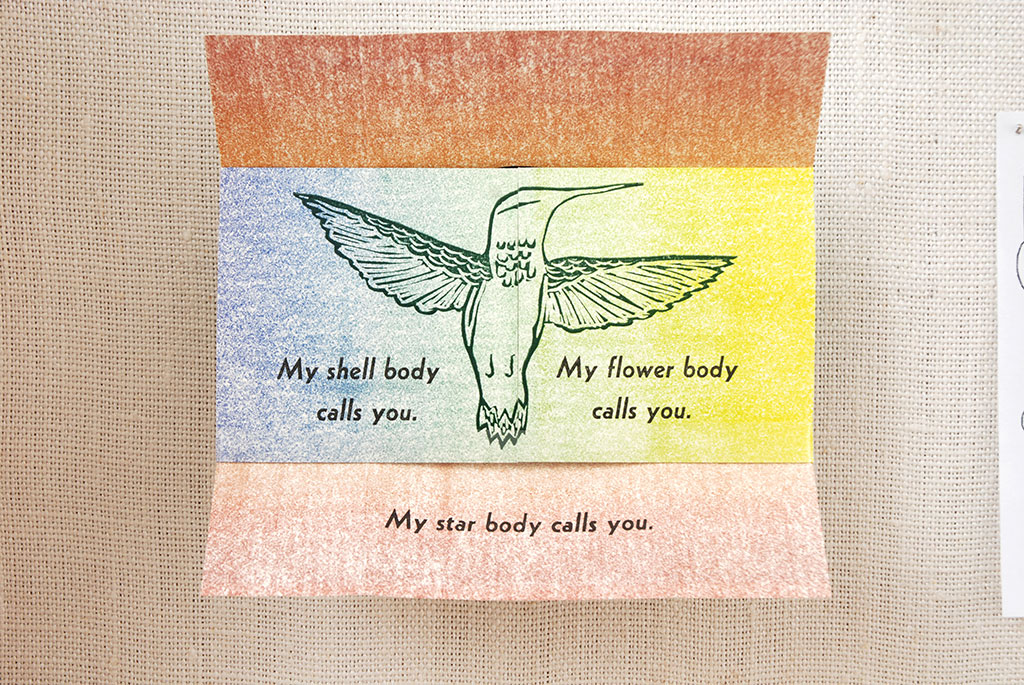
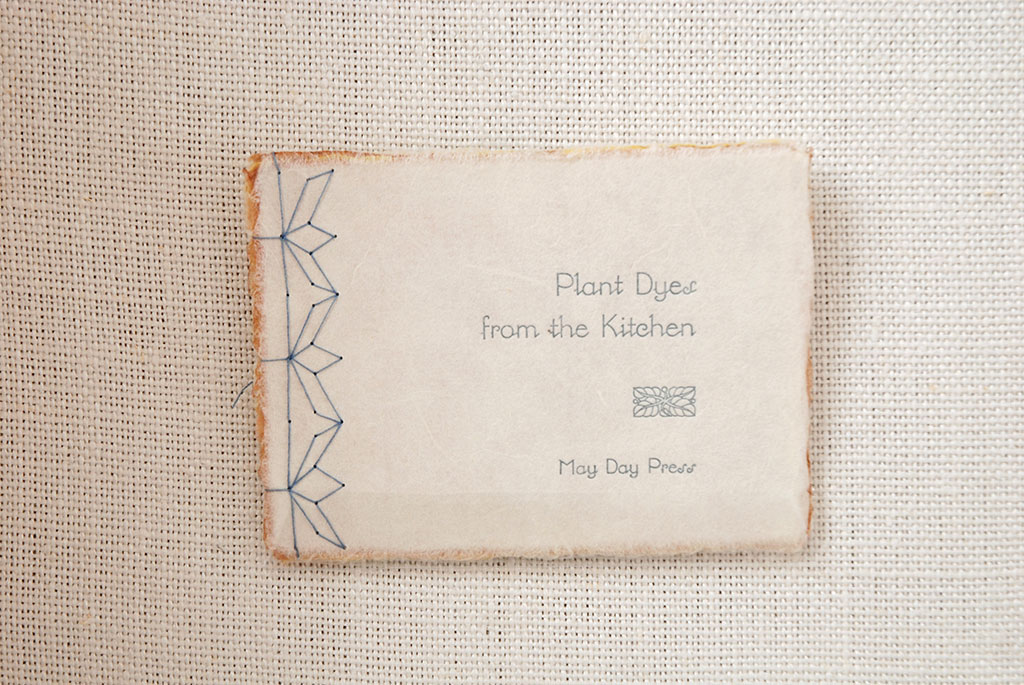
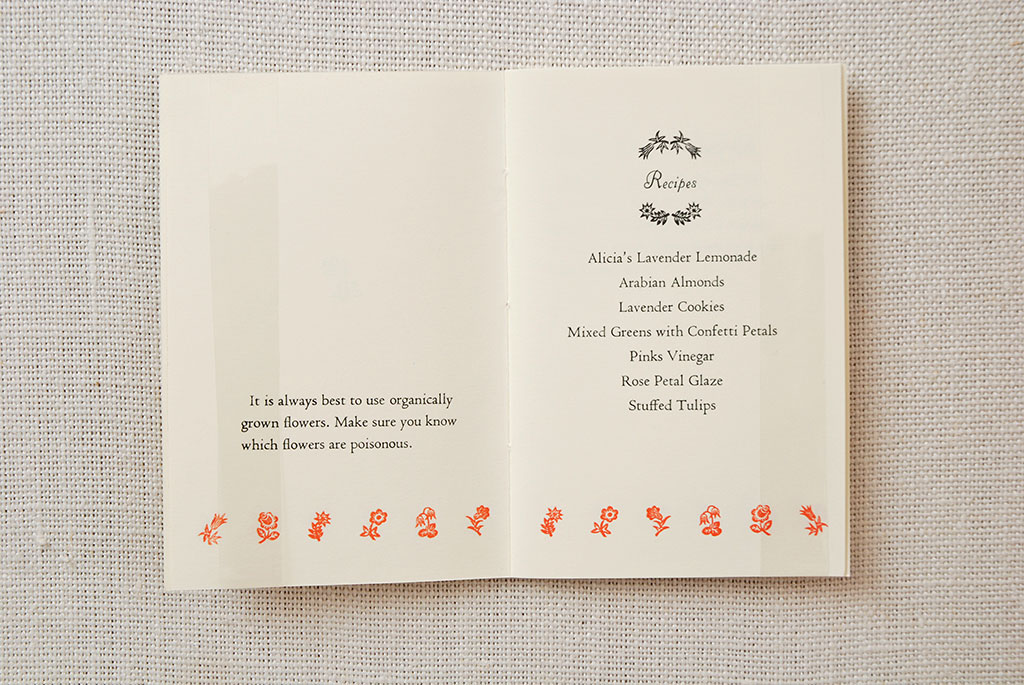
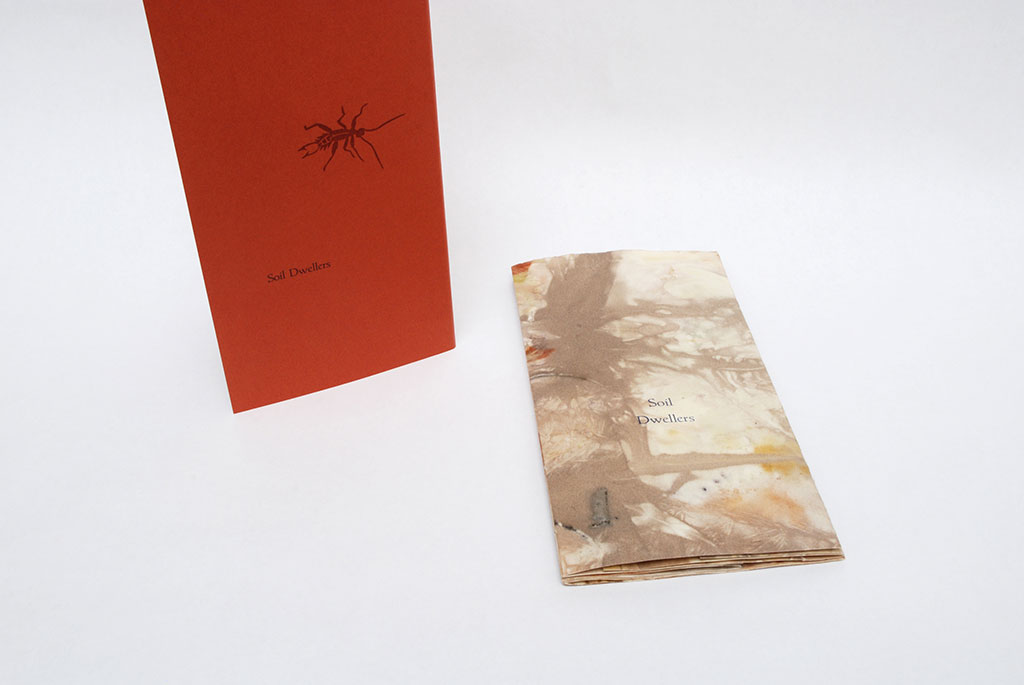
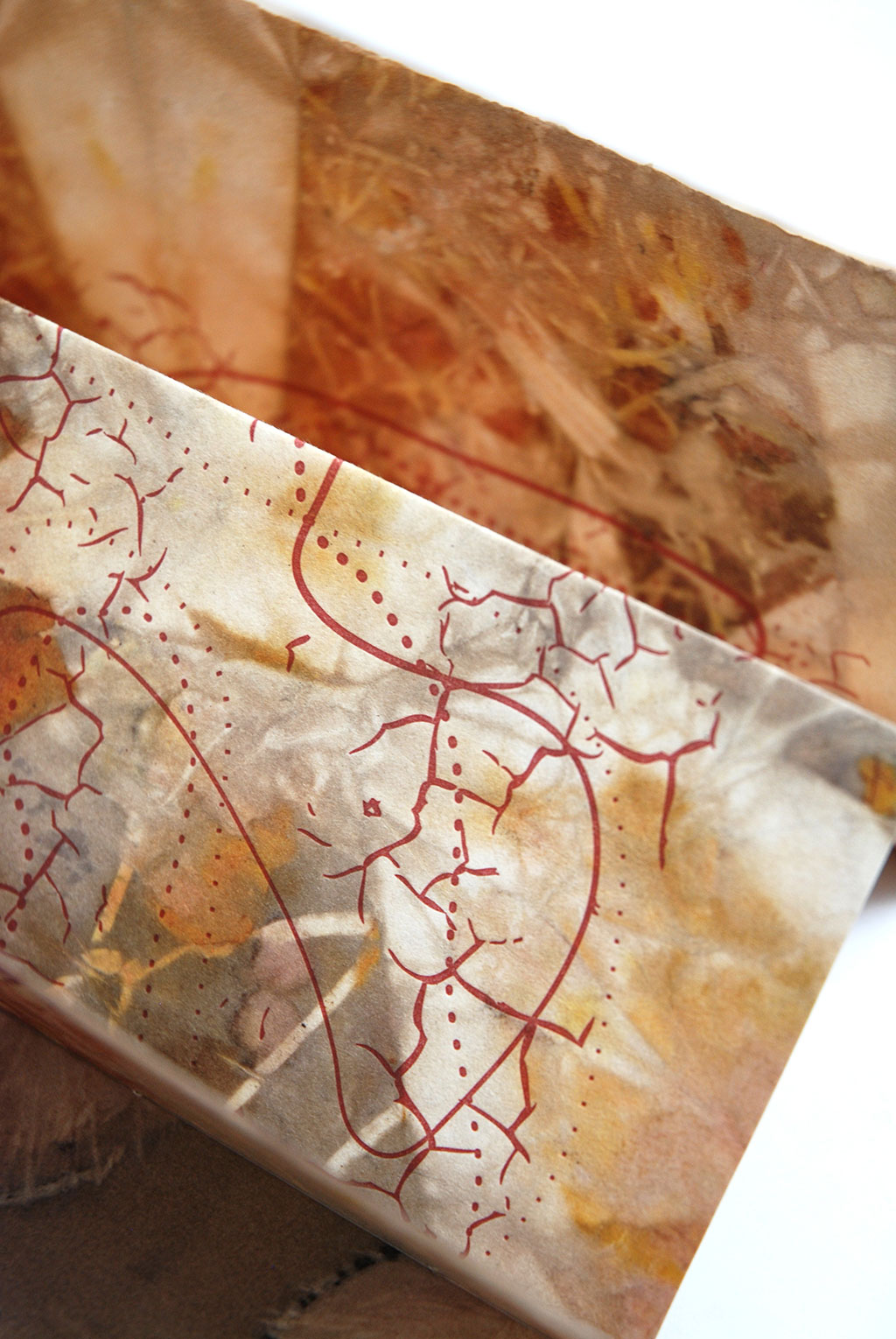
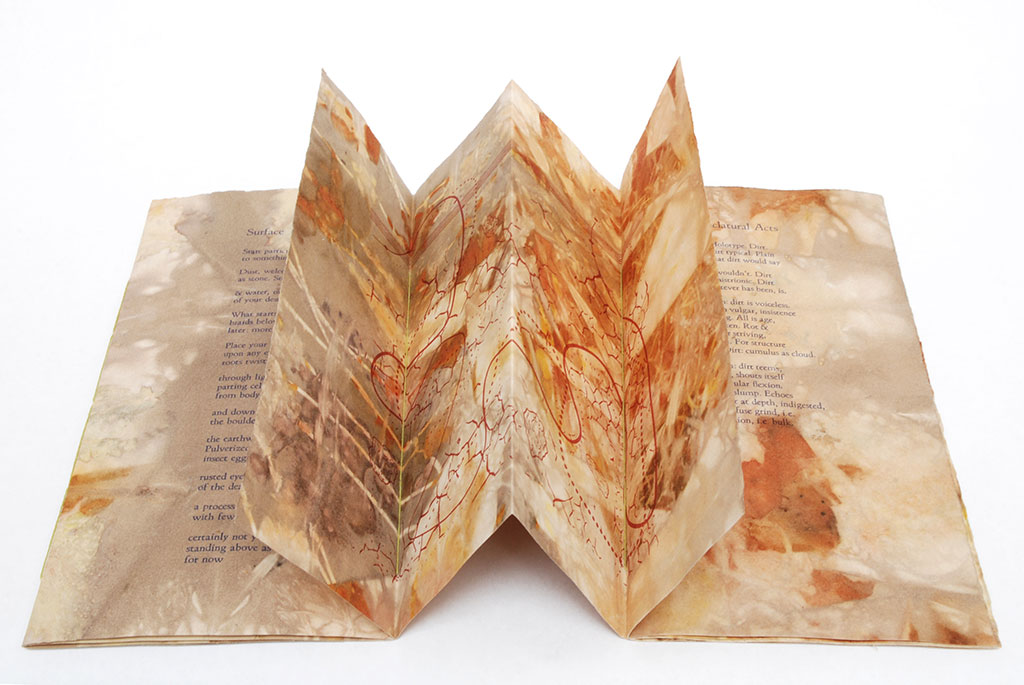
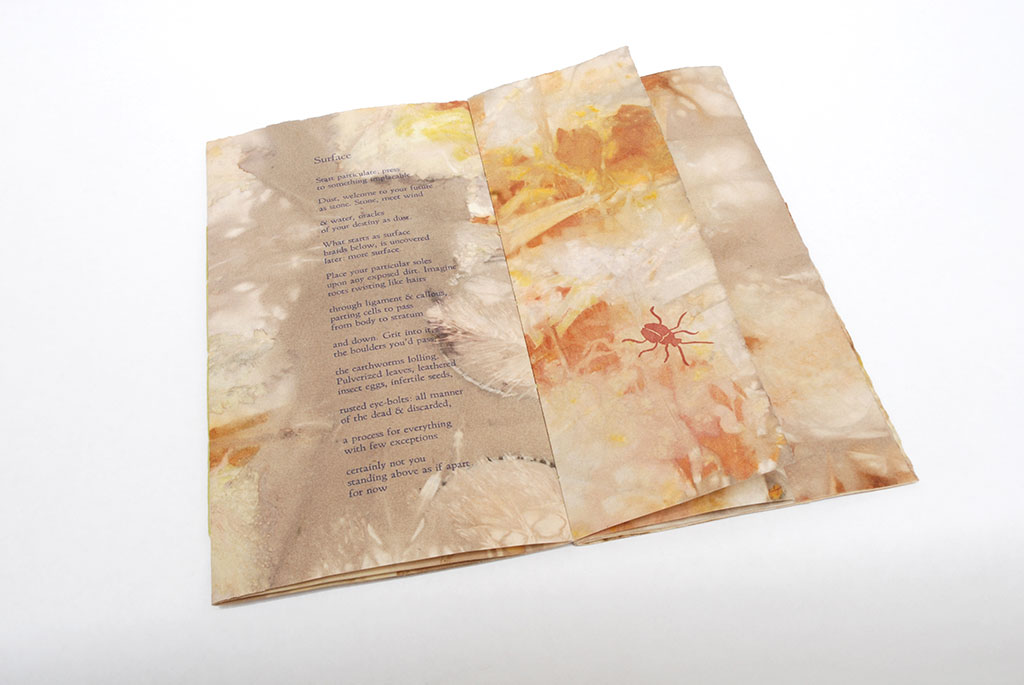
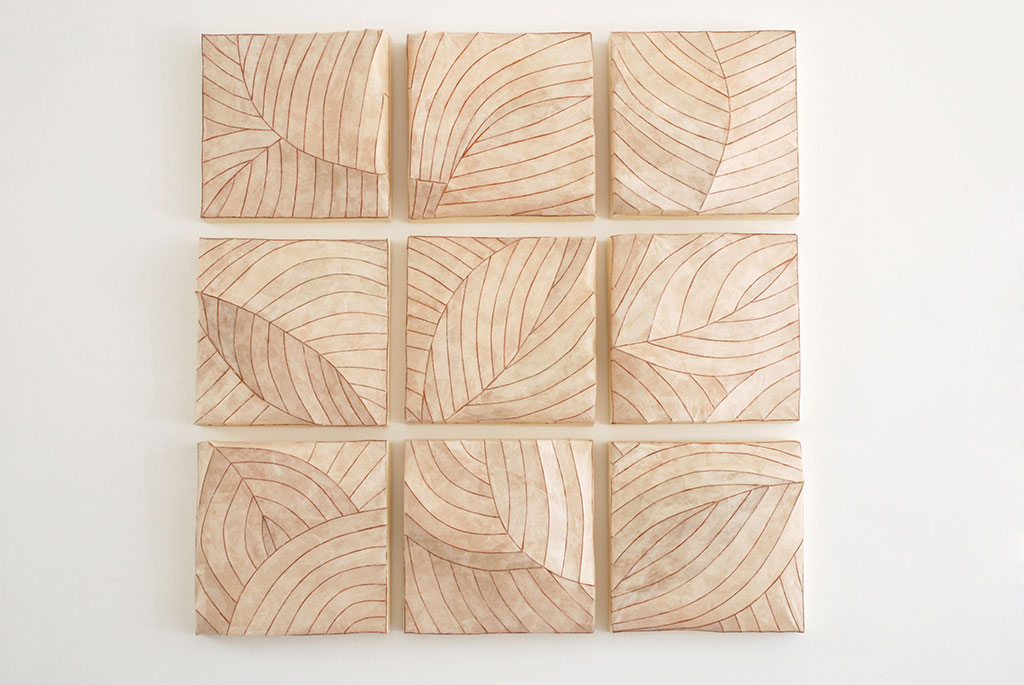
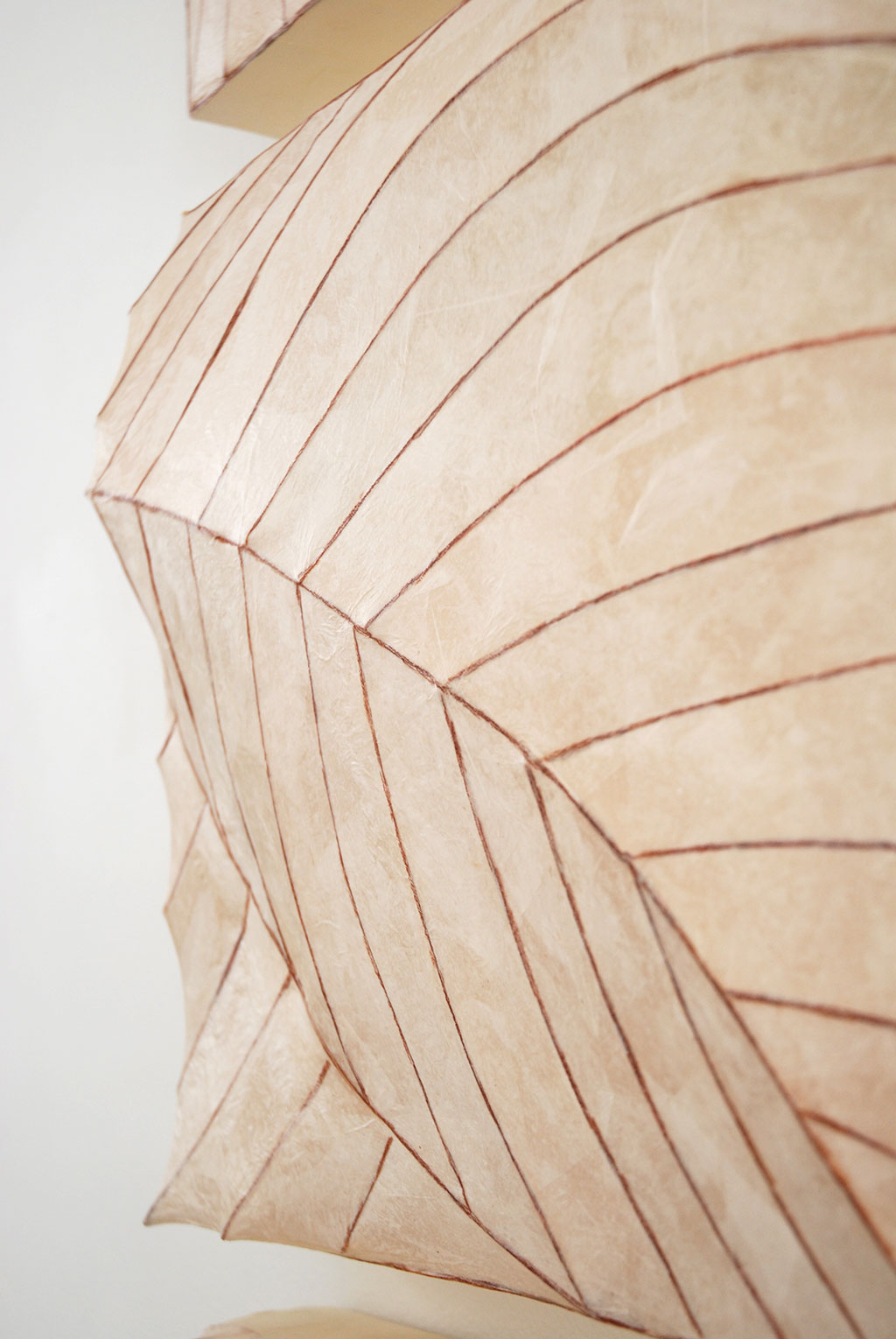
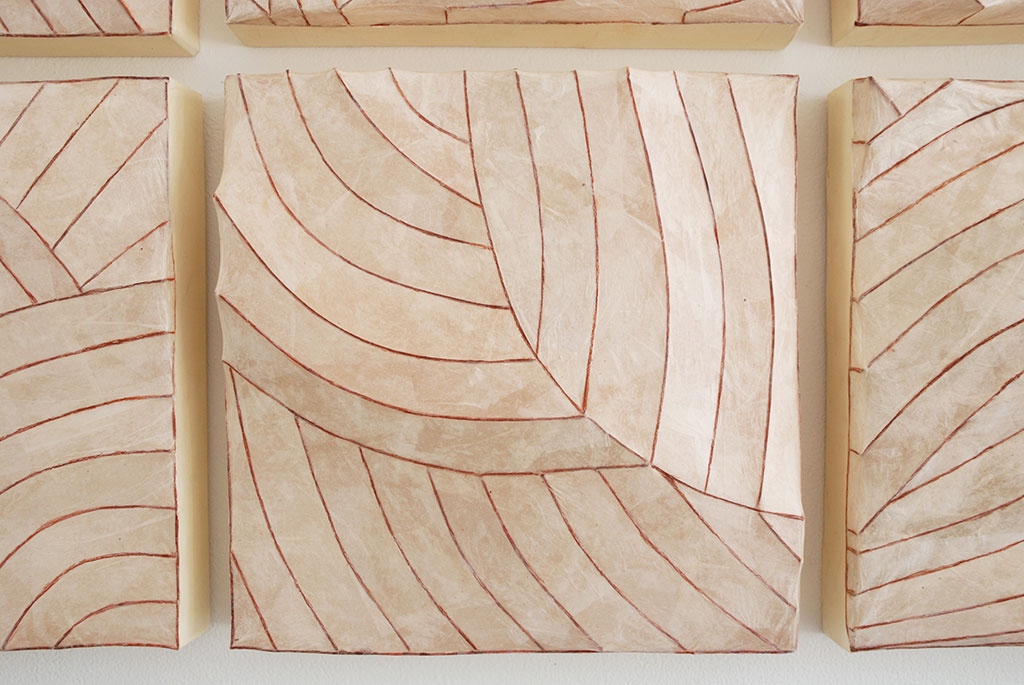
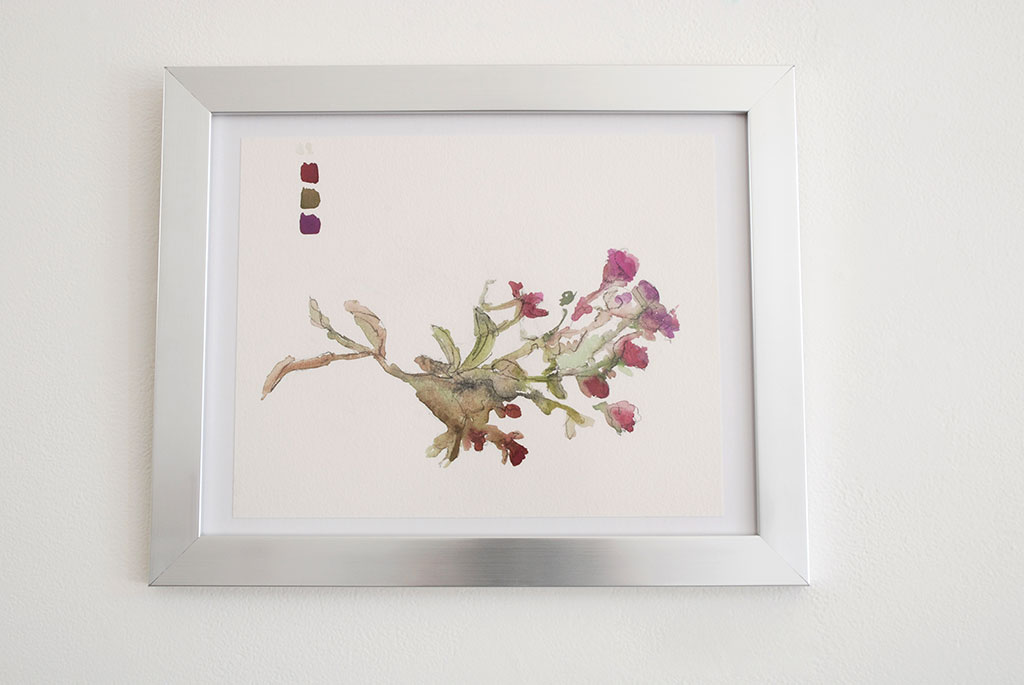
Photos by Madison Metro
CRAFT IN AMERICA: NATURE Artist Bios
CRAFT IN AMERICA: NATURE
ARTIST BIOS
PBS premiere: Friday, April 21, 2017 (*check local listings)
The beauty of the natural world – its colors, textures, shapes, even scents and tastes – have, since the beginning of recorded history, inspired artists to produce works of astonishing dimension and power. Working with the traditional craft materials of clay, wood, metal, glass and fiber as well as new materials, the artists profiled in NATURE challenge viewers to reassess their relationship to the natural world. They are eloquent crafters of the on-going conversation. Craft in America: NATURE premieres primetime, April 21, 2017 at 9pm* nationwide and is followed by Craft in America: MUSIC at 10pm. (*check local listings)
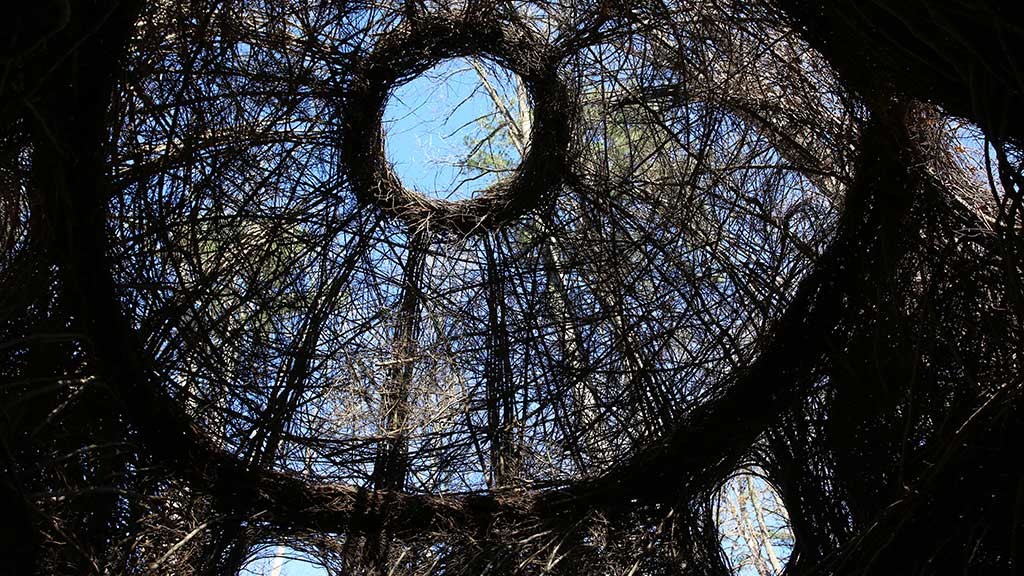
Patrick Dougherty was raised in the woodlands of North Carolina which deeply affected his choice of materials. He studied art history and sculpture at the University of North Carolina. Combining carpentry skills with his love of nature, Dougherty began to learn about primitive techniques of building and to experiment with tree saplings as construction material. Soon, his work evolved into monumental scale environmental works which required saplings by the truckloads. Over the last thirty years, he has built over 250 of these works, and his work has garnered international acclaim. He has received numerous awards, including the 2011 Factor Prize for Southern Art, North Carolina Artist Fellowship Award, Pollock-Krasner Foundation Grant, Henry Moore Foundation Fellowship, Japan-US Creative Arts Fellowship, and National Endowment for the Arts Fellowship. Princeton Architectural Press published a major book about Patrick and his work in 2009. “I think that part of my work’s allure is its impermanence, the life cycle that is built into the growth and decay of saplings.”
www.stickwork.net
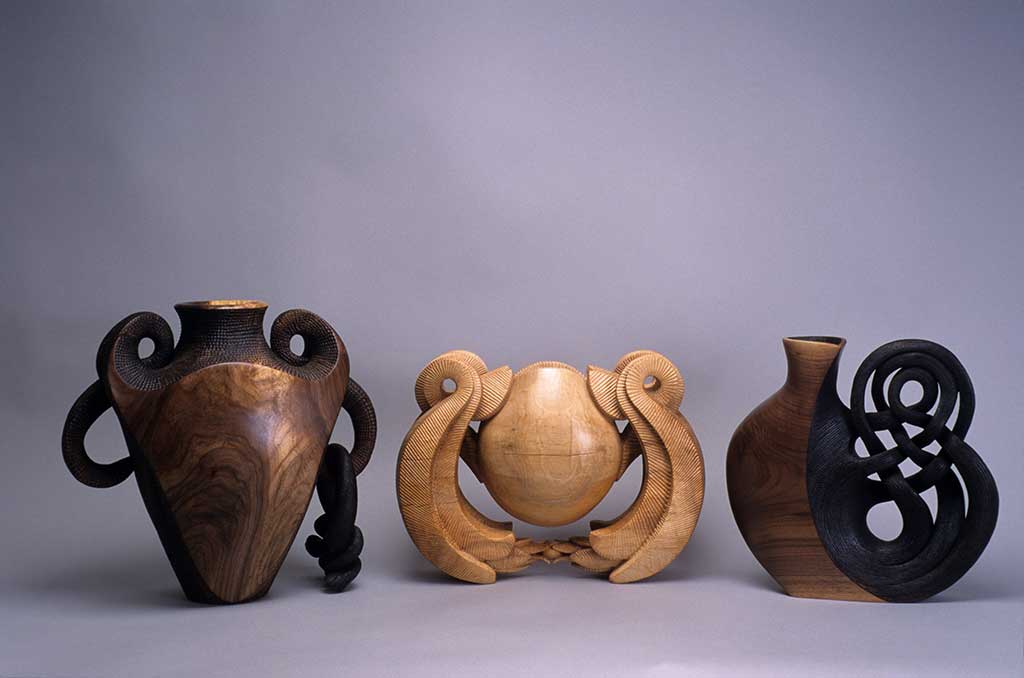
Michelle Holzapfel uses the materials, tools and techniques of woodworking to render images from daily life: textile, plant, animal and human forms. This vocabulary emphasizes the tactile possibilities of wood: from smoothly pleated forms and carved basketweave motifs to corduroy-textured surfaces. In 1976, Michelle and David Holzapfel opened Applewoods’ Studio and Gallery in the southern Green Mountains of Vermont. Their handmade/hard-carved furniture and vessels can be found in the collections of the Boston Museum of Fine Arts, The Museum of Art and Design in New York, and the Smithsonian American Art Museum Washington, DC in addition to numerous businesses and private homes throughout North America. holzapfelwoodworking.com/michelle-holzapfel

Fiber artist Mary Merkel-Hess makes sculptural vessels and wall pieces inspired by the landscape of Iowa where she was born, raised and still lives. She has participated in numerous national and international exhibitions and her pieces are in the permanent collections of the Metropolitan Museum of Art, New York; Museum of Art and Design, New York; Philadelphia Museum of Art, Philadelphia; Fuller Craft Museum, Brockton, MA; Racine Museum of Art, Racine, WI; and the Renwick Gallery, Smithsonian American Art Museum, Washington, DC.
marymerkelhess.com

Preston Singletary’s work is ground-breaking. He has invented many layering and etching techniques while creating his stunning glass forms embellished with strong Tlingit images of his Native American culture. His practice and work continue to evolve, connecting his personal cultural perspective to modern art movements. He is regarded as an important influence on contemporary indigenous art. Recognized internationally, Singletary’s artworks are included in museum collections such as The British Museum, London, UK, The Museum of Fine Arts, Boston, MA, The Seattle Art Museum, Seattle WA, the Corning Museum of Glass, Corning, NY, the Mint Museum of Art and Design, Charlotte, NC, the Heard Museum, Phoenix, AZ, and the Smithsonian Institution, Washington, DC. In 2009, a mid-career survey of his work was held at the Museum of Glass, Tacoma, WA. Additionally, he teaches, lectures and accepts commissions. “Preston Singletary: Raven and the Box of Daylight”will be exhibited in 2018 at the Museum of Glass, Tacoma, WA.
prestonsingletary.com
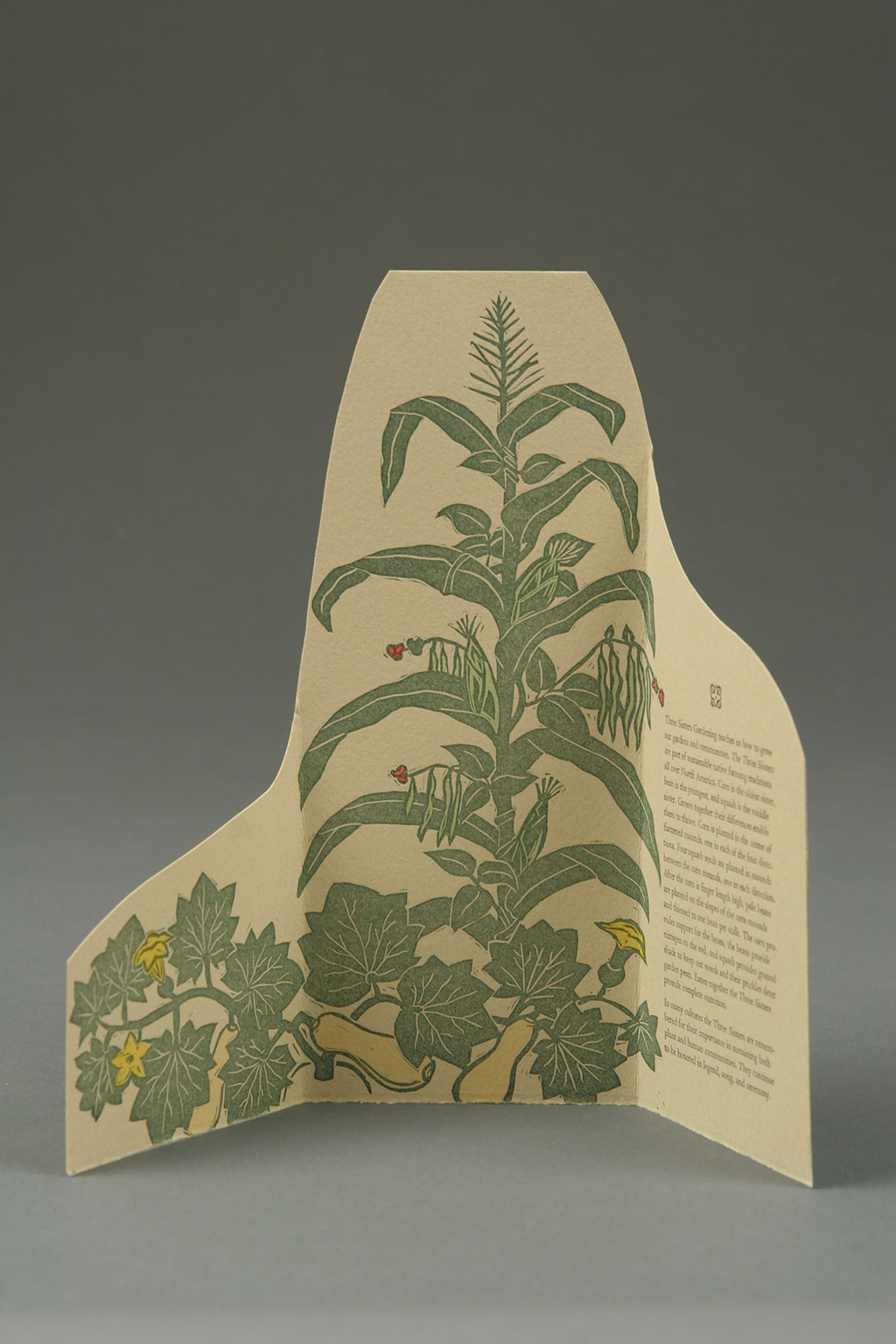
Catherine Alice Michaelis launched May Day Press on May 1st, 1992. She prints on a Vandercook 4 proof press and a 10×15 C & P letterpress and is located near Shelton, WA by the South Salish Sea, working “amidst cedars, ravens, and eagles overhead, and trilliums, salal, and mahonia underfoot”. In 2011, to re-inform her art practice, she undertook the study of film, video and creative non-fiction writing. “Through artist books my creative worlds merge: I gravitate to plants for image making, immerse myself in research, collect, and write stories. I bring image and text together through needle and thread, highlighting sewing in much of my work. Recently influenced by early 20th century poets and book artists who were inspired by the moving image at the advent of film and who largely drove the experimental film movement in Europe, I straddle the 15th century of letterpress and the 21st century of film and videography, reveling in moving word and image on the screen through light, sound, and color.” “Imprinted & Unbound” was shown recently at the Bainbridge Island Museum of Art, Bainbridge Island, WA. Her work is featured in numerous prominent art collections – public and private.
www.catherine-alice.com
#####
CRAFT IN AMERICA is a non-profit organization dedicated to advancing original handcrafted work through the Peabody Award-winning documentary series on PBS nationwide and the free-to-the-public Craft in America Center located in Los Angeles, which offers artist talks, exhibitions, workshops and a library. With seventeen episodes produced since 2007, CRAFT IN AMERICA takes viewers on a journey to the artists, origins and techniques of American craft. Each episode contains stories from diverse regions and cultures, blending history with living practice and exploring issues of identity, ritual, philosophy and creative expression. Our websites craftinamerica.org and pbs.org/craftinamerica provide all episodes, hours of online videos and interactive learning materials, as well as object exhibitions, artist information, the Random House book Craft in America: Celebrating Two Centuries of Artists and Objects, and other Craft in America publications.
Nature: Highlights from the Episode gathers together the work of the artists who are featured in the episode. These artists explore the beauty and wonder of the natural world. This exhibition opens March 18, 2017 thru May 13, 2017 at the Craft in America Center (8415 W. Third St. Los Angeles, CA 90048).
For more about Craft in America:
craftinamerica.org
pbs.org/craftinamerica
facebook.com/craftinamerica
youtube.com/craftinamerica
instagram.com/craftinamerica
twitter.com/CraftinAmerica
Photos courtesy of Mark Markley, Michelle Holzapfel, Brianna Brough/Chapel Hill Magazine, Russell Johnson
Please contact for art and interviews: (310) 659-9022
Lauren Over, Communications: press@craftinamerica.org
Additional images of all the artists’ work are available on Dropbox (74 MB): https://dl.dropboxusercontent.com/u/21500868/NATUREpress.zip
CRAFT IN AMERICA: NATURE Premieres April 21 2017 Earth Day Weekend
FOR IMMEDIATE RELEASE
July 19, 2016
[Los Angeles] – Craft in America, the Peabody Award-winning series, continues its eighth season on PBS with NATURE, celebrating the beauty, inspiration, and future of the American landscape. Craft in America: NATURE airs on PBS, Friday, April 21, 2017 at 9pm followed by Craft in America: MUSIC at 10pm. (*check local listings)
Working with wood, glass and fiber as well as new materials, the artists profiled in NATURE challenge viewers to reassess their relationship to the natural world. Throughout history, the colors, textures, shapes, as well as scents and tastes of the physical world have inspired artists to produce works of astonishing dimension and power.
By emphasizing the profound connection between art and society, NATURE continues a hallmark of Craft in America: positioning artists as participants in larger global concerns while at the same time honoring them as pure visionaries. The women and men profiled in this hour are first and foremost artists, but in their direct inspirations from the environment, they are part of the important on-going conversation about the future of this planet.
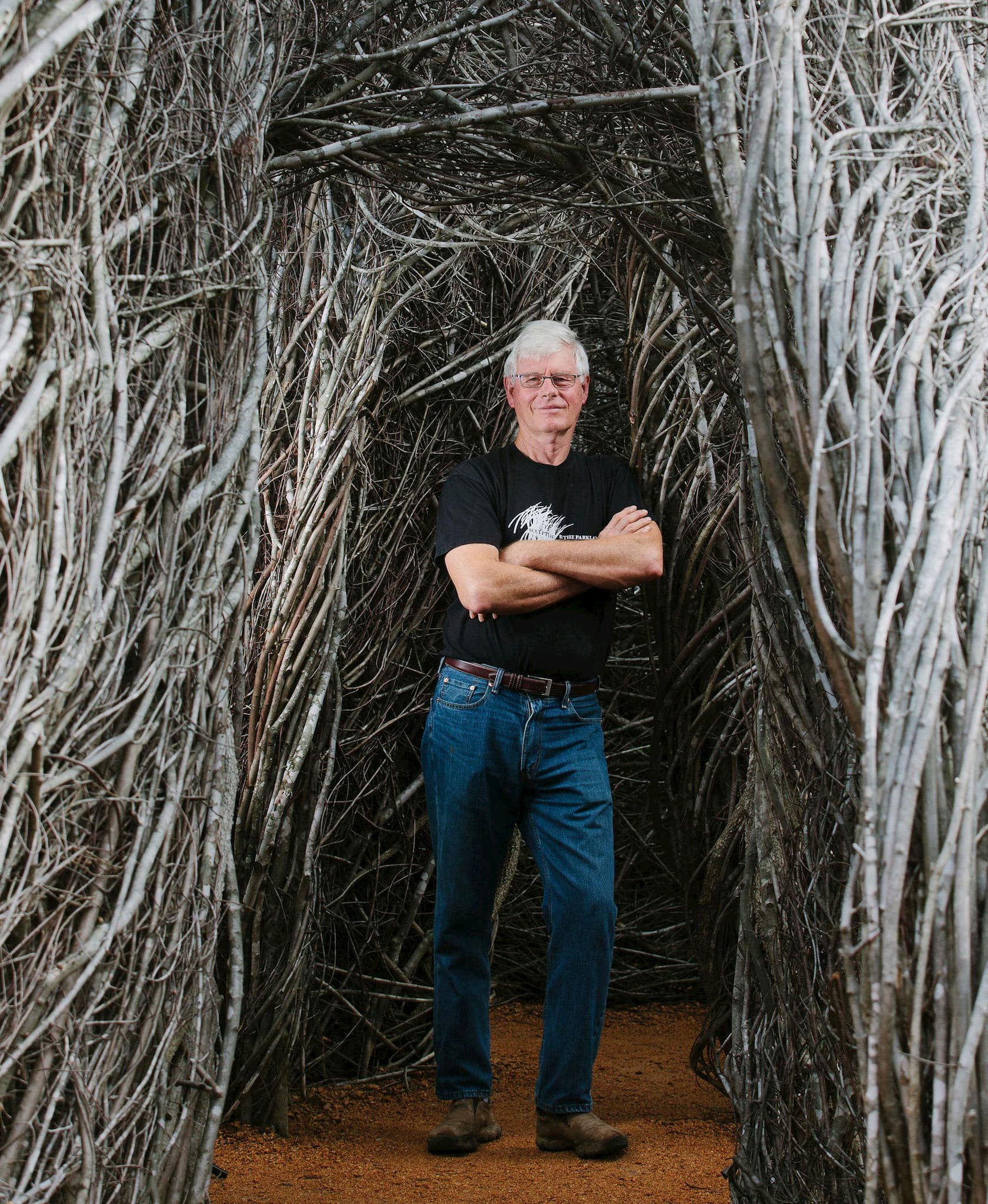
The hour begins in Hillsborough, North Carolina, where Patrick Dougherty, an internationally acclaimed sculptor, makes his home. Throughout his career, he has been committed to environmental issues with a focus on the ways in which art touches and involves the community. His whirling, enchanting architectural “stickworks” are created from saplings, twigs, and branches that are left outdoors to be reclaimed and recycled by nature. “I say of my work that I make large scale temporary sculptures from materials gathered in the nearby landscape.” Like a barn-raising, he invites, relies on and values the many volunteers who assist in harvesting the saplings and building each site-specific piece. His creations stimulate the imagination and invite people to explore. They are meant to be experienced from the interior as well as the exterior by people of all ages.
Chief Curator of the Smithsonian American Art Museum, Renwick Gallery (Washington DC) Nicholas Bell, takes us on a walkthrough of Shindig, Dougherty’s installation for the Renwick’s recent re-opening exhibition Wonder.
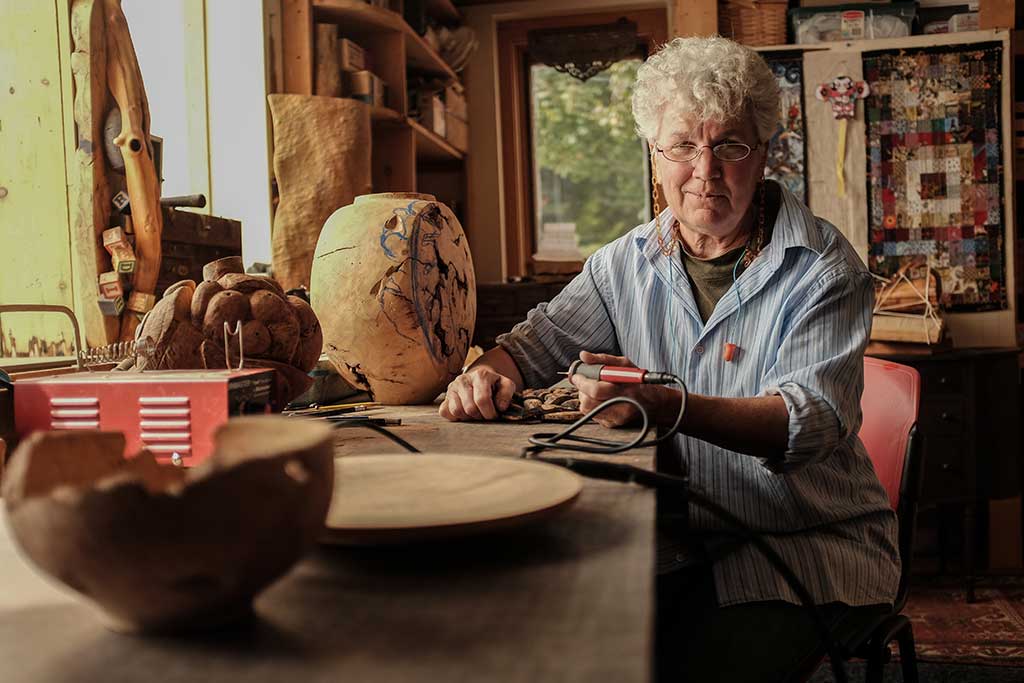
Rural Vermont is the homestead of Michelle Holzapfel and her husband, David. Wood is Michelle’s medium and she uses New England’s hardwoods and burls – maple, cherry, ash and butternut – as a way of honoring Mother Nature at her finest. The natural world around her inspires her creations – vessels, bowls, boxes, vases, and fanciful, unusual trompe l’oeil pieces which have brought her international recognition. She explains “I have a very strong feeling for basically everything that grows, but I’m most in awe of trees. I refer to them as the quintessential material. Well, it’s wood, to begin with, they contain fire, they transpire air, they transform water into water vapor and they’re rooted in the earth, so they really embody the five elements. And I think that’s why I find them so endlessly inspiring”.
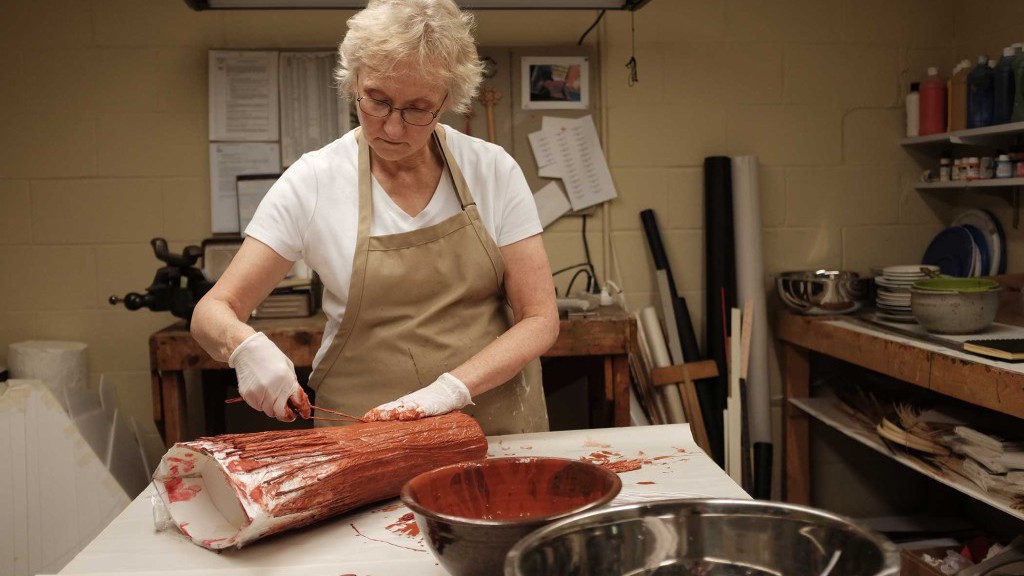
Mary Merkel-Hess makes her home in the tallgrass prairie of Iowa which she says, “speaks to me in a very deep way”. She is an Iowa-born artist who fashions basket-like forms inspired from the spare natural beauty of her beloved Midwest, forms that reference the abundance and bounty in nature and life. But she is not a basket maker, rather a sculptor working in paper, reed and paint to create “Landscape Reports”, fiber vessels that impart to the viewer a sense of place and containment. “One of the things I try to do in my work is to translate my experience of this environment for other people to enjoy and understand.” The source of her creativity, the Iowa landscape, is dominated by vast billowing fields of grass and corn. She says, “We almost entirely lost the prairie environment, and now with great struggle, we’re trying to bring it back… I think the prairie helps underpin everything that I make. And I like living here.”

Native American glass artist of Tlingit heritage, Preston Singletary is surrounded by the wild natural beauty of the Pacific Northwest Coast. He is internationally recognized for his exceptional technique which captures the motion and magnificence of wild creatures in molten glass, then embellishes the cooled and hardened sculptures with symbols and designs from Tlingit culture. He is a pioneer, one of only a handful of Native American artists working in glass today. He explains as he works in his Seattle, WA studio, “When I began working with glass, I had no idea that I’d be so connected to the material in the way that I am. It was only when I began to experiment with using designs from the Tlingit cultural heritage that my work took on a new purpose and direction.” We capture him creating his newest body of work, “Raven and the Box of Daylight” the Tlingit creation myth in which the raven brought the sun, moon and stars to the world.
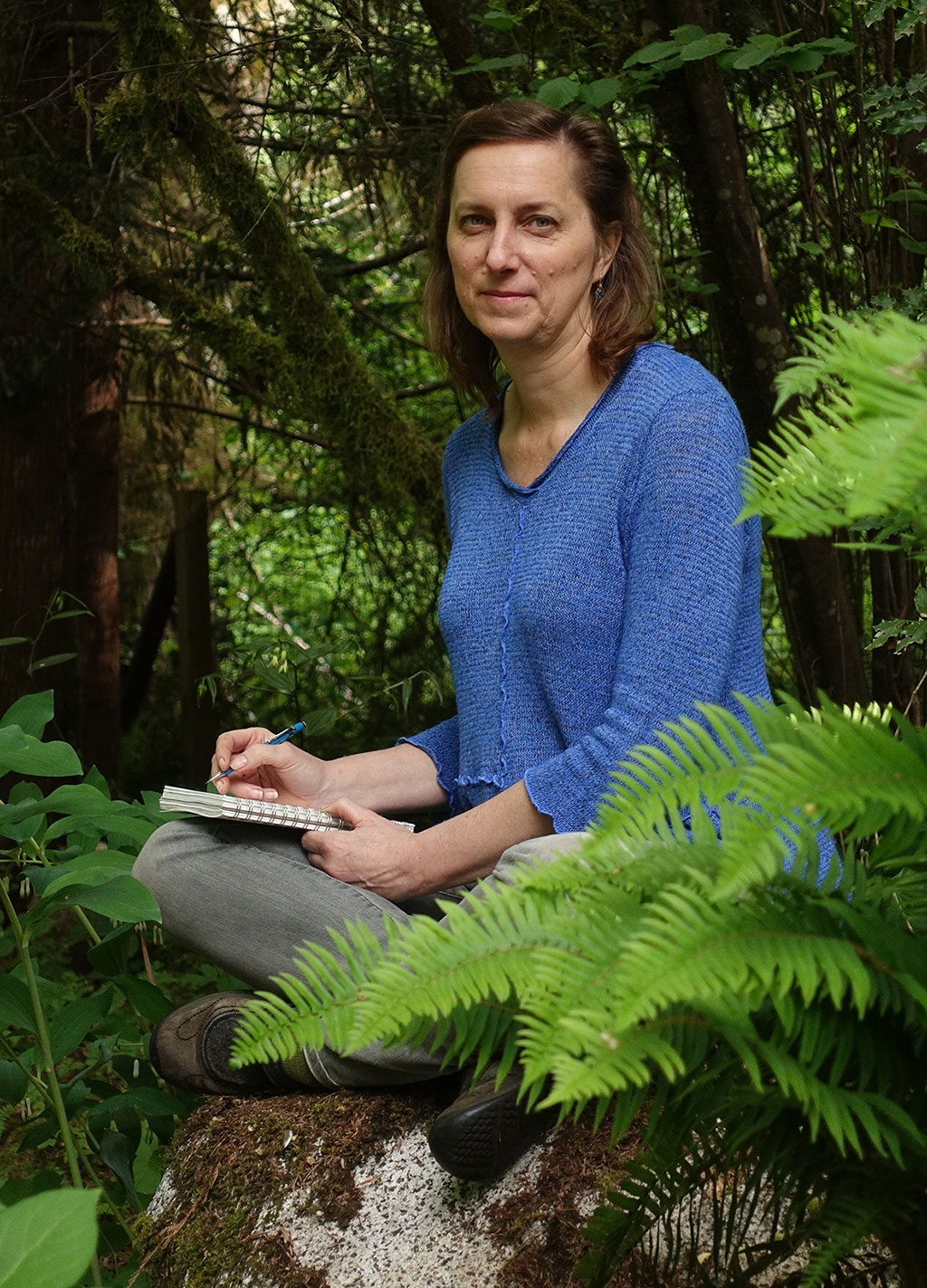
In Shelton, WA, Catherine Alice Michaelis designs books that reflect her relationship with what she calls “Mother Earth, my mystical companion”. Often her books start with original poems which are printed on a vintage letterpress printer on paper that she has already “pressure printed” with flowers and leaves. These unique books created through her own May Day Press are tactile, elegant, thoughtful, sensual and entirely handmade from the growing of the plants and flowers used in the paper design, to the printing of the images and text, to the hand-folding of the pages, to the sewing of the spine. Each book is a new vision of nature as seen through her eyes, an imaginatively designed, remarkable folded paper sculpture.
_____
Craft in America: MUSIC features fine instrument makers and world renowned musicians, including Joan Baez with her Martin guitar, Jake Shimabukuro playing his Kamaka ukulele, trumpet maker Dave Monette and leader of the Count Basie Orchestra Scotty Barnhart, Tony Ellis and Stelling Banjos, musician Rhiannon Giddens with minstrel banjo maker Jim Hartel, and Joe Pereira, timpanist of the Los Angeles Philharmonic, with mallet maker Jason Ginter.
_____
Nature: Highlights from the Episode gathers together the work of the artists who are featured in the episode. These artists explore the beauty and wonder of the natural world. This exhibition opens March 18, 2017 and runs until May 13, 2017 at the Craft in America Center (8415 W. Third St. Los Angeles, CA 90048).
####
CRAFT IN AMERICA is a non-profit organization dedicated to advancing original handcrafted work through the Peabody Award-winning documentary series on PBS nationwide and the free-to-the-public Craft in America Center located in Los Angeles, which offers artist talks, exhibitions, workshops and a library. With seventeen episodes produced since 2007, CRAFT IN AMERICA takes viewers on a journey to the artists, origins and techniques of American craft. Each episode contains stories from diverse regions and cultures, blending history with living practice and exploring issues of identity, ritual, philosophy and creative expression. Our websites craftinamerica.org and pbs.org/craftinamerica provide all episodes, hours of online videos and interactive learning materials, as well as object exhibitions, artist information, the Random House book Craft in America: Celebrating Two Centuries of Artists and Objects, and other Craft in America publications.
For more about Craft in America:
craftinamerica.org
pbs.org/craftinamerica
facebook.com/craftinamerica
youtube.com/craftinamerica
instagram.com/craftinamerica
twitter.com/CraftinAmerica
Photos courtesy of Mark Markley, Michelle Holzapfel, Brianna Brough/Chapel Hill Magazine, Russell Johnson.
To view the Artist Bios: www.craftinamerica.org/press/craftinamerica-nature-artistbios
Please contact for art and interviews: (310) 659-9022
Lauren Over, Communications: press@craftinamerica.org
Additional images of all the artists’ work are available on Dropbox (74 MB): dl.dropboxusercontent.com/u/21500868/NATUREpress.zip